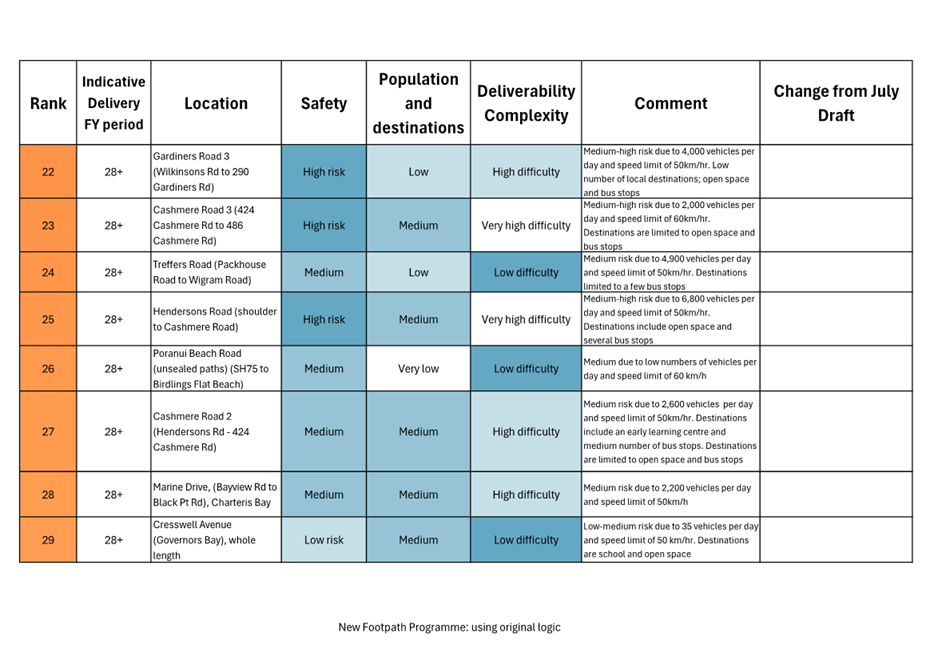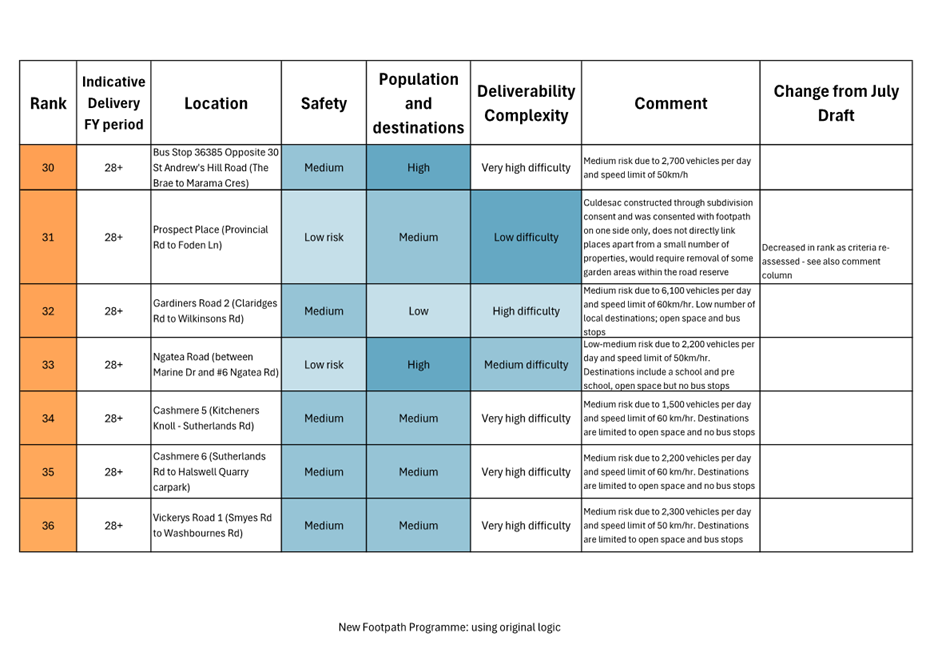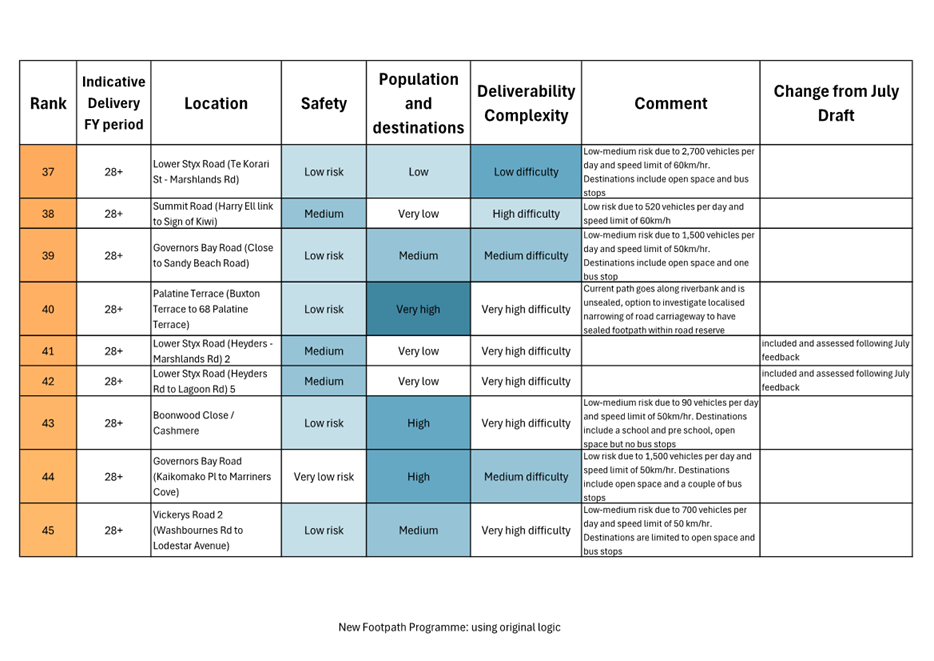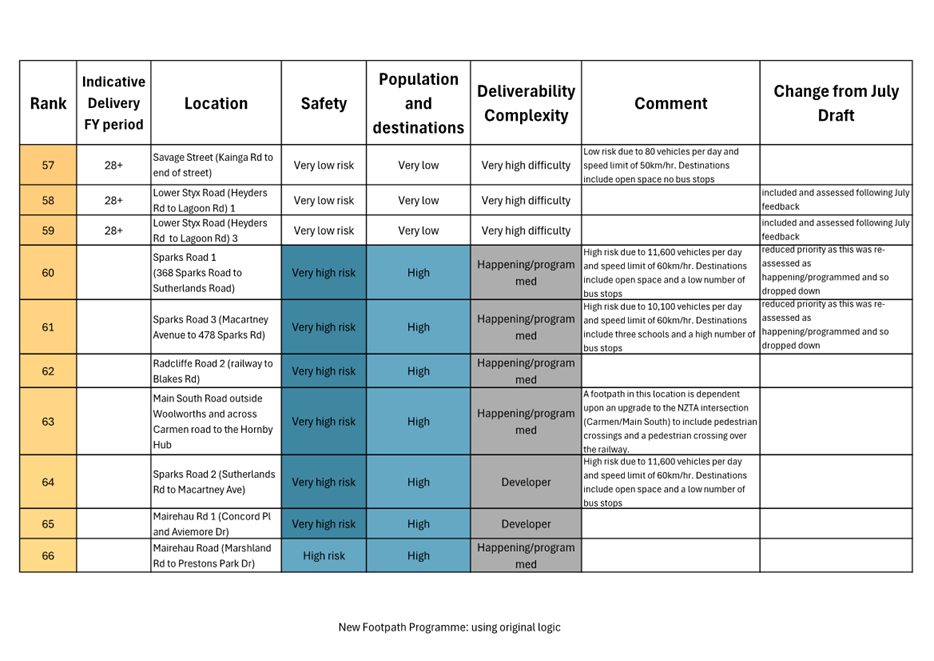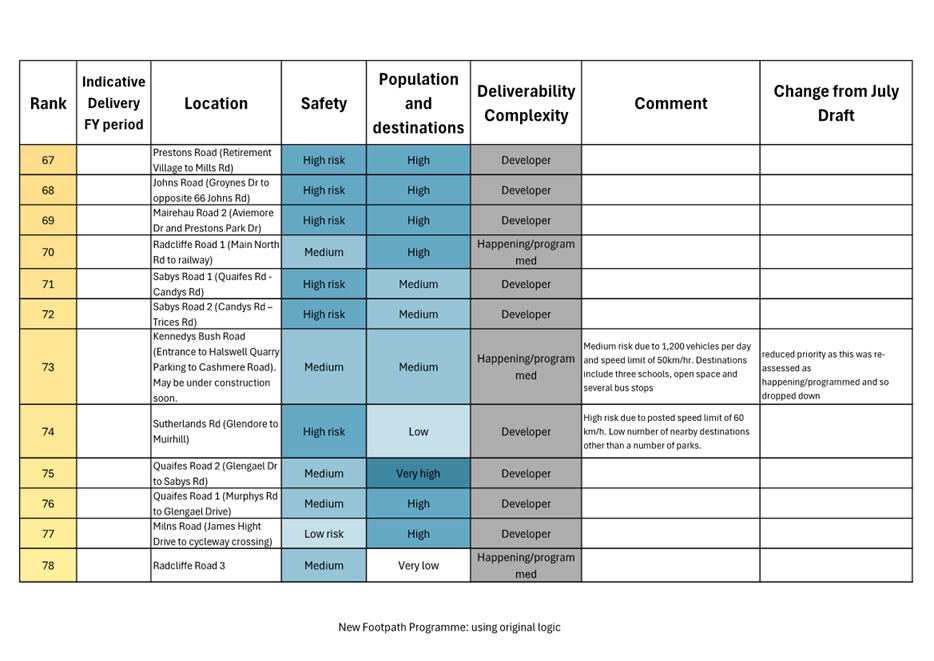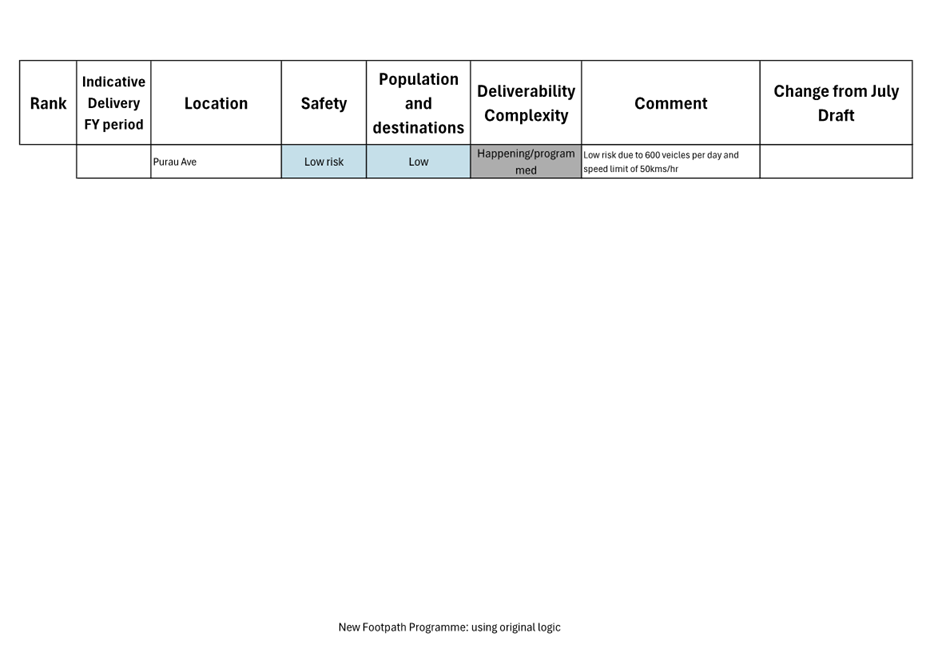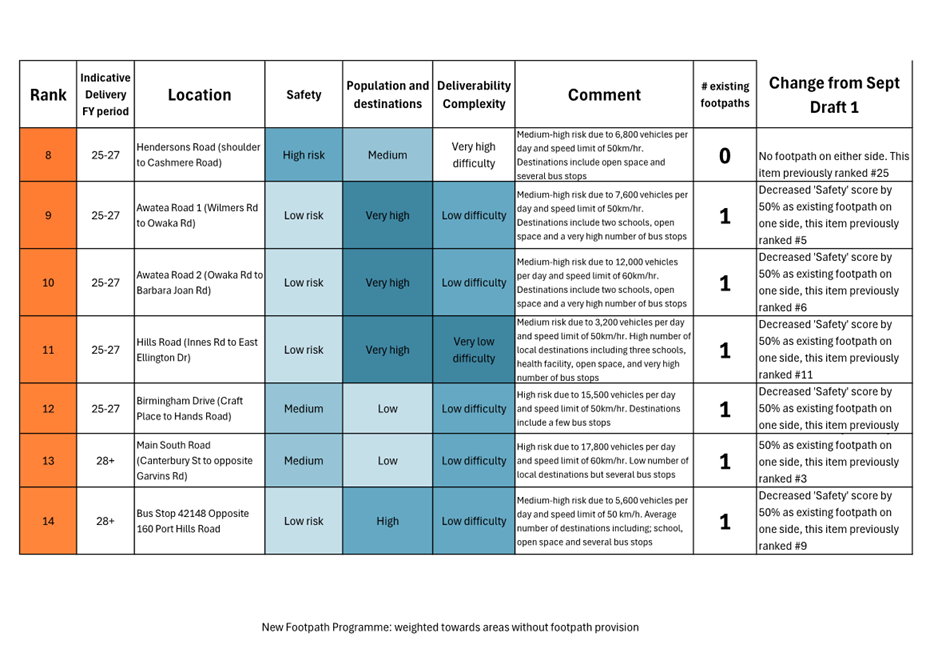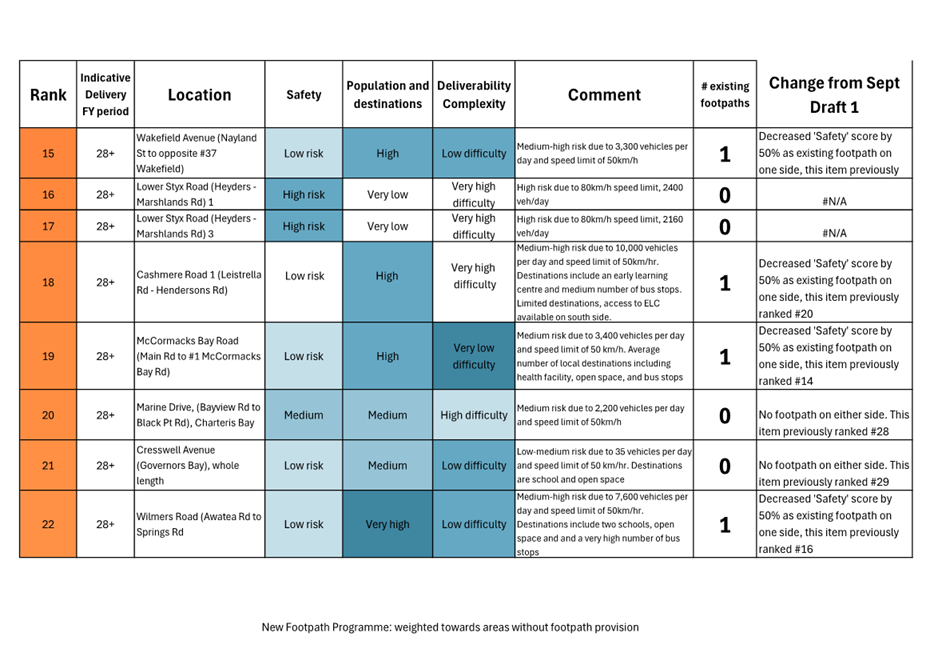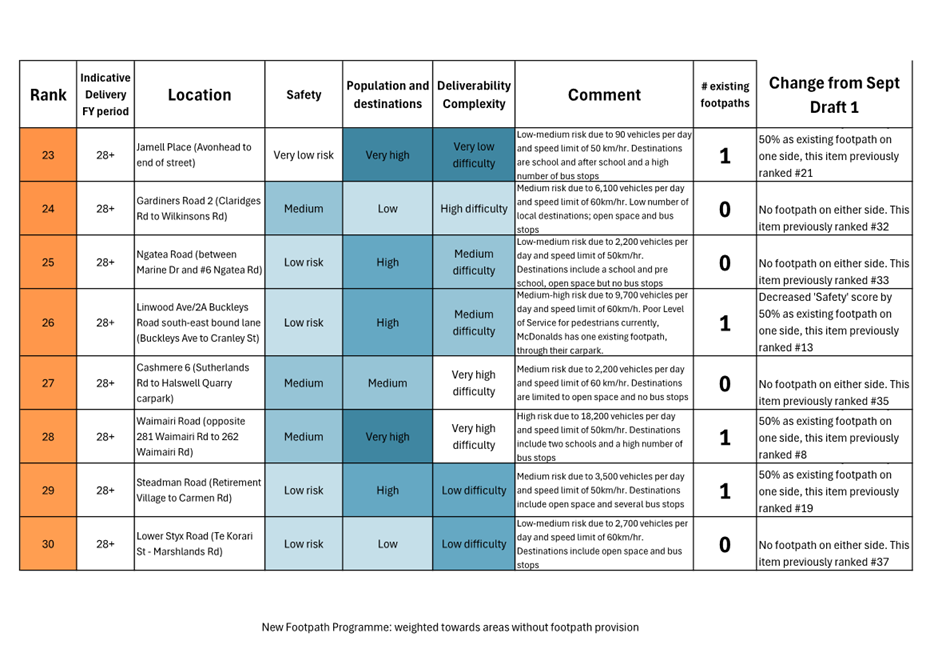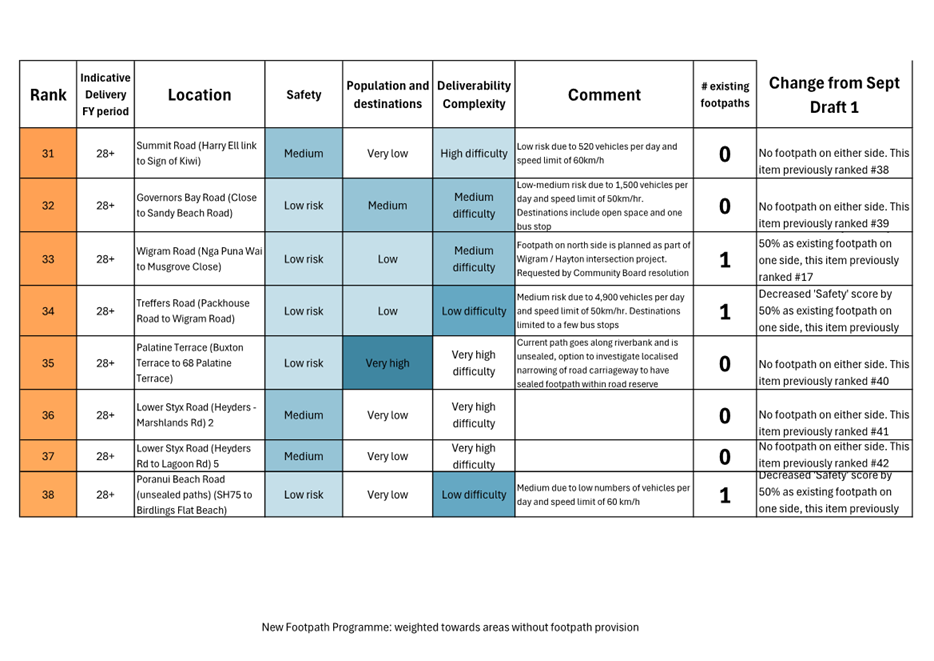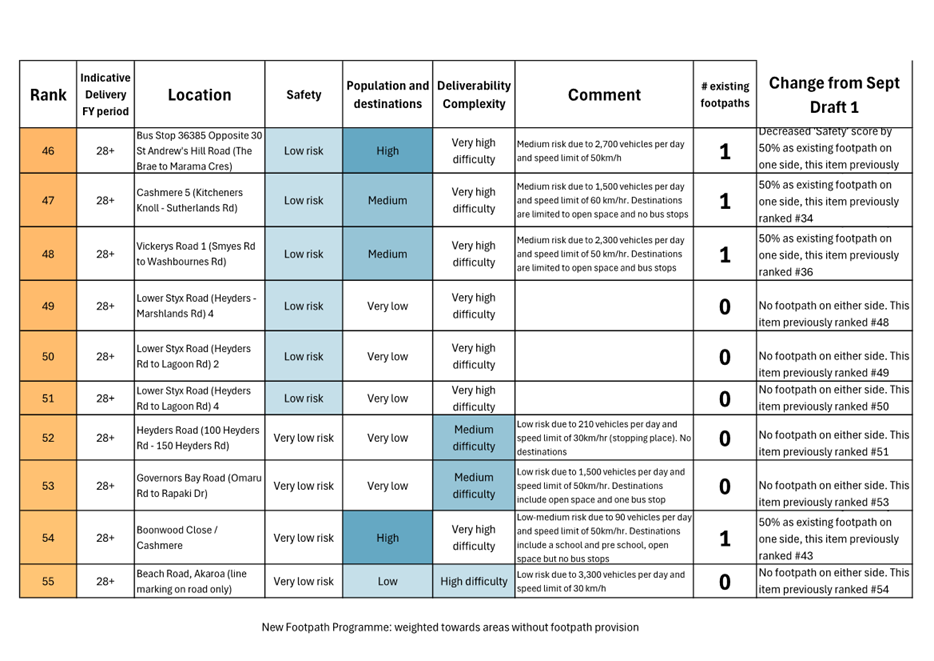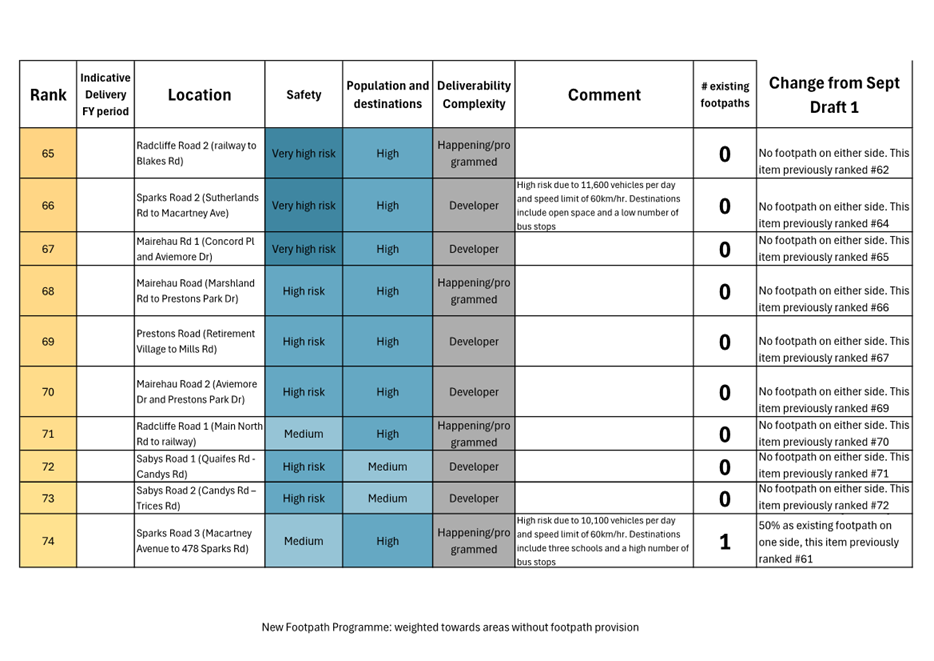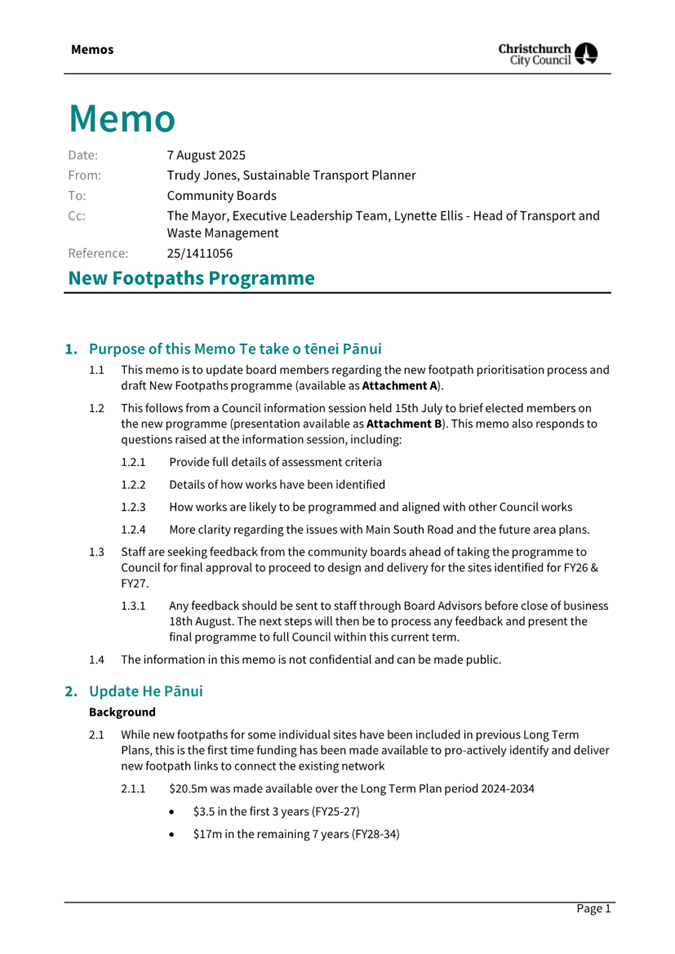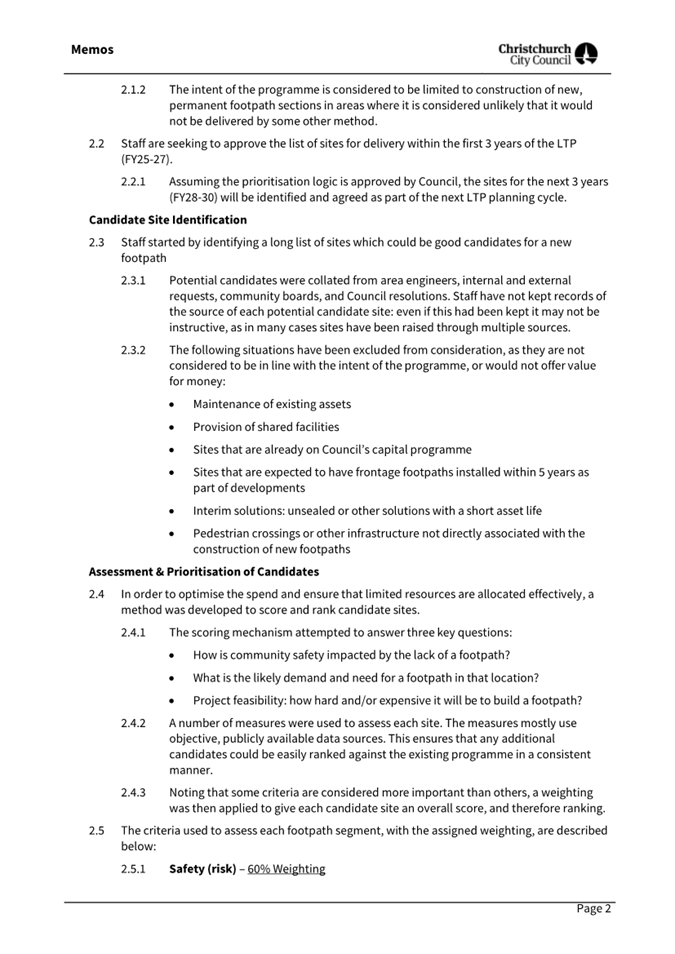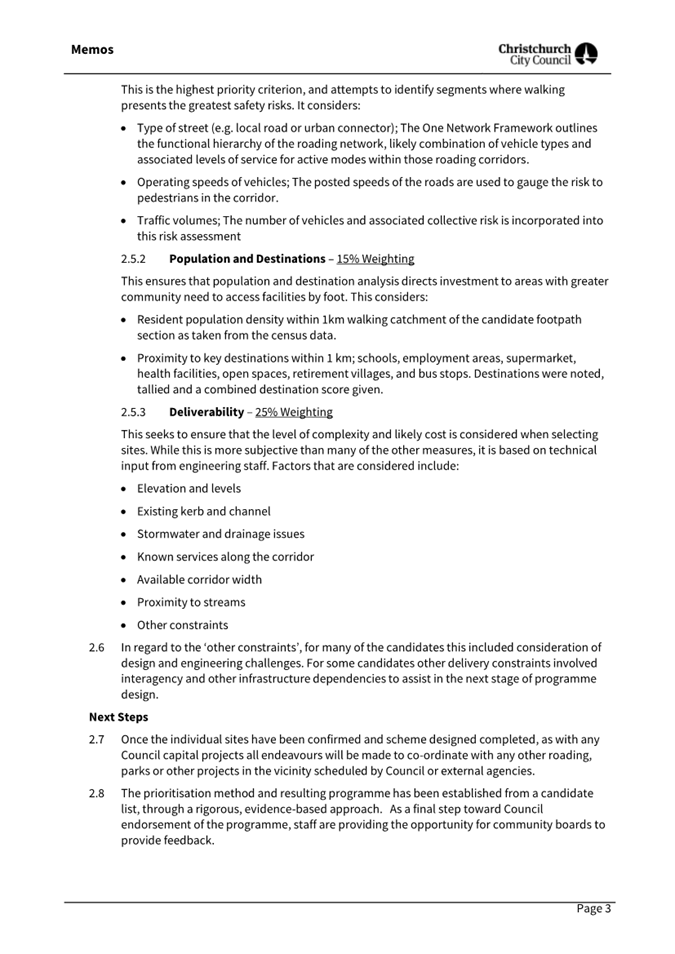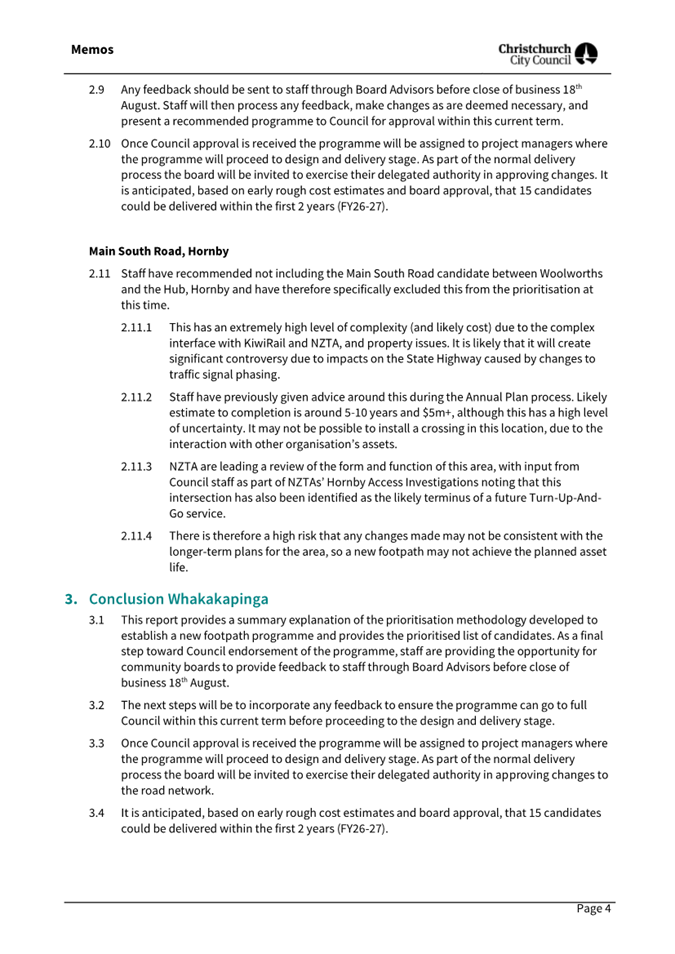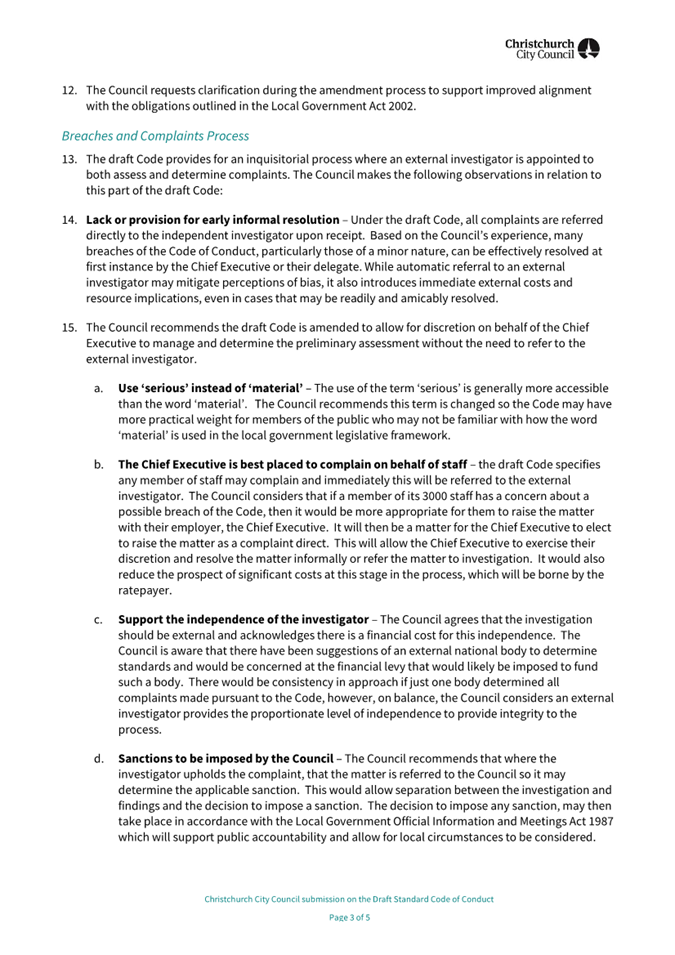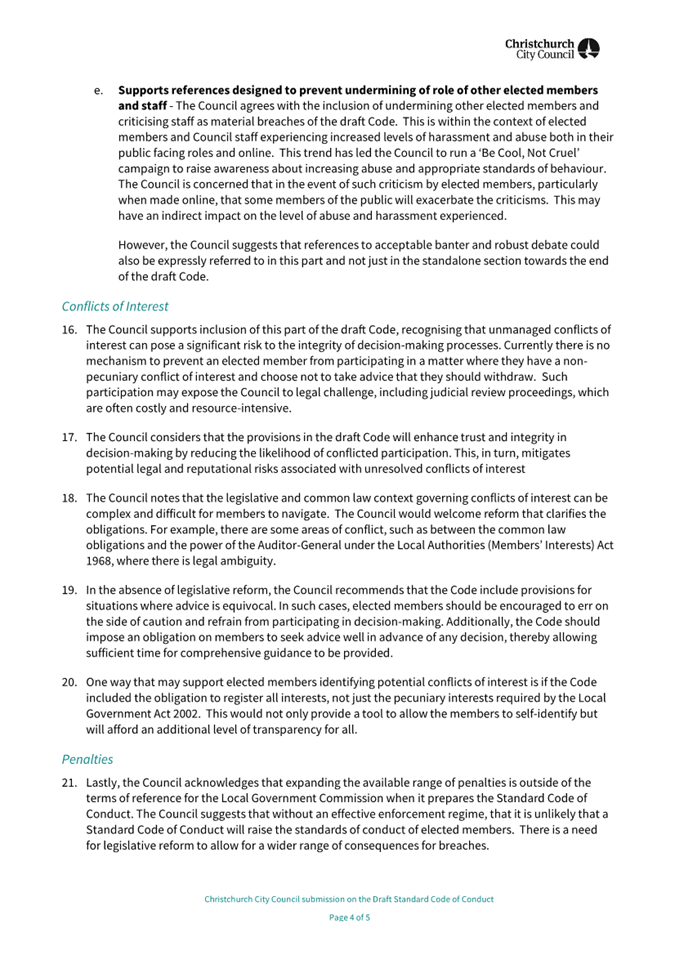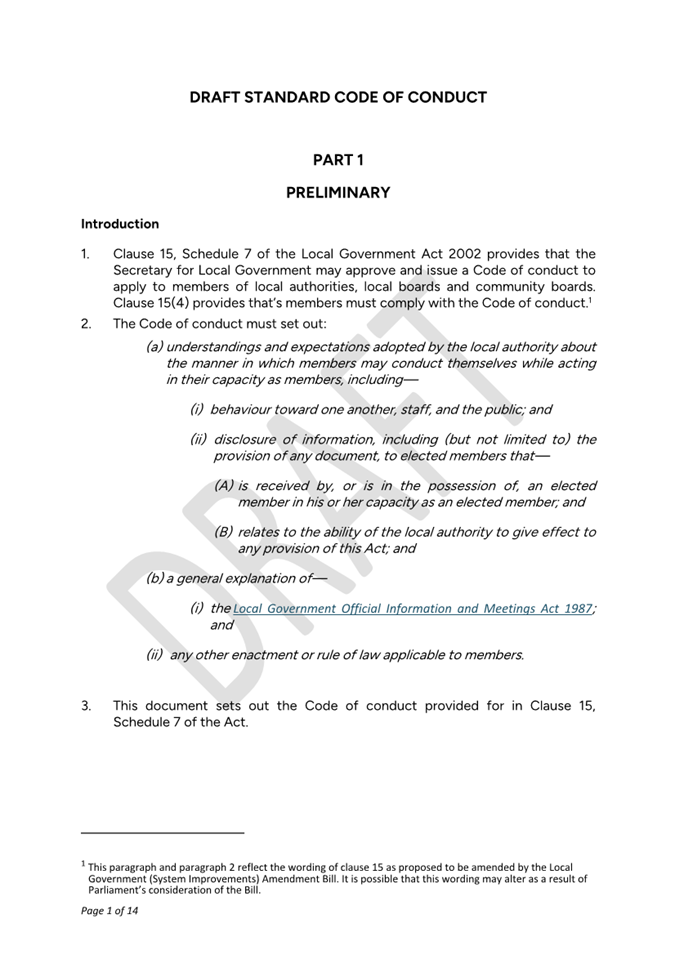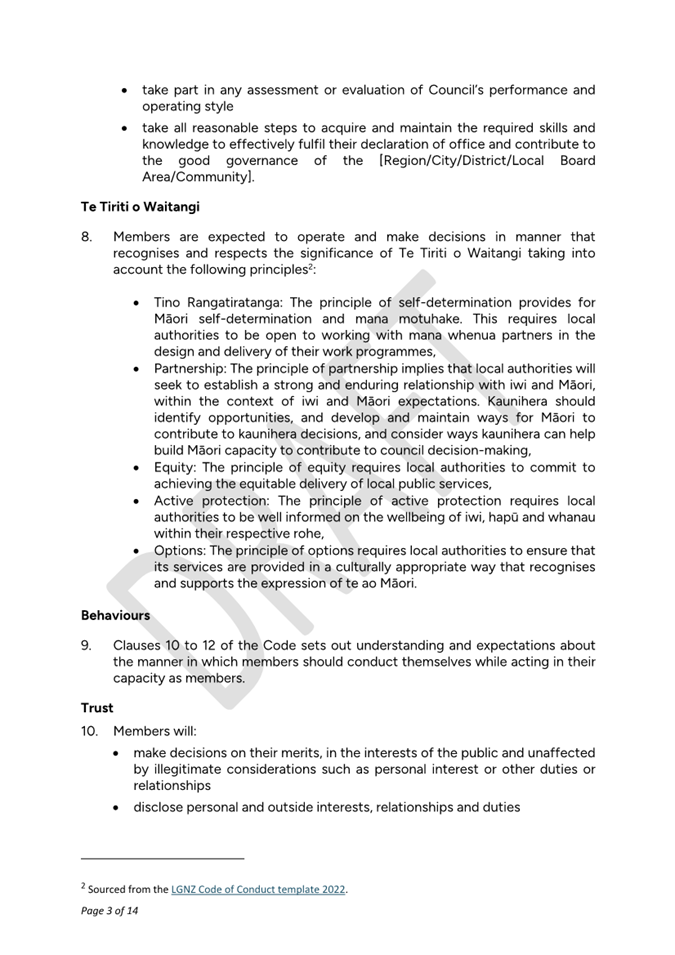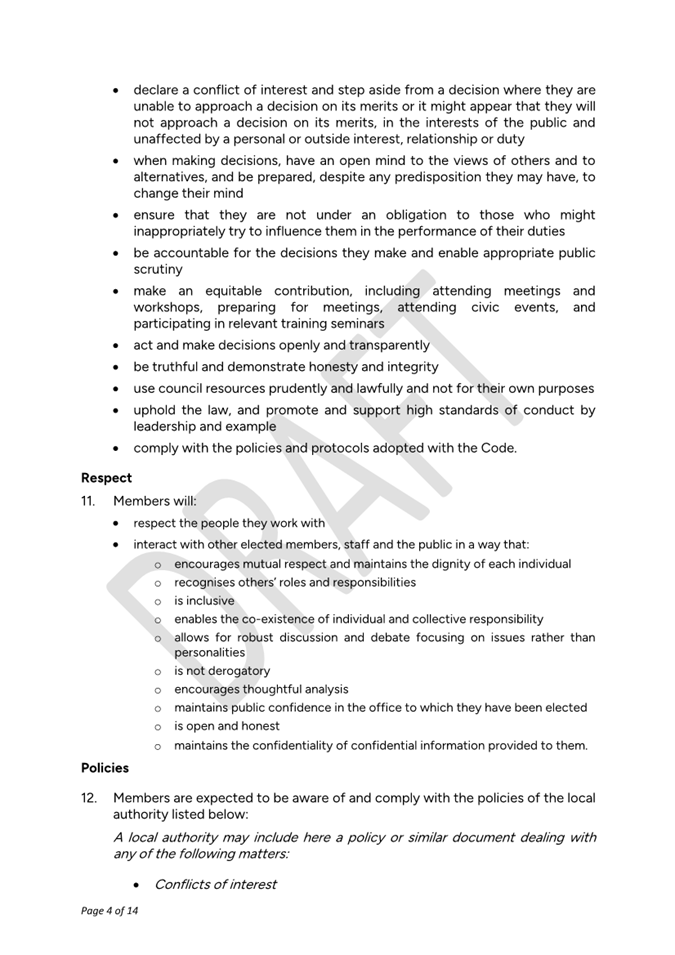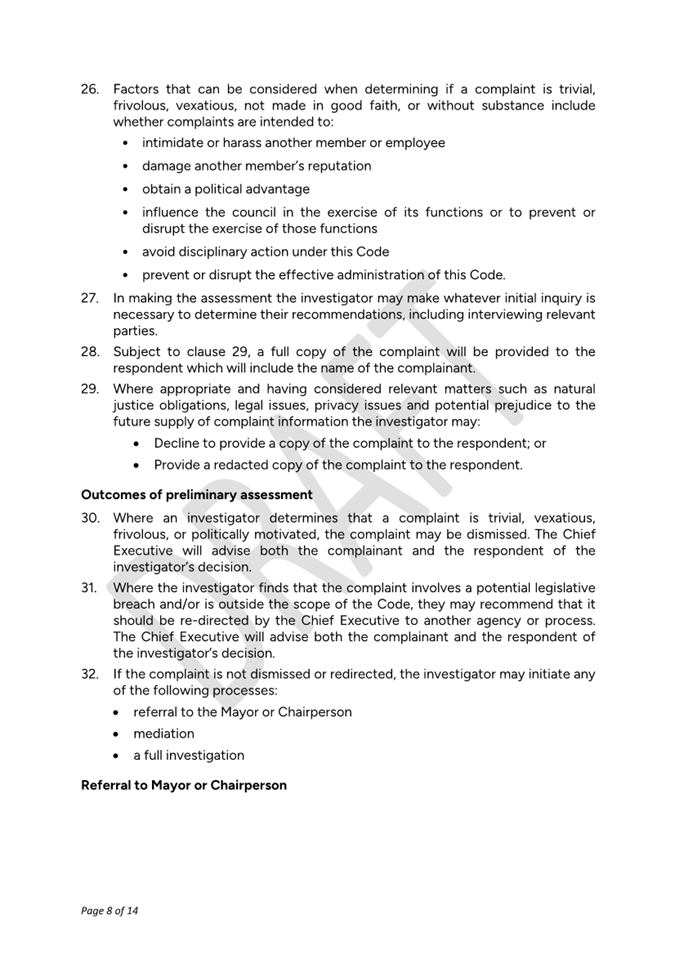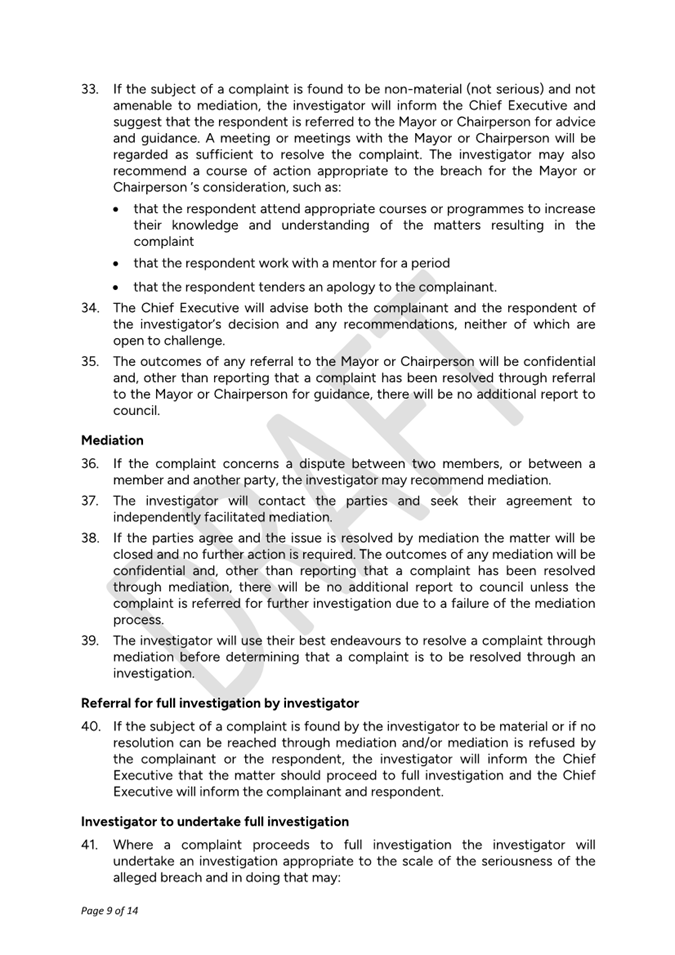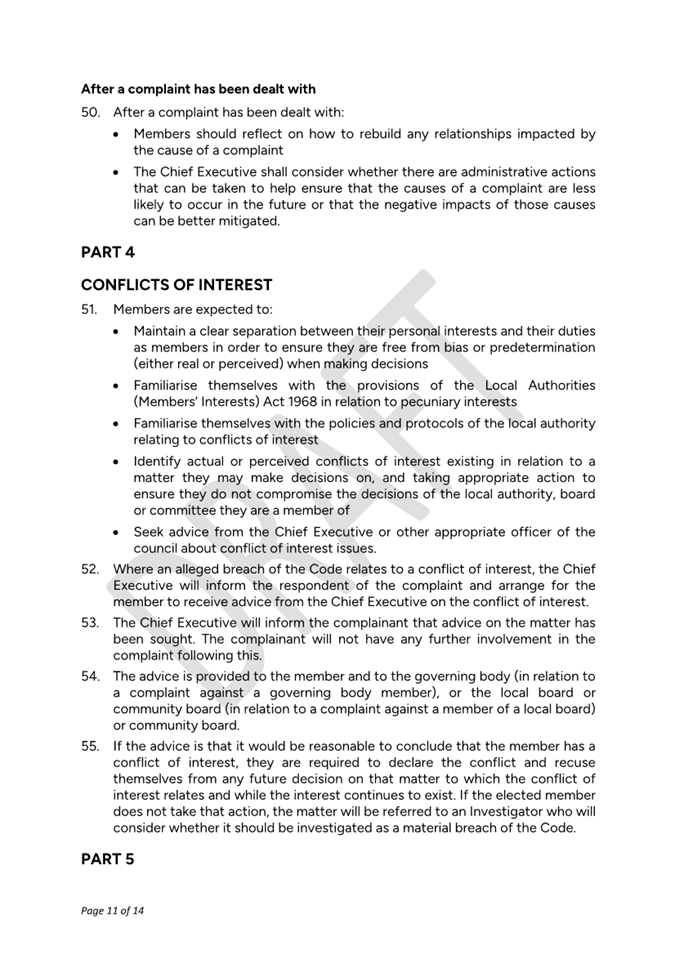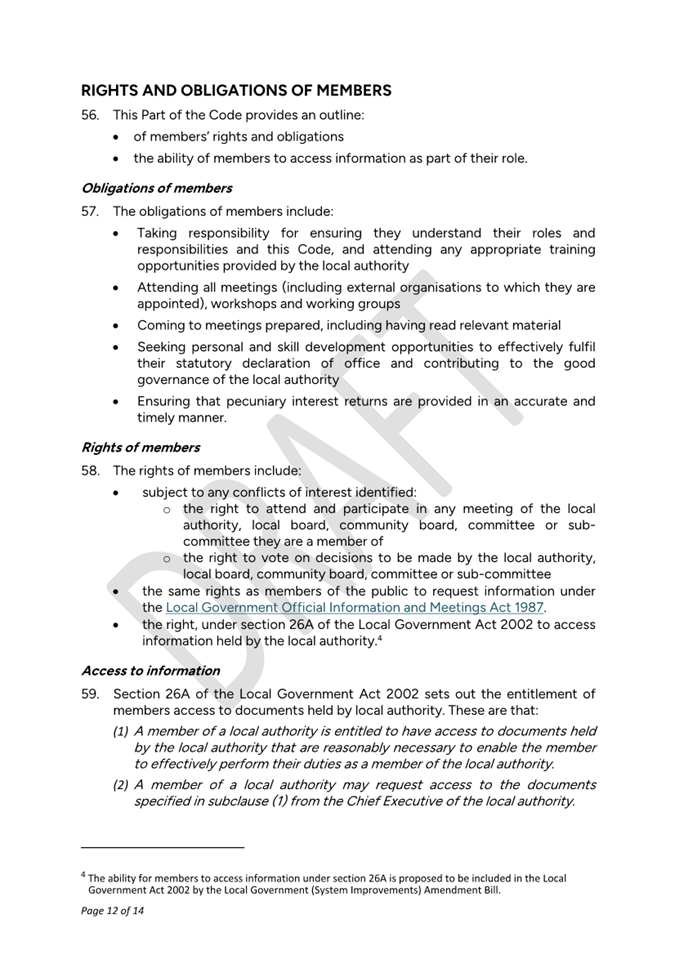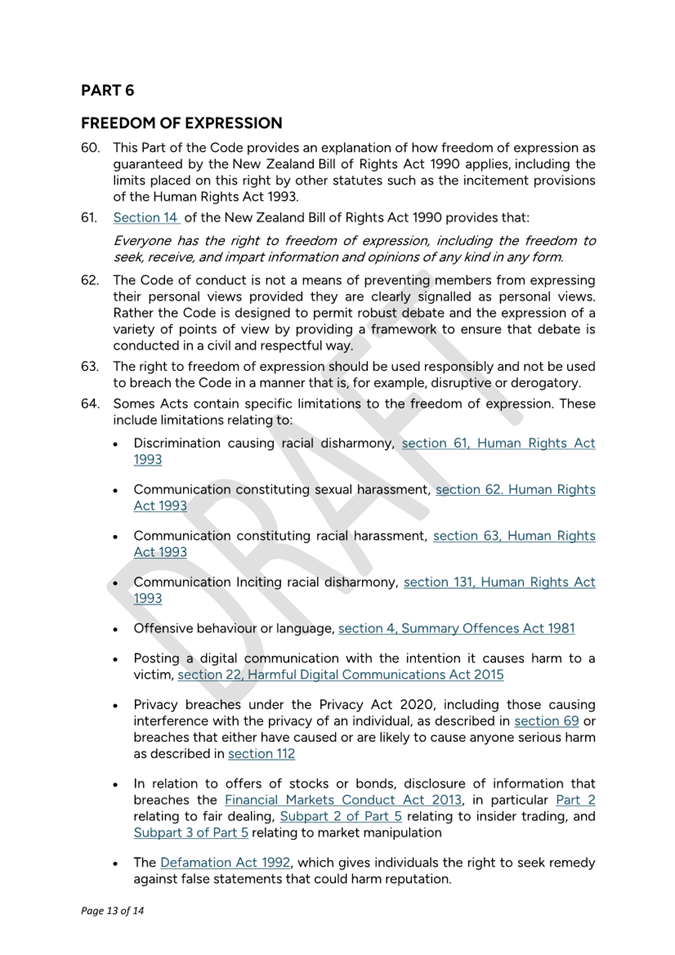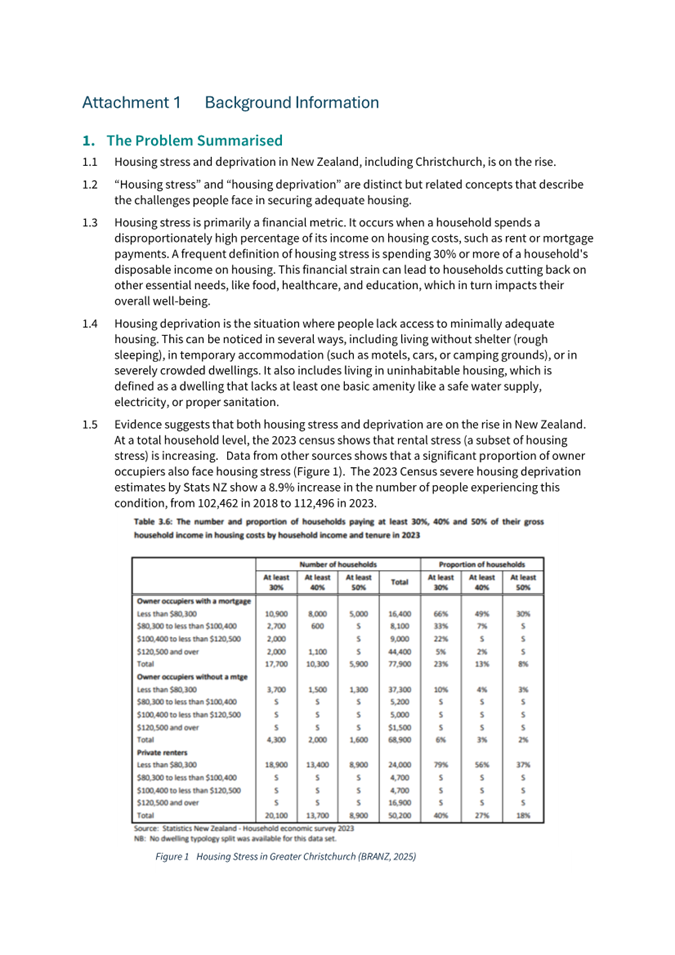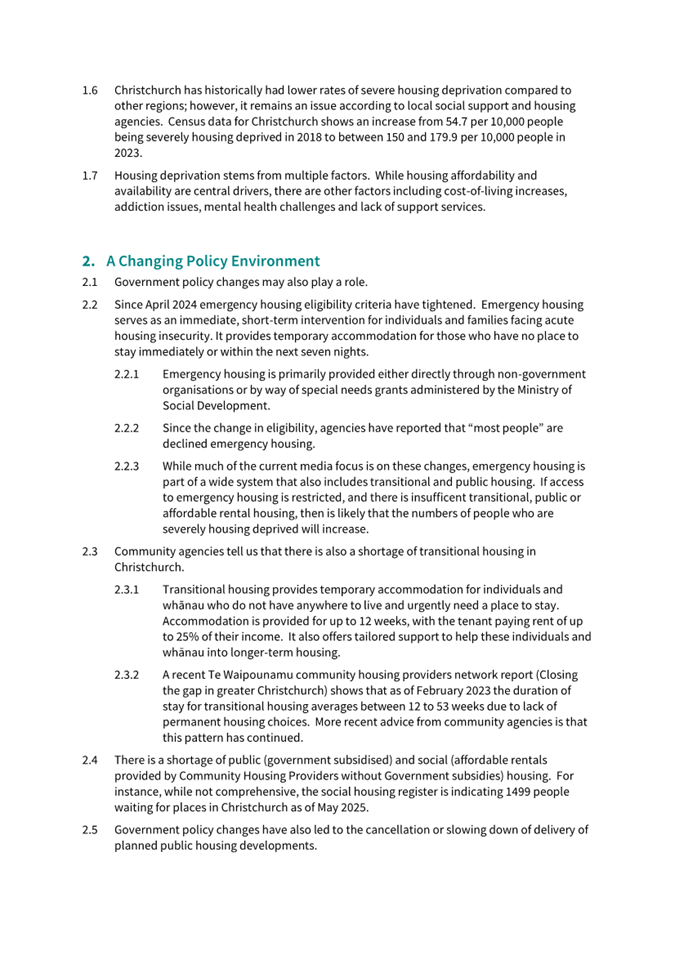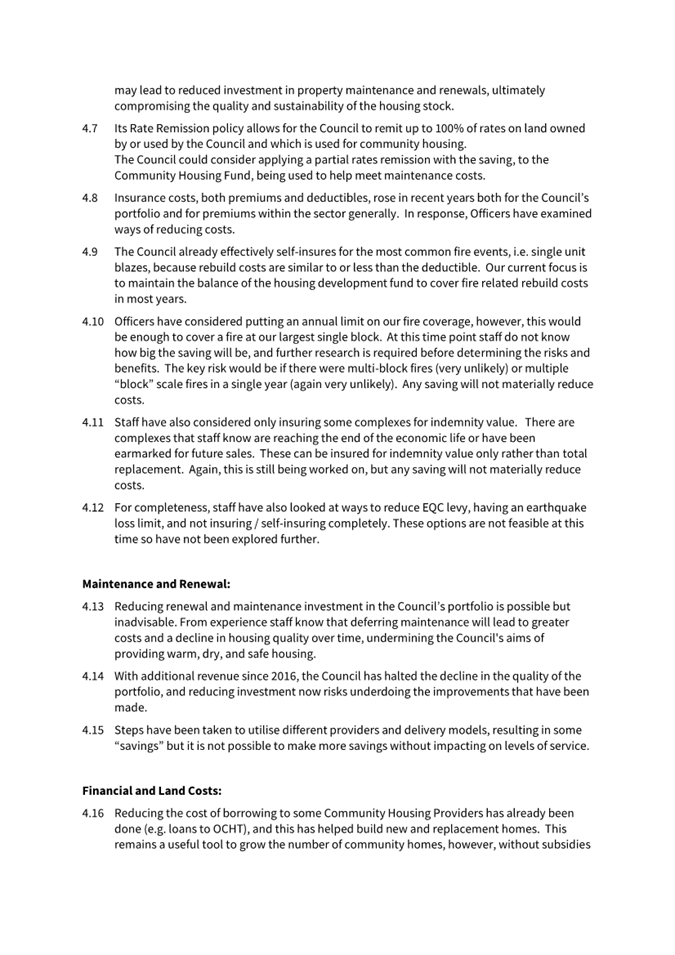
Christchurch City Council
Agenda
Notice of Meeting Te Pānui o te Hui:
An ordinary meeting of the Christchurch
City Council will be held on:
Date: Wednesday 17 September 2025
Time: 9.30 am
Venue: Camellia Chambers, Level 2, Civic Offices,
53 Hereford Street
Please note that
while we will try to accommodate all those who wish to attend the meeting in
person, there is limited capacity in the Camellia Chambers, and priority will
be given to those who are presenting to the Council.
Membership
|
Chairperson
Deputy Chairperson
Members
|
Mayor Phil Mauger
Deputy Mayor Pauline Cotter
Councillor Kelly Barber
Councillor Melanie Coker
Councillor Celeste Donovan
Councillor Tyrone Fields
Councillor James Gough
Councillor Tyla Harrison-Hunt
Councillor Victoria Henstock
Councillor Yani Johanson
Councillor Aaron Keown
Councillor Sam MacDonald
Councillor Jake McLellan
Councillor Andrei Moore
Councillor Mark Peters
Councillor Tim Scandrett
Councillor Sara Templeton
|
11 September 2025
Website: www.ccc.govt.nz


TABLE OF CONTENTS NGĀ IHIRANGI
Karakia Tīmatanga................................................................................................... 4
1. Apologies Ngā Whakapāha................................................................................. 4
2. Declarations of Interest Ngā Whakapuaki Aronga.................................................. 4
3. Public
Participation Te Huinga
Tūmatanui............................................................ 4
3.1 Public Forum Te Huinga Whānui.......................................................................................... 4
3.2 Deputations by
Appointment Ngā Huinga Whakaritenga...................................................... 4
4. Presentation
of Petitions Ngā
Pākikitanga............................................................ 4
Council
5. Council
Minutes - 3 September 2025.................................................................... 6
Staff Reports
6. Valedictory
- Councillor Gough.......................................................................... 31
7. New
Footpaths Programme.............................................................................. 32
8. Welles
Street Temporary Improvements............................................................. 66
9. Decision
on Plan Change 13 - Heritage................................................................ 88
10. Governance
Matters......................................................................................... 96
11. Amendments
to the Register of Delegations...................................................... 103
12. Council
submission: Local Government Commission - Standardised Code of Conduct 109
13. Council
submissions process during the 2025 local elections................................ 134
14. Advice on
Support for Emergency and Community Housing................................. 138
15. Resolution
to Exclude the Public...................................................................... 154
Karakia Whakamutunga
Karakia Tīmatanga
Whakataka te hau ki te uru
Whakataka te hau ki te tonga
Kia mākinakina ki uta
Kia mātaratara ki tai
E hī ake ana te atakura
He tio, he huka, he hau hū
Tihei mauri ora
1. Apologies Ngā Whakapāha
Apologies will
be recorded at the meeting.
2. Declarations of Interest Ngā
Whakapuaki Aronga
Members are
reminded of the need to be vigilant and to stand aside from decision-making
when a conflict arises between their role as an elected representative and any
private or other external interest they might have.
3. Public Participation Te Huinga
Tūmatanui
3.1 Public Forum Te Huinga Whānui
A period of up to 30 minutes is available
for people to speak for up to five minutes on any issue that is not the subject
of a separate hearings process.
Public Forum presentations will be
recorded in the meeting minutes.
3.2 Deputations by Appointment Ngā
Huinga Whakaritenga
Deputations may be heard on a matter, or
matters, covered by a report on this agenda and approved by the Chairperson.
|
3.2.1
|
Tony Chaston
Tony Chaston will speak regarding Item 7–
New Footpaths Programme.
|
|
3.2.2
|
Waipuna Halswell – Hornby – Riccarton Community Board
Chairperson Marie Pollisco will speak on
behalf of the Waipuna Halswell – Hornby – Riccarton Community
Board regarding Item 7– New Footpaths Programme.
|
|
3.2.3
|
Cody Cooper
Cody Cooper will speak regarding Item 7–
New Footpaths Programme.
|
4. Presentation of Petitions Ngā
Pākikitanga
There were no
Presentations of Petitions at the time the agenda was prepared.
To present to the Council, refer
to the Participating in decision-making webpage or
contact the meeting advisor listed on the front of this agenda.
|
5. Council
Minutes - 3 September 2025
|
|
Reference Te Tohutoro:
|
25/1796621
|
|
Responsible Officer(s) Te Pou Matua:
|
Katie
Matheis, Senior Democratic Services Advisor
|
|
Accountable ELT Member Pouwhakarae:
|
Mary
Richardson, Chief Executive
|
1. Purpose of Report Te
Pūtake Pūrongo
For the Council
to confirm the minutes from the Council meeting held 3
September 2025.
2. Recommendation Te Tūtohu Council
That the Council confirms the Minutes from the Council
meeting held 3 September 2025.
Attachments Ngā Tāpirihanga
|
No.
|
Title
|
Reference
|
Page
|
|
A⇩
|
Minutes Council - 3 September 2025
|
25/1761311
|
7
|
Signatories Ngā Kaiwaitohu
|
Author
|
Katie Matheis
- Senior Democratic Services Advisor
|

Christchurch City Council
Minutes
Date: Wednesday 3 September 2025
Time: 9.31 am
Venue: Camellia Chambers, Level 2, Civic Offices,
53 Hereford Street
Present
|
Chairperson
Deputy Chairperson
Members
|
Mayor Phil Mauger
Deputy Mayor Pauline Cotter
Councillor Kelly Barber
Councillor Melanie Coker
Councillor Celeste Donovan
Councillor Tyrone Fields
Councillor James Gough - via audio/visual
link
Councillor Tyla Harrison-Hunt
Councillor Victoria Henstock
Councillor Yani Johanson
Councillor Aaron Keown – via
audio/visual link
Councillor Sam MacDonald
Councillor Jake McLellan
Councillor Andrei Moore
Councillor Mark Peters
Councillor Tim Scandrett
Councillor Sara Templeton
|

Karakia Tīmatanga
External Recognition – Te Kuru
The Mayor acknowledged the recent IPWEA
Australasia Public Works Awards where Te Kuru was named Project of the Year
2025 and the Best Public Works Project Over $5M.
The agenda was dealt with in the following
order.
1. Apologies Ngā Whakapāha
|
Council Resolved CNCL/2025/00289
That the apologies from Councillor
MacDonald for lateness and potential early departure and from Councillors
Barber, Gough, and Johanson for early departure be accepted.
Mayor/Deputy
Mayor Carried
|
2. Declarations of Interest Ngā Whakapuaki Aronga
Councillor Gough declared an interest in Item 13 - Plan
Change 14 Decision (in-part) and Proposed Withdrawal.
Councillor Donovan joined the meeting at
9.34 am during the Mayor’s acknowledgment of Te Kuru.
Councillor Henstock left the meeting at
9.48 am during consideration of Item 12.
Councillor McLellan joined the meeting at
9.51 am during consideration of Item 12.
Councillor MacDonald joined the meeting at
9.55 am during consideration of Item 12.
Councillor McLellan left the meeting at
10.00 am and returned at 10.03 am during consideration of Item 12.
|
12. Monthly Report from the Community Boards - August
2025
|
|
|
Council Comment
1. Before
the start of the Community Board presentations, the Mayor took a moment to
acknowledge the Waipapa Papanui-Innes-Central Community Board Chairperson,
Emma Norrish, and the Waihoro Spreydon-Cashmere-Heathcote Community Board
Chairperson, Callum Ward, who are stepping away from local government this
election cycle. The Mayor commended them for their work, contributions and
commitment to their communities and the Council.
|
|
|
Emma Norrish, Chairperson, and Simon
Britten, Deputy Chairperson, joined the meeting for presentation of the Waipapa Papanui-Innes-Central Community
Board area report.
Marie Pollisco, Chairperson, and Helen
Broughton, Deputy Chairperson, joined the meeting for presentation of the Waipuna Halswell-Hornby-Riccarton
Community Board area
report.
Jackie Simons, Deputy Chairperson, and
Chris Turner-Bullock, Community Governance Manager, joined the meeting for
presentation of the Waitai
Coastal-Burwood-Linwood Community Board area report.
Lyn Leslie, Chairperson, and Penelope
Goldstone, Community Governance Manager, joined the meeting for presentation
of the Te Pātaka o
Rākaihautū Banks Peninsula Community Board area report.
Callum Ward,
Chairperson, Emma Pavey, Community Governance Manager, and Keir Leslie,
Deputy Chairperson (via audio/visual link), joined the meeting for
presentation of the Waihoro
Spreydon-Cashmere-Heathcote Community Board area report.
Jason
Middlemiss, Chairperson, and Maryanne Lomax, Community Governance Manager,
joined the meeting for presentation of the Waimāero Fendalton-Waimairi-Harewood Community
Board area report.
|
|
|
Council Resolved CNCL/2025/00290
Officer Recommendation
accepted without change
That the Council:
1. Receives the information in the Monthly
Report from the Community Boards - August 2025 Report.
Mayor/Councillor
Coker Carried
|
|
|
Attachments
a Waipapa
Papanui-Innes-Central Community Board - Presentation to Council
b Waipuna
Halswell-Hornby-Riccarton Community Board - Presentation to Council
c Waitai
Coastal-Burwood-Linwood Community Board - Presentation to Council
d Te
Pātaka o Rākaihautū Banks Peninsula Community Board -
Presentation to Council
e Waihoro
Spreydon-Cashmere-Heathcote Community Board - Presentation to Council
f Waimāero
Fendalton-Waimairi-Harewood Community Board - Presentation to
Council
|
Councillor Henstock returned to the meeting
at 10.16 am during consideration of Item 3.1.1.
3. Public
Participation Te Huinga
Tūmatanui
3.1 Public Forum Te Huinga
Whānui
|
3.1.1
|
Wigram Halswell Rugby Club
Sam Joyce,
Paul Hammond, and Tony Smail spoke on behalf of the Wigram Halswell Rugby
Club regarding the conditions of the Rugby Club home grounds.
|
|
|
|
3.1.2 Rebecca Robin
|
|
Rebecca Robin spoke
regarding homelessness in the Red Zone.
|
|
Attachments
a Rebecca
Robin - Presentation to Council
|
Councillor Barber left the meeting at 10.31
am during consideration of Item 3.2.1 and did not return.
3.2 Deputations by Appointment Ngā Huinga Whakaritenga
|
3.2.1
|
Christchurch Water Crematorium
Deborah
Richards spoke on behalf of the Christchurch Water Crematorium regarding Item
14 – Amendment to the Cemeteries Handbook (ashes).
|
|
|
Councillor Henstock left the meeting at
10.33 am and returned at 10.36 am during consideration of Item 3.2.2.
Councillor Johanson left the meeting at
10.34 am during consideration of Item 3.2.2 and did not return.
|
3.2.2 Combined Residents' Associations -
Christchurch
|
|
Tony Simons spoke on
behalf of the Combined Residents' Associations regarding Item 13 - Plan
Change 14 Decision and Proposed Withdrawal.
|
|
|
Councillor Donovan left the meeting at
10.42 am and returned at 10.45 am during consideration of Item 3.2.3.
|
3.2.3 Helen Broughton
|
|
Helen Broughton spoke
on behalf of the Waitai Coastal Burwood Linwood Community Board regarding
Item 13 - Plan Change 14 Decision and Proposed Withdrawal.
|
|
|
|
3.2.4 Luke Chandler
|
|
Luke Chandler spoke in his capacity as
an individual regarding Item 13 - Plan Change 14 Decision and Proposed
Withdrawal.
|
4. Presentation of Petitions Ngā Pākikitanga
There
was no presentation of petitions.
|
5. Council Minutes - 5 August 2025
|
|
Council Comment
1. The
meeting block resolved Open Minutes Items 5 through 11 and Public Excluded
Minutes Items 22 through 26.
|
|
|
Council Resolved CNCL/2025/00291
That the Council confirms the Minutes
from the Council meeting held 5 August 2025.
Mayor/Councillor
Templeton Carried
|
|
6. Council Minutes - 6 August 2025
|
|
|
Council Resolved CNCL/2025/00292
That the Council confirms the Minutes
from the Council meeting held 6 August 2025.
Mayor/Councillor
Templeton Carried
|
|
7. Council Minutes - 20 August 2025
|
|
|
Council Resolved CNCL/2025/00293
That the Council confirms the Minutes
from the Council meeting held 20 August 2025.
Mayor/Councillor
Templeton Carried
|
|
8. Canterbury Waste Joint Committee
Minutes - 11 August 2025
|
|
|
Council Resolved CNCL/2025/00294
That the Council receives the Minutes
from the Canterbury Waste Joint Committee meeting held 11 August 2025.
Mayor/Councillor
Templeton Carried
|
|
9. Canterbury Regional Landfill Joint
Committee Minutes - 11 August 2025
|
|
|
Council Resolved CNCL/2025/00295
That the Council receives the Minutes
from the Canterbury Regional Landfill Joint Committee meeting held 11 August
2025.
Mayor/Councillor
Templeton Carried
|
|
10. Audit and Risk Management Committee Minutes - 15
August 2025
|
|
|
Council Resolved CNCL/2025/00296
That the Council receives the Minutes
from the Audit and Risk Management Committee meeting held 15 August 2025.
Mayor/Councillor
Templeton Carried
|
|
11. Central City Parking Restrictions Committee
Minutes - 22 August 2025
|
|
|
Council Resolved CNCL/2025/00297
That the Council receives the Minutes
from the Central City Parking Restrictions Committee meeting held 22 August
2025.
Mayor/Councillor
Templeton Carried
|
|
22. Public Excluded Canterbury Regional
Landfill Joint Committee Minutes - 11 August 2025
|
|
|
Council Resolved CNCL/2025/00298
That the
Council receives the Public Excluded Minutes from the Canterbury Regional
Landfill Joint Committee meeting held 11 August 2025.
Mayor/Councillor
Templeton Carried
|
|
23. Public Excluded Audit and Risk
Management Committee Minutes - 15 August 2025
|
|
|
Council Resolved CNCL/2025/00299
That the
Council receives the Public Excluded Minutes from the Audit and Risk
Management Committee meeting held 15 August 2025.
Mayor/Councillor
Templeton Carried
|
|
24. Public Excluded Council Minutes - 6
August 2025
|
|
|
Council Resolved CNCL/2025/00300
That the Council
confirms the Public Excluded minutes from the Council meeting held on 6
August 2025.
Mayor/Councillor
Templeton Carried
|
|
25. Public Excluded Council Minutes - 5
August 2025
|
|
|
Council Resolved CNCL/2025/00301
That the Council
confirms the Public Excluded minutes from the Council meeting held on 5
August 2025.
Mayor/Councillor
Templeton Carried
|
|
26. Public Excluded Council Minutes - 20
August 2025
|
|
|
Council Resolved CNCL/2025/00302
That the Council
confirms the Public Excluded minutes from the Council meeting held on 20
August 2025.
Mayor/Councillor
Templeton Carried
|
The meeting adjourned at 11.14 am and
reconvened at 11.37 am during consideration of Item 13. Councillor Scandrett
was not present at this time.
Councillor Gough left the meeting via
audio/visual link at 11.15 am and did not return.
Councillor Scandrett returned to the
meeting at 11.39 am.
|
13. Plan Change 14 Decision (in-part) and Proposed
Withdrawal
|
|
|
Council Comment
1. Council
Officers Mark Stevenson, Sarah Oliver, and Brent Pizzey joined the table to
present Item 13 and answer questions from elected members. At this time, five
updated maps were tabled (refer Minutes Attachments) to replace the following
attachments to the report on the agenda:
· Attachment A (Map 1)
· Attachment B (Map 2)
· Attachment C (Map 3)
· Attachment F (Map 6)
· Attachment H (Map 8)
2. The
Mayor Moved Officer Recommendations 1 through 5 and 7 through 14. This was
Seconded by Deputy Mayor Cotter.
3. Councillor
Moore Moved an amendment (refer Resolution 15) regarding writing the Minister
to request the ability to revisit previous zoning decisions to enable more
density without undertaking a new Plan Change.
4. Councillor Harrison-Hunt Moved a further amendment to include
Officer Recommendation 6(b) in part as it relates to the area between Konini and Puriri Streets as depicted in Attachment E (Map
5) to the report.
5. With the agreement of the Mover and Seconder, the amendments put
forward by Councillor Moore and Councillor Harrison-Hunt were incorporated
into the Original Motion.
6. As no further amendments were moved to incorporate Officer
Recommendations 6(a), (c), or (d), the corresponding Recommendation 7(b)(i)
was struck from the Motion before voting as it was no longer necessary.
7. At
the conclusion of debate, the meeting voted on the Motion as amended, which
was declared carried.
|
|
|
Officer Recommendations
That the
Council:
1. Receives the information in the Plan
Change 14 Decision (in-part) and Proposed Withdrawal Report.
2. Notes that the decision in this report is assessed as high
significance based on the Christchurch City Council’s Significance and
Engagement Policy.
3. Receives the Independent Hearings Panel (the Panel) – Plan
Change 14 Housing and Business Choice recommendation reports, including
recommendations on submissions, further report addendums to the
recommendations report, and further minutes that modify the recommendations
report, as provided on the PC14 IHP Webpage: https://chch2023.ihp.govt.nz/recommendations-report/.
4. Receives the PDF mapping of medium density areas included as Attachments
A to K to this report and the online webmap ‘PC14 Proposed Opt Out
– 3 September 2025’ (https://experience.arcgis.com/experience/51fa6c542af34ed580eb06388eabe0fd).
Decision
to limit the extent of Plan Change 14 decisions
5. Limits decision-making to the area within ‘Proposed 3
September 2025 zoning’ in the mapping detailed in Recommendation 4 of
this report Attachments A to K and the webmap.
6. In addition to Recommendation 5, extends the decision-making to
the following areas marked as ‘Prospective MRZ Additions’:
a. Princess Margaret Hospital as detailed in Attachment I
[PC14 MRZ Council Opt-Out – Proposal: Map 9];
b. MRT corridor addition – Riccarton’ as detailed in Attachment
E [PC14 MRZ Council Opt-Out – Proposal: Map 5]
c. MRT corridor addition – Sockburn’ as detailed in Attachment
G [PC14 MRZ Council Opt-Out – Proposal: Map 7]
d. MRT corridor addition – Merivale’ as detailed in Attachment
B [PC14 MRZ Council Opt-Out – Proposal: Map 2]
Decisions
to Accept the Panel’s Recommendations on Plan Change 14
Zones and overlays
7. Accepts the Panel’s Recommendations within the approved
areas in Recommendations 5 and 6 as follows:
a. Medium Density Residential Zone;
b. Specific Purpose (Hospital) Zone, only in relation to:
i. Princess Margaret Hospital [as per Recommendation 6.a.];
ii. Hillmorton Hospital, but only for the Lincoln / Annex Road site
(legally described as Secs 3 and 4 SO 525420, Pt RS 159 Canterbury Dist) [as
per Recommendation 5];
c. Specific Purpose (School) Zone;
d. Residential Visitor Accommodation Zone;
e. Enhanced Development Mechanism overlay [to retain];
f. Community Housing Redevelopment Mechanism overlay [to retain only
for the Residential Overlay];
g. Riccarton Wastewater Interceptor Catchment Overlay [to remove
this];
h. The Residential Pathways.
i. Any other residential zone or overlay, only to the extent that
they support or are consequential on this decision and only to the extent
that they apply within the areas approved in Recommendations 5 and 6.
Qualifying matters
8. Accepts the Panel’s Recommendations within the approved
areas in Recommendations 5 and 6 as follows:
a. Airport Noise Influence Area: 2023 Remodelled 50 dB Ldn Outer
Envelope and 50 dB Ldn Air Noise Contour [to retain and expand];
b. Electricity Corridors and Structures [to retain];
c. Heritage Items & Settings [to retain and remove];
d. Heritage Items & Settings [to only retain and remove];
e. Outstanding Natural Features and Landscapes [to retain];
f. Significant and Other Trees [to only retain and remove];
g. Railway Building Setbacks [to retain];
h. Residential Character Area [to only retain and remove];
i. Sites of Ecological Significance [to retain];
j. Waterbody setbacks [to retain];
k. Industrial Interface [to apply as new restriction];
l. Residential Heritage Area Interface [to reject the proposed
restriction];
m. Sunlight Access [to reject the proposed restriction];
District Plan
Chapters
9. Accepts the Panel’s Recommendations within the approved
areas in Recommendations 5 and 6 as follows:
a. Chapter 2 – Definitions;
b. Chapter 5 – Natural Hazards;
c. Chapter 6 – General Rules and Procedures;
d. Chapter 7 – Transport;
e. Chapter 8 – Subdivision, Development and Earthworks;
f. Chapter 11 – Utilities and Energy;
g. Chapter 13 – Special Purpose Zones;
h. Chapter 14 – Residential (inclusive of 14A and 14B
sub-parts).
Application
to withdraw Plan Change 14
10. Agrees to apply to the Minister under Schedule 3C (Part 2) of the
Resource Management Act for approval to withdraw the undecided remainder of
Plan Change 14.
11. Subject to the approval of the Minister, resolves to withdraw the
undecided balance of Plan Change 14 under Clause 8D of the First Schedule of
the Resource Management Act.
Clerical
delegations and approvals:
12. Delegates authority to the Head of Planning and Consents to make
changes of minor effect or to correct minor errors in the accepted
Panel’s recommendations before publicly notifying its decisions on the
recommendations above.
13. Delegates authority to the Head of Planning and Consents to apply
to the Minister to withdraw the undecided balance of Plan Change 14, as per
Recommendation 10, and any associated administration needed for the Minister
to complete decision making.
14. Resolves to publicly notify its above decisions on Panel
recommendations NO LATER THAN 19 September 2025 and to serve
that public notice on every person who made a submission on Plan Change 14.
|
|
|
Council Resolved CNCL/2025/00303
That the
Council:
1. Receives the information in the Plan
Change 14 Decision (in-part) and Proposed Withdrawal Report.
2. Notes that the decision in this report is assessed as high
significance based on the Christchurch City Council’s Significance and
Engagement Policy.
3. Receives the Independent Hearings Panel (the Panel) – Plan
Change 14 Housing and Business Choice recommendation reports, including
recommendations on submissions, further report addendums to the
recommendations report, and further minutes that modify the recommendations
report, as provided on the PC14 IHP Webpage: https://chch2023.ihp.govt.nz/recommendations-report/.
4. Receives the PDF mapping of medium density areas included as Attachments
A to K to this report / or tabled at the meeting and the online webmap
‘PC14 Proposed Opt Out – 3 September 2025’ (https://experience.arcgis.com/experience/51fa6c542af34ed580eb06388eabe0fd).
Decision
to limit the extent of Plan Change 14 decisions
5. Limits decision-making to the area within ‘Proposed 3
September 2025 zoning’ in the mapping detailed in Recommendation 4 of
this report Attachments A to K to this report / or tabled at the
meeting and the webmap.
6. In addition to Recommendation 5, extends the decision-making to
the following areas marked as ‘Prospective MRZ Additions’:
b. MRT corridor addition in part– Riccarton’ as
detailed in Attachment E between Konini and Puriri Streets [PC14
MRZ Council Opt-Out – Proposal: Map 5]
Decisions
to Accept the Panel’s Recommendations on Plan Change 14
Zones and overlays
7. Accepts the Panel’s Recommendations within the approved
areas in Recommendations 5 and 6 as follows:
a. Medium Density Residential Zone;
b. Specific Purpose (Hospital) Zone, only in relation to:
ii. Hillmorton Hospital, but only for the Lincoln / Annex Road site
(legally described as Secs 3 and 4 SO 525420, Pt RS 159 Canterbury Dist) [as
per Recommendation 5];
c. Specific Purpose (School) Zone;
d. Residential Visitor Accommodation Zone;
e. Enhanced Development Mechanism overlay [to retain];
f. Community Housing Redevelopment Mechanism overlay [to retain only
for the Residential Overlay];
g. Riccarton Wastewater Interceptor Catchment Overlay [to remove
this];
h. The Residential Pathways.
i. Any other residential zone or overlay, only to the extent that
they support or are consequential on this decision and only to the extent
that they apply within the areas approved in Recommendations 5 and 6.
Qualifying matters
8. Accepts the Panel’s Recommendations within the approved
areas in Recommendations 5 and 6 as follows:
a. Airport Noise Influence Area: 2023 Remodelled 50 dB Ldn Outer
Envelope and 50 dB Ldn Air Noise Contour [to retain and expand];
b. Electricity Corridors and Structures [to retain];
c. Heritage Items & Settings [to retain and remove];
d. Heritage Items & Settings [to only retain and remove];
e. Outstanding Natural Features and Landscapes [to retain];
f. Significant and Other Trees [to only retain and remove];
g. Railway Building Setbacks [to retain];
h. Residential Character Area [to only retain and remove];
i. Sites of Ecological Significance [to retain];
j. Waterbody setbacks [to retain];
k. Industrial Interface [to apply as new restriction];
l. Residential Heritage Area Interface [to reject the proposed
restriction];
m. Sunlight Access [to reject the proposed restriction];
District Plan
Chapters
9. Accepts the Panel’s Recommendations within the approved
areas in Recommendations 5 and 6 as follows:
a. Chapter 2 – Definitions;
b. Chapter 5 – Natural Hazards;
c. Chapter 6 – General Rules and Procedures;
d. Chapter 7 – Transport;
e. Chapter 8 – Subdivision, Development and Earthworks;
f. Chapter 11 – Utilities and Energy;
g. Chapter 13 – Special Purpose Zones;
h. Chapter 14 – Residential (inclusive of 14A and 14B
sub-parts).
Application
to withdraw Plan Change 14
10. Agrees to apply to the Minister under Schedule 3C (Part 2) of the
Resource Management Act for approval to withdraw the undecided remainder of
Plan Change 14.
11. Subject to the approval of the Minister, resolves to withdraw the
undecided balance of Plan Change 14 under Clause 8D of the First Schedule of
the Resource Management Act.
Clerical
delegations and approvals:
12. Delegates authority to the Head of Planning and Consents to make
changes of minor effect or to correct minor errors in the accepted
Panel’s recommendations before publicly notifying its decisions on the
recommendations above.
13. Delegates authority to the Head of Planning and Consents to apply
to the Minister to withdraw the undecided balance of Plan Change 14, as per
Recommendation 10, and any associated administration needed for the Minister
to complete decision making.
14. Resolves to publicly notify its above decisions on Panel
recommendations NO LATER THAN 19 September 2025 and to serve
that public notice on every person who made a submission on Plan Change 14.
15. Agrees
to write to the Minster requesting the ability to revisit previous decisions
on the City Centre walking catchment & Sydenham Mixed Use to enable more
density around the Central City without undertaking a new plan change.
Mayor/Deputy
Mayor Carried
Councillor Moore
requested his vote against resolutions 1 through 14 be recorded.
|
|
|
Attachments
a Item
13 - Plan Change 14 Decision (in part) and Proposed Withdrawal - Staff
Presentation to Council
b Item
13 - Plan Change 14 Decision (in part) and Proposed Withdrawal - Replacement
Attachment A - Proposal Belfast Map 1
c Item
13 - Plan Change 14 Decision (in part) and Proposed Withdrawal - Replacement
Attachment B - Proposal Papanui Map 2
d Item
13 - Plan Change 14 Decision (in part) and Proposed Withdrawal - Replacement
Attachment C - Proposal St Albans Map 3
e Item
13 - Plan Change 14 Decision (in part) and Proposed Withdrawal - Replacement
Attachment F - Proposal Linwood Map 6
f Item
13 - Plan Change 14 Decision (in part) and Proposed Withdrawal - Replacement
Attachment H - Proposal Addington Hillmorton Map 8
|
|
14. Amendment to the Cemeteries Handbook (ashes)
|
|
|
Council Resolved CNCL/2025/00304
Officer Recommendations
accepted without change
That the
Council:
1. Receives the information in the Amendment
to the Cemeteries Handbook (ashes) Report.
2. Notes that the decision in this report is assessed as low
significance based on the Christchurch City Council’s Significance and
Engagement Policy.
3. Agrees to amend the Cemeteries Handbook, as set out in Attachment
A to this report.
Councillor
MacDonald/Mayor Carried
|
|
15. Capital Endowment Fund Applications - 2025/26
|
|
|
Council Resolved CNCL/2025/00305
Officer Recommendations
accepted without change
That the
Council:
1. Receives the information in Capital Endowment Fund Applications -
2025/26 Report.
2. Notes that the decisions in this report are assessed as low
significance based on the Christchurch City Council’s Significance and
Engagement Policy.
3. Agrees to make the following grants from the Capital Endowment
Fund:
a. $50,000 to Banks Peninsula Sports and Recreation Incorporated
towards the Akaroa Multipurpose Court.
b. $150,000 to Te Hapū o Ngāti Wheke for Conference
Facility and Area Extension.
c. $100,000 to Heathcote Valley Community Association for Ferrymead
Park Community Pumptrack.
d. $75,333 to Te Whatu Manawa Maori-Tanga o Rehua Trust Board for
Marae Upgrades.
e. $313,000 to Isaac Theatre Royal for Major Building Repair Work.
f. $400,000 to St John - Banks Peninsula Area Committee
for Akaroa St John Ambulance Station Build.
4. Notes that all grants are subject to confirmation from each
organisation that they have sufficient resources and a robust project plan in
place to complete the project.
Councillor
Templeton/Mayor Carried
|
Councillor MacDonald left at 12.00 pm
during consideration of Item 16 and did not return.
|
16. Extension of Hagley Avenue Clearway Trial Period
|
|
|
Council Resolved CNCL/2025/00306
Officer Recommendations
accepted without change
That the
Council:
1. Receives the information in the Extension
of Hagley Avenue Clearway Trial Period Report.
2. Notes that the decision outlined in this report is assessed as low
significance based on the Christchurch City Council’s Significance and
Engagement Policy.
3. Approves the extension of the trial period of the time-restricted
clearway, which is currently in operation on the north side of Hagley Avenue,
between its intersections with Riccarton Avenue and St Asaph Street (from
7:30 AM to 7:30 PM), for a further six months.
4. Notes that should the recommendation for the extension be
approved, staff will undertake public consultation before returning to the
Council for a decision as to permanence of the clearway.
Councillor
MacDonald/Mayor Carried
Councillor
McLellan requested his vote against the resolutions be recorded.
|
The meeting adjourned at 12.05 pm and
reconvened at 12.17 pm during consideration of Item 17.
|
17. Wheels to Wings Section 1 - Harewood Road (Matsons
Avenue to 27 Harewood Road)- Detailed Traffic Resolutions
|
|
|
Council Comment
1. Council
Officers Jacob Bradbury and Jennifer Rankin joined the table to speak to Item
17 and answer questions from elected members.
2. The
Officer Recommendations were Moved by Councillor Templeton and Seconded by
Councillor Coker.
3. Councillor
Henstock then Moved an amendment to remove the raised platform west of
Matsons Avenue and east of Chapel Street as detailed in Attachment A to the
report (refer Resolution 35). This was Seconded by Councillor Scandrett.
4. At
the conclusion of debate, the meeting voted first on the amendment. This was
declared carried by division.
5. The
meeting then voted on the Substantive Motion as amended, which was declared
carried. The Officers Recommendations were otherwise accepted without change.
|
|
|
Council Resolved CNCL/2025/00307
That the Council:
35.
Agrees to remove implementation of the raised platform west of Matsons Avenue
and east of Chapel Street from the detailed traffic resolutions and as
reflected in Attachment A.
The division was declared carried
by 13 votes to 1 vote the voting being as follows:
For: Mayor Mauger, Deputy Mayor Cotter, Councillor Coker, Councillor
Donovan, Councillor Fields, Councillor Harrison-Hunt, Councillor Henstock,
Councillor Keown, Councillor MacDonald, Councillor McLellan, Councillor
Moore, Councillor Peters and Councillor Scandrett
Against: Councillor Templeton
Councillor
Henstock/Councillor Scandrett Carried
|
|
|
Council Resolved CNCL/2025/00308
Officer Recommendations
accepted without change
That the
Council:
1. Receives the information in the Wheels to
Wings Section 1 - Harewood Road (Matsons Avenue to 27 Harewood Road)-
Detailed Traffic Resolutions Report.
2. Notes that the decision in this report is assessed as medium
significance based on the Christchurch City Council’s Significance and
Engagement Policy.
3. Makes the following Resolutions required for the implementation of
the Wheels to Wings Section 1 project, including any traffic controls and /or
Parking & Stopping Restrictions, relying on its powers under the
Christchurch City Council Traffic and Parking Bylaw 2017, Part 21, Section
319 of the Local Government Act 1974 and the Land Transport Rules - Traffic
Control Devices Rule: 2004 and the Road User Rule: 2004.
Harewood
Road
4. Approves that any previously approved resolutions be revoked, in
accordance with Clause 6 (2) of the Christchurch City
Council Traffic & Parking Bylaw 2017, on Harewood
Road from 27 metres northwest of its intersection with Chapel Street, and
extending in a south easterly direction for a distance of 284 metres,
pertaining to Traffic Controls (excluding speed limits), Parking and /or
Stopping Restrictions, made pursuant to any Bylaw, Local Government Act, or
any Land Transport Act or Rule, to the extent that they are in conflict with,
or recommended to be removed in regard to the Traffic Controls, Parking and
/or Stopping Restrictions described in recommendations 5-26 below.
5. Approves the new and remaining road markings, kerb alignments,
path alignments, roadway alignment and any road surface changes on Harewood Road from 27 metres northwest
of its intersection with Chapel Street, and extending in a south easterly
direction for a distance of 284 metres, as detailed
on Attachment A to this report.
6. Approves that a Special Vehicle Lane, in accordance with Clause 18
of the Christchurch City Council Traffic & Parking Bylaw 2017, for the
use of south-eastbound road users as defined in Section 11.1A of the Land
Transport (Road User) Rule: 2004, excepting pedestrians and riders of
mobility devices, be installed on the northeast side of Harewood Road,
commencing 27 metres northwest of its intersection with Chapel Street and
extending in a south-easterly direction for a distance of 40 metres, as detailed
on Attachment A to this report.
7. Approves that, in accordance with Section 1.6 of the Land
Transport (Road User) Rule 2004, that a uni-directional Cycle Path be
established on the northeast side of Harewood Road, commencing at its
intersection with Chapel Street and extending in a south-easterly direction
for a distance of 175 metres, as detailed on Attachment A to this
report. This Cycle Path is for use by road users as defined in Section 11.1A
of the Land Transport (Road User) Rule 2004 only but excepting pedestrians
and riders of mobility devices, who can use the adjacent footpath.
8. Approves that in accordance with Clause 21 of the Christchurch
City Council Traffic & Parking Bylaw 2017, that the path on the northeast
side of Harewood Road, commencing 175 metres southeast of its intersection
with Chapel Street, and extending in a south-easterly direction for a
distance of 71 metres, as detailed on Attachment A to this report be
resolved as a Shared Path. This Shared Path is for the use by the classes of
road user only as defined in Section 11.1A of the Land Transport (Road User)
Rule: 2004.
9. Approves that a Special Vehicle Lane, in accordance with Clause 18
of the Christchurch City Council Traffic & Parking Bylaw 2017, for the
use of south-eastbound road users as defined in Section 11.1A of the Land
Transport (Road User) Rule: 2004, excepting pedestrians and riders of
mobility devices, be installed on the northeast side of Harewood Road,
commencing 284 metres southeast of its intersection with Chapel Street and
extending in a south-easterly direction for a distance of 10 metres, as detailed
on Attachment A to this report.
10. Approves that, in accordance with Clause 7
of the Christchurch City Council Traffic & Parking Bylaw 2017, the stopping of all vehicles be
prohibited at any time on the northeast side of Harewood Road, commencing 27
metres northwest of its intersection with Chapel Street and extending in a
south-easterly direction to its intersection with Chapel Street, as detailed
on Attachment A to this report.
11. Approves that, in accordance with Clause 7
of the Christchurch City Council Traffic & Parking Bylaw 2017, the stopping of all vehicles be
prohibited at any time on the northeast side of Harewood Road, commencing at
its intersection with Chapel Street and extending in a south-easterly
direction for a distance of 192 metres, as detailed on Attachment A to
this report.
12. Approves that, in accordance with Clause 7 of the Christchurch
City Council Traffic & Parking Bylaw 2017, the northeast side of Harewood
Road, commencing at a point 192 metres southeast from its intersection with
Chapel Street, and extending in a south-easterly direction for a distance of
15 metres, be reserved for Large Passenger Service Vehicles only, for the
purposes of setting down or picking up passengers only, as part of a
Bus Service as defined in the Land Transport Management Act 2003, Section 5,
- Bus Service, (a) (i), only, as detailed on Attachment
A to this report.
13. Approves that, in accordance with Clause 7
of the Christchurch City Council Traffic & Parking Bylaw 2017, the stopping of all vehicles be
prohibited at any time on the northeast side of Harewood Road, commencing 207
metres southeast of its intersection with Chapel Street and extending in a
south-easterly direction for a distance of 35 metres, as detailed on Attachment
A to this report.
14. Approves that, in accordance with Section 6 of the Land Transport
Rule – Traffic Control Devices: 2004 that a signalised roadway crossing
be installed on Harewood Road, located at a point 48 metres southeast of its
intersection with Chapel Street, and as detailed on Attachment A to
this report. This signalised crossing is for the use
by the classes of road user as defined in Section 11.1A of the Land Transport
(Road User) Rule: 2004.
15. Approves that a Special Vehicle Lane, in accordance with Clause 18
of the Christchurch City Council Traffic & Parking Bylaw 2017, for the
use of north-westbound road users as defined in Section 11.1A of the Land
Transport (Road User) Rule: 2004, excepting pedestrians and riders of
mobility devices, be installed on the southwest side of Harewood Road,
commencing 54 metres southeast of its intersection with Saint James Avenue
and extending in a north-westerly direction for a distance of 6 metres, as detailed
on Attachment A to this report.
16. Approves that, in accordance with Clause 21 of the Christchurch
City Council Traffic & Parking Bylaw 2017, that the path on the southwest
side of Harewood Road, commencing 54 metres southeast of its intersection
with Saint James Avenue and extending in a north-westerly direction for a
distance of 23 metres, as detailed on Attachment A to this report,
be resolved as a bi-directional Shared Path. This Shared Path is for the use
by the classes of road user only as defined in Section 11.1A of the Land
Transport (Road User) Rule: 2004.
17. Approves that, in accordance with Section 1.6 of the Land
Transport (Road User) Rule 2004, a uni-directional Cycle Path be established
on the southwest side of Harewood Road, commencing 38 metres southeast of its
intersection with Saint James Avenue and extending in a north-westerly
direction for a distance of 161 metres, as detailed on Attachment A to
this report. This Cycle Path is for use by road users as defined in Section
11.1A of the Land Transport (Road User) Rule 2004 only but excepting
pedestrians and rides of mobility devices, who can use the adjacent footpath.
18. Approves that, in accordance with Clause 21 of the Christchurch
City Council Traffic & Parking Bylaw 2017, the path on the southwest side
of Harewood Road, commencing 10 metres southeast of its intersection with
Matsons Avenue and extending in a north-westerly direction to its
intersection with Matsons Avenue, as detailed on Attachment A, be
resolved as a bi-directional Shared Path. This Shared Path is for the use by
the classes of road user only as defined in Section 11.1A of the Land
Transport (Road User) Rule: 2004.
19. Approves that, in accordance with Clause 21 of the Christchurch
City Council Traffic & Parking Bylaw 2017, the path on the southwest side
of Harewood Road, commencing at its intersection with Matsons Avenue and
extending in a north-westerly direction for a distance of 31 metres, as
detailed on Attachment A, be resolved as a bi-directional Shared Path.
This Shared Path is for the use by the classes of road user only as defined
in Section 11.1A of the Land Transport (Road User) Rule: 2004.
20. Approves that, in accordance with Clause 18 of the Christchurch
City Council Traffic & Parking Bylaw 2017, a Special Vehicle Lane for the
use of north-westbound road users as defined in Section 11.1A of the Land
Transport (Road User) Rule: 2004, excepting pedestrians and riders of
mobility devices, be installed on the southwest side of Harewood Road,
commencing 31 metres northwest of its intersection with Matsons Avenue and
extending in a north-westerly direction for a distance of 9 metres, as detailed
on Attachment A to this report.
21. Approves that, in accordance with Clause 7
of the Christchurch City Council Traffic & Parking Bylaw 2017, the stopping of all vehicles be
prohibited at any time, on the southwest side of Harewood Road, commencing 56
metres southeast of its intersection with Saint James Avenue and extending in
a north-westerly direction to its intersection with Saint James Avenue, as
detailed on Attachment A to this report.
22. Approves that, in accordance with Clause 7
of the Christchurch City Council Traffic & Parking Bylaw 2017, the
stopping of all vehicles be prohibited at any time, on the southwest side of
Harewood Road, commencing at its intersection with Saint James Avenue and
extending in a north-westerly direction to its intersection with Matsons
Avenue, as detailed on Attachment A to this report.
23. Approves that, in accordance with Clause 7
of the Christchurch City Council Traffic & Parking Bylaw 2017, the
stopping of all vehicles be prohibited at any time, on the southwest side of
Harewood Road, commencing at its intersection with Matsons Avenue and
extending in a north-westerly direction for a distance of 40 metres, as
detailed on Attachment A to this report.
24. Approves that, in accordance with Clause 7 of the Christchurch
City Council Traffic & Parking Bylaw 2017, the southwest side of Harewood
Road, commencing at a point 40 metres northwest from its intersection with
Matsons Avenue, and extending in a north-westerly direction for a distance of
15 metres, be reserved for Large Passenger Service Vehicles only, for the
purposes of setting down or picking up passengers only, as part of a
Bus Service as defined in the Land Transport Management Act 2003, Section 5,
- Bus Service, (a) (i), only, as detailed on Attachment
A to this report.
25. Approves that, in accordance with Clause 7 of the Christchurch
City Council Traffic & Parking Bylaw 2017, the parking of all vehicles be
restricted to a maximum period of five minutes, on the south-western side of
Harewood Road commencing at a point 69 metres northwest of its intersection
with Matsons Avenue and extending in a north westerly direction for a
distance of 5 metres, as detailed on Attachment A to this report.
26. Approves that, the stopping of all
vehicles be prohibited at any time, in accordance with Clause 7 of the
Christchurch City Council Traffic & Parking Bylaw 2017, on the southwest
side of Harewood Road, commencing 74 metres northwest of its intersection
with Matsons Avenue and extending in a north-westerly direction for a
distance of 31 metres, as detailed on Attachment A to this report.
Chapel
Street
27. Approves
that any previously approved resolutions be revoked, in accordance with
Clause 6 (2) of the Christchurch City Council Traffic & Parking Bylaw
2017, on Chapel Street from its intersection with Harewood Road, and
extending in a north-easterly direction for a distance of 9 metres,
pertaining to Traffic Controls (excluding speed limits) made pursuant to any
Bylaw, Local Government Act, or any Land Transport Act or Rule, to the extent
that they are in conflict with, or recommended to be removed in regard to the
Traffic Controls described in recommendations 28-29 below.
28. Approves
the new and remaining road markings, kerb alignments, path alignments,
roadway alignment and any road surface changes on Chapel Street from its
intersection with Harewood Road, and extending in a north-easterly direction
for a distance of 9 metres, as detailed on Attachment A to this
report.
29. Approves that, in accordance with Section 4 of the Land Transport
Rule: Traffic Control Devices: 2004, the Chapel Street approach at its
intersection with Harewood Road, be controlled by a Stop control, as detailed on Attachment A to this report.
Matsons
Avenue
30. Approves
that any previously approved resolutions be revoked, in accordance with
Clause 6 (2) of the Christchurch City Council Traffic & Parking Bylaw
2017, on Matsons Avenue from its intersection with Harewood Road, and
extending in a south-westerly direction for a distance of 9 metres,
pertaining to Traffic Controls (excluding speed limits) made pursuant to any
Bylaw, Local Government Act, or any Land Transport Act or Rule, to the extent
that they are in conflict with, or recommended to be removed in regard to the
Traffic Controls described in recommendations 31-32 below.
31. Approves
the new and remaining road markings, kerb alignments, path alignments,
roadway alignment and any road surface changes on Matsons Avenue from its
intersection with Harewood Road, and extending in a south-westerly direction
for a distance of 9 metres, as detailed on Attachment A.
32. Approves that in accordance with Section 4 of the Land Transport
Rule: Traffic Control Devices: 2004, that the Matsons Avenue approach at its
intersection with Harewood Road, be controlled by a Stop control, as detailed on Attachment A.
Saint
James Avenue
33. Approves
that any previously approved resolutions be revoked, in accordance with
Clause 6 (2) of the Christchurch City Council Traffic & Parking Bylaw
2017, on Matsons Avenue from its intersection with Harewood Road, and
extending in a south-westerly direction for a distance of 8 metres,
pertaining to Traffic Controls (excluding speed limits) made pursuant to any
Bylaw, Local Government Act, or any Land Transport Act or Rule, to the extent
that they are in conflict with, or recommended to be removed in regard to the
Traffic Controls described in recommendations 34-35 below.
34. Approves
the new and remaining road markings, kerb alignments, path alignments,
roadway alignment and any road surface changes on Matsons Avenue from its
intersection with Harewood Road, and extending in a south-westerly direction
for a distance of 8 metres, as detailed on Attachment A.
Approves that, in accordance with Section
4 of the Land Transport Rule: Traffic Control Devices: 2004, the Matsons
Avenue approach at its intersection with Harewood Road, be controlled by a
Stop control, as detailed on Attachment A.
35.
Agrees to remove implementation of the raised
platform west of Matsons Avenue and east of Chapel Street from the detailed
traffic resolutions and as reflected in Attachment A.
Councillor
Templeton/Councillor Coker Carried
|
|
18. Surface Flooding Reduction Programme - First
Projects
|
|
|
Council Resolved CNCL/2025/00309
Officer Recommendations
accepted without change
That the
Council:
1. Receives the information in the Surface
Flooding Reduction Programme - First Projects Report.
2. Notes that the decision in this report is assessed as medium
significance based on the Christchurch City Council’s Significance and
Engagement Policy.
3. Approves the initiation of the first projects proposed under the
Surface Flooding Reduction Programme:
a. Flockton Street Area - Stormwater Pump Station
b. Bells Creek – Stormwater Pump Station and Overland Flow
Controls
c. Greenpark – Stormwater Network Upgrades
d. Emmet Orcades - Stormwater Network Upgrades and Diversion
4. Notes that the initiation of further projects under the Programme
will occur through Annual Plan and Long-Term Plan preparation.
Deputy
Mayor/Councillor Coker Carried
|
Councillor Templeton left the meeting at
12.30 pm during consideration of Item 19 and did not return.
|
19. Hearings Panel Report to the Council on the Dog
Control Policy and Dog Control Bylaw 2025
|
|
|
Council Comment
1. Councillor
Henstock introduced Item 19 as Chairperson of the Hearings Panel.
2. The
Hearings Panel Recommendations were Moved by Councillor Henstock and Seconded
by Deputy Mayor Cotter.
3. Councillor
Fields proposed an amendment (refer Resolution 7) regarding a dedicated dog
exercise area in Diamond Harbour. With the agreement of the Mover and
Seconder, this amendment was incorporated into the Original Motion.
4. The
Motion, incorporating the proposed amendment was then voted on and declared
carried.
|
|
|
Council Resolved CNCL/2025/00310
That the Council:
1. Receives the information in the Hearings
Panel Report to the Council on the Dog Control Policy and Dog Control Bylaw
2025 Report.
2. Adopts the Dog Control Policy 2025 at Attachment A,
including the following changes made as a result of submissions and staff
advice:
a. Adding a date when the policy comes into force (3 November 2025);
b. Amending section 3.1.1 to align with the bylaw and make it clear
that if a dog is unable to consistently and quickly respond to commands, it
must be leashed in public places, whether a leash is required or not;
c. Adding an explanatory note to section 6.1.3, to note that the
prohibition does not apply to organised Council events designed for dogs at
Council swimming or paddling pools;
d. Amending the summary of general leashed areas in section 6.2 to
reflect a title change;
e. Amending section 6.2.2 so that the title is “On all paths in
greenspace areas” and replacing the text to align with the bylaw
wording;
f. Amending 6.2.6 to explain that leashing on sports fields applies
to the active playing area (and within five metres of it), but does not apply
in other areas or at other times;
g. Adding a new section (9.7) to provide advice on protecting dog
paws during the heat;
h. Adding an explanatory note to section 9.8 to enable the Animal
Services Manager to waive certain requirements for approved events designed
for dogs or the inclusion of dogs; and
i. Amending entries in Schedule 1 of the Dog Control Policy 2025 in
the following ways:
i. Amending the dog control status of HMNZS Steadfast (Lyttelton)
from “Leashed” to “Leashed/Under effective control”
and amending the description in relation to required dog controls to require
leashing only during events;
ii. Adding a dog control status and definition for Hoon Hay Scenic
Reserve (Governor’s Bay) requiring that dogs are leashed in the eastern
area to protect grazing stock;
iii. Amending the dog control status of The Groynes from
“leashed” to “leashed/under effective control” and
amending the description in relation to required dog controls to enable dogs
unleashed access to the river and track alongside the dog park;
iv. Amending the description of Kaputone Confluence Conservation Park
to Kaputahi Confluence Conservation Park;
v. Amending the comments of the description of Styx Mill Conservation
Reserve (excluding the west end and dog park) to enable leashed dogs access
on specified paths;
vi. Amending the dog control status of the Styx Mill Conservation
Reserve - west end to allow dogs to be off leash on the open field area near
the dog park;
vii. Amending the comment of the description of the Te Ihutai Avon
Heathcote Estuary by including the words “roost” and
“moult”;
viii. Amending the dog control status of the Ōtākaro Avon
River Corridor from “prohibited / leashed / under effective
control” to “leashed / under effective control”, and
amending the comment to require leashing everywhere except in mown grass
areas, other than former roads closed to motor vehicles and to add
clarifications about former roads and access to the river from mown areas;
ix. Simplifying the entry title for the Central City and amending the
comment of the description by deleting the proposed removal of the leashing
requirement for Latimer Square and Rauora Park (to retain leashing), and
excluding the Avon Loop from the Central City entry so that it is covered by
the Ōtākaro Avon River Corridor entry (meaning dogs may be under
effective control in mown areas, but must be leashed elsewhere);
x. Amending the entry title of Te Kuru Wetlands by adding the words
“including Milns, Eastman, Sutherlands and Hoon Hay basins”; and
xi. Adding a new section to clarify that dogs are prohibited in
specified reserves managed by the Council but not within the Council’s
district.
3. Adopts the Dog Control Bylaw 2025 at Attachment B,
including the following changes made as a result of submissions and staff
advice:
a. Amending clause 1 to specify the date the bylaw comes into
force (3 November 2025);
b. Adding definitions to clause 4 for “formed
track”, “greenspace areas” and “path” to
support the clause requiring leashing on paths in greenspace areas;
c. Adding an explanatory note after clause 5(4) to
clarify that the maximum limit on the number of dogs a person can take into a
public place also applies at dog parks and in dog exercise areas;
d. Adding an explanatory note after clause 8(C) so that
the prohibition does not apply to organised Council events designed
for dogs at Council swimming or paddling pools;
e. Amending the title of clause 9(B) to “All
paths in greenspace areas”, and amending the clause to remove the
reference to “short leash” and replace “footpaths, shared
paths, and formed tracks” with “all paths” to simplify the
clause;
f. Replacing the explanatory note to clause 9(B) to provide
clarification about the application of the clause; and
g. Amending clause 9(F) so that the requirement to leash dogs on
sports fields applies only to the active playing area (and within five metres
of it) while games or practice sessions are underway, and clarifying that
dogs may be under effective control outside of the area and at other times.
4. Determines that the Dog Control Bylaw is the most appropriate way
of addressing the issue of dog control, is the most appropriate form of bylaw
and does not give rise to any New Zealand Bill of Rights Act 1990
implications, pursuant to section 155 of the Local Government Act
2002.
5. Approves that staff are authorised to correct any typographical
errors and to make minor changes to the policy and bylaw, including but not
limited to updating policy numbers and ensuring consistency between the
policy and bylaw.
6. Approves the following recommendations from the Hearings Panel,
provided in addition to the proposed policy and bylaw:
a. That staff review animal management services to ensure alignment
with the revised policy and bylaw so that dog registration fees are adequate
to respond to the new regulations (including compliance monitoring, education
and enforcement activities) ahead of the next annual plan process;
b. That staff update or install new signage to support the
implementation of the replacement policy and bylaw;
c. That staff update and improve the online map that reflects the dog
controls in schedule 1 of the Dog Control Policy so that it is up-to-date and
clear;
d. That staff explore opportunities to encourage dog owners to
undertake training for their dogs to better improve dog control in public
places;
e. That information about the replacement Dog Control Policy
and Bylaw and other helpful online information is sent to dog owners as
part of the dog registration process;
f. That staff develop an online application for the dog limit
exemption process;
g. That staff explore whether there are any opportunities to install
rubbish bins in key locations to support dog owners picking up after their
dogs;
h. That staff investigate options for a dog park, dog exercise area
or other fenced area where dogs can be exercised off-leash in the Central
City, to encourage and support inner-city living;
i. That staff investigate options for a dog exercise area in Diamond
Harbour;
j. That staff investigate implementing an innovative communications
pilot programme (including signage) to support behaviour change and education
for dog owners; and
k. That staff investigate ways to improve education and owner
responsibility around dog fouling.
7.
Requests staff investigate options for a dedicated dog exercise area in
Diamond Harbour that includes community engagement as soon as practicable
following implementation of the Dog Control Bylaw 2025 and report back within
six months.
Councillor
Henstock/Councillor Fields Carried
Councillor Coker
requested her vote against the resolutions be recorded.
Councillor Moore
requested his abstention from the vote be recorded.
|
|
20. Proposal from the East Christchurch Housing Trust
to Rent Council Land for Community Housing
|
|
|
Council Resolved CNCL/2025/00311
Officer Recommendations accepted without
change
That the
Council:
1. Receives the information in the Proposal
from the East Christchurch Housing Trust to Rent Council Land for Community
Housing Report.
2. Notes that the decision in this report is assessed as low
significance based on the Christchurch City Council’s Significance and
Engagement Policy.
3. Authorises Officers to negotiate and enter into a ground lease of
the Council property at 81 Blake Street New Brighton with the East
Christchurch Housing Trust for the purposes of providing affordable housing.
4. Notes, in accordance with s80 Local Government Act 2002 that:
a. the proposed lease to the East Christchurch Housing Trust is
inconsistent with the Council’s Leasing Council Property Policy;
b. the reason for the inconsistency is the property is not being put
to public tender because:
i. while there may be a broader market, this market is not obvious;
and
ii. the proposal offers a direct and efficient means to advance the
Council's strategic housing objectives and activate an otherwise
underutilised asset, at no material cost to the Council.
c. there is no intention that the Leasing Council Property Policy be
amended to accommodate the decision.
5. Notes that the terms of the lease will include, but not be
limited, to:
a. A nominal rental (likely $1 per year), reflecting the community
benefit and minimal cost to the Council;
b. A limited term, acknowledging the site's constraints and the
relocatable nature of the housing units;
c. The land being used exclusively for affordable, relocatable
housing, consistent with the Trust’s proposal; and
d. A condition that the Trust obtain all necessary statutory
approvals and funding before commencing building on site.
Mayor/Councillor
Donovan Carried
|
|
21. Resolution to Exclude the Public Te whakataunga
kaupare hunga tūmatanui
|
|
|
Council Resolved CNCL/2025/00312
That at 12.42 pm the resolution to exclude the public set out on
pages 418 to 420 of the agenda be adopted.
Mayor/Deputy
Mayor Carried
|
The public were re-admitted to the meeting
at 12.53 pm.
Karakia
Whakamutunga
Meeting
concluded at 12.54 pm.
CONFIRMED THIS 17TH DAY
OF SEPTEMBER 2025
Mayor Phil Mauger
Chairperson
|
6. Valedictory
- Councillor Gough
|
|
Reference Te Tohutoro:
|
25/1832835
|
|
Responsible Officer(s) Te Pou Matua:
|
Katie
Matheis, Senior Democratic Services Advisor
|
|
Accountable ELT Member Pouwhakarae:
|
Mary
Richardson, Chief Executive
|
1. Councillor Gough
1.1 Councillor Gough will give a valedictory
speech.
Attachments Ngā Tāpirihanga
There are no attachments
to this report.
|
7. New Footpaths
Programme
|
|
Reference Te Tohutoro:
|
25/1832118
|
|
Responsible Officer(s) Te Pou Matua:
|
Trudy
Jones, Sustainable Transport Planner
Andy Milne, Team Leader Asset Planning
Jacob Bradbury - Manager Planning & Delivery Transport
|
|
Accountable ELT Member Pouwhakarae:
|
Brent
Smith, General Manager City Infrastructure
|
Secretarial Note: This report was
withdrawn from the 10 September 2025 Council meeting in accordance with Standing
Order Section 6.8.
1. Purpose and Origin of the Report Te Pūtake Pūrongo
1.1 The
purpose of this report is to seek the Council’s approval of the logic and
prioritisation of the New Footpaths Programme.
1.1.1 Staff
are also seeking the Council’s approval to draw down for delivery those
planned for delivery within the current LTP period (FY25-FY27).
1.2 The
report follows from a Council Workshop held on 15 July 2025 to brief elected
members on the new programme and the prioritisation methodology.
1.2.1 A
Memo was then sent to Community Boards, asking for feedback. This has been
considered.
2. Officer Recommendations Ngā
Tūtohu
That
the Council:
1. Receives the information in the New Footpaths Programme report.
2. Notes that the decision in this report is
assessed as medium significance based on the Christchurch City Council’s
Significance and Engagement Policy.
3. Approves the prioritisation of locations for
New Footpaths as shown in Attachment A of this report.
4. Instructs staff to begin work on delivery of
locations 1 through 20 as shown in Attachment A of this report.
5. Instructs staff to begin scoping and planning
works for the following projects and report back to the relevant Community
Boards ahead of the FY 27- 37 Long-Term Plan:
a. Cashmere Road (Sutherlands to Halswell Quarry
Park); and
b. Main South Road (northern side between
Woolworths and The Hub).
6. Notes that locations for delivery in FY28-30
will be agreed as part of the next Long-Term Plan.
3. Executive Summary Te Whakarāpopoto Matua
3.1 The
New Footpaths programme was approved as part of the FY24-34 Long-Term Plan.
3.1.1 This
aimed to address areas with missing footpaths, particularly where new
subdivisions had been built, but were not linked to the existing footpath
network.
3.1.2 The
agreed timeline was for FY25 to be around developing the programme, before
moving into delivery from FY26.
3.2 A
list of candidate sites was gathered from elected members, community feedback,
staff knowledge, and other sources. Each of these sites was then scored against
a set of criteria.
3.2.1 The
logic and sites have been presented to the Executive Leadership Team and the
Council, and feedback has been sought from Community Boards.
3.2.2 The
Memo to Community Boards describing this is available as Attachment C.
3.3 Feedback
was received from elected members. The elements that have been most
instrumental in changing the recommendations are:
3.3.1 Missing
sections of footpath that had not been included in the original list: these
have been included in the list, assessed against the criteria, and ranked.
3.3.2 Importance
of footpaths on one side vs two sides: the original ranking did not distinguish
between areas where there was a footpath on one side, compared to areas with no
footpath. An option has been considered that reduces the safety risk where a
footpath exists on one side of a road
3.3.3 Planning
for specific high complexity projects: Cashmere Road (particularly the section
from Sutherlands Road to around Spalling Road), and the northern side of Main
South Road (Woolworths to The Hub), are extremely high complexity and likely
high cost projects. Staff have proposed
recommendations for these projects to be investigated in more detail and would
report back to the relevant Community Boards in time for consideration
as part of the next Long-Term Plan.
3.4 There
are three options for elected members to consider for the New Footpaths
programme for LTP 2024-2034.
3.4.1 Option
1: Approve the prioritisation of sites using the logic previously presented to
Council and Community Boards (Attachment A). Staff are seeking approval
to start delivery of the top 20 sites in FY26 & FY27.
3.4.2 Option
2: Approve the prioritisation of sites, weighted towards sites without any
existing footpaths (Attachment B). Staff are seeking approval to start
delivery of the top 12 sites in FY26 & FY27.
3.4.3 Option
3: Investigate further changes to the prioritisation logic before a programme
for delivery in FY26 & FY27 is approved.
4. Background/Context Te Horopaki
4.1 The
New Footpaths Programme was included as part of the Council’s FY24-34
Long-Term Plan. While projects to link up some sections of missing footpath
have been included in previous Long-Term Plans, this was the first time a
programme to pro-actively identify, prioritise and deliver new footpath links
has been included.
4.2 Staff
have provided the following information:
4.2.1 A
Council Information Session was held on 15 July 2025
· Agenda: https://christchurch.infocouncil.biz/Open/2025/07/ISCC_20250715_AGN_9968_AT.PDF
· Recording: https://councillive.ccc.govt.nz/meeting/15-07-25-new-footpath-programme/
4.2.2 A
Memo was sent to the Community Boards, covering the candidate identification
and prioritisation methodology, and addressing questions from the Information
Session. To avoid duplication, the Memo to the Community Boards is included
here as Attachment C.
Community Board Feedback
4.3 A
Community Board resolution in relation to a separate project (the Wigram/Hayton
intersection project) has resulted in the inclusion of Wigram Road (southside,
from new Ngā Puna Wai accessway towards Musgrove Close).
4.3.1 Using
the recommended option, this is included in the first tranche
4.3.2 Using
the alternative list, this is not included in the first tranche
4.4 Questions
around the ownership and development of properties along Sutherlands Road mean
that staff are no longer excluding the section from Muirhill Street to Glendore
Drive.
4.4.1 This
has been ranked for delivery in both options.
4.5 Feedback
on the Programme was sought from the Community Boards. This included a number
of candidates that had not previously been ranked. These have now been included
in the long list.
4.5.1 Lower
Styx Road has not been ranked for delivery in the first tranche
4.5.2
Beach Road (Akaroa) has not been ranked for delivery in the first tranche
4.6 The
general Community Board feedback has been summarised into the following points
with staff responses provided as follows:
4.6.1 Staff
were asked to reconsider whether special consideration should be made to routes
where there was only one way in and out of a specific community.
· Staff
response: The roading hierarchy and expected levels of service for pedestrians
in that environment is a key determinant. The methodology also emphasised
latent demand by population density and destinations within a 1km walking
catchment. As such a lengthy rural road with few adjacent residents or
destinations is not prioritised as highly as a missing section of footpath in a
higher density residential environment.
4.6.2 Staff
were also asked to include further candidates including those emerging as a
result of evolving subdivision and development progress.
· Staff
response: Staff recommendations remain the same in
relation to the methodology and combination of weightings applied in order to
assess and rank new footpath candidates for the Long Term Plan. Ongoing network
changes are accounted for in that any new emerging candidates can and will be captured
and analysed using the prioritisation assessment
process on semi-regular basis in order to update the
programme accordingly.
4.6.3 Staff were asked regarding the sources of potential candidates and
the methodology applied for prioritising candidates.
· Staff
response: Potential candidates from all known sources; area engineers, internal
and external requests, Long Term Plan and Annual Plan feedback, community
boards, and Council resolutions have been collated. All potential candidates
were assessed and reviewed using the same multi factorial criteria to determine
metropolitan priorities.
· The type of
street within the roading hierarchy, operational speeds and traffic volumes
together make up the largest percentage weighting for safety. Destinations and
populations were quantified within the immediate walking catchment of the
potential candidate to ensure delivery meets the needs of the maximum number of
users. Deliverability considerations included both technical and costing
feasibility to ensure the programme best reflects value for money delivering
maximum benefit per population demand.
4.6.4 Staff were asked if roads with an existing footpath should be ranked
in the same way as those with no footpath.
· Staff
response: A second option has been developed that seeks to take this into
account. For any sections where there is an existing footpath, the
“Safety” risk score has been halved. This has resulted in a number
of areas with no footpath provision gaining a higher priority.
4.7 Changes
to the prioritisation criteria to take account of other factors (eg lack of
alternative routes for a community) will take significant time to decide on an
appropriate scoring mechanism, gather data, and then score each site.
4.7.1 If
the Council provides information on other factors that they would like to be
considered these can be investigated and evaluated, and staff will provide more
information and an updated prioritisation ahead of the next Long Term Plan.
Options Considered Ngā Kōwhiringa Whaiwhakaaro
4.8 The
following reasonably practicable options were considered and are assessed in
this report:
4.8.1 Option
One: Approve new footpath programme using original
logic.
4.8.2 Option
Two: Approve new footpath programme weighted towards areas with no footpath
provision.
4.8.3 Option
Three: Investigate further changes to the prioritisation of the programme.
4.9 The
following options were considered but ruled out:
4.9.1 Option
Three: Do nothing - This was ruled out because the outcome of this
option would be not to deliver a project which the Council has approved funding
for.
Options Descriptions Ngā Kōwhiringa
4.10 Preferred
Option: Option One: Approve new footpath programme using original logic.
4.10.1 Option
Description:
· The Council approves the prioritisation of new
footpaths as detailed in Attachment A of this report.
· The Council
approves the top ranked 20 locations to progress to delivery in the current
period.
· Any new
emerging candidates can and will be captured and analysed using the
prioritisation assessment process. This will be used to update the programme on
a semi-regular basis, to ensure that the highest priority locations are
approved for delivery. It is expected that the next approval of the delivery
programme will be incorporated in the Council’s next Long Term Plan.
4.10.2 Option
Advantages
· Allows
delivery to progress in the current Financial Year.
· Improves
levels of service for walking in line with One Network Framework roading
hierarchy expected levels of service and provides a robust evidence based
approach to analysing prioritised demand for footpath infrastructure over the
duration of the Long-Term Plan.
· Flexibility to
adjust the program to accommodate new and emerging candidates through the same
prioritisation process.
4.10.3 Option
Disadvantages
· Some locations
with particular risks may be ranked lower as the prioritisation method does not
reflect the specific site conditions (e.g., existing footpath provision, sites
with higher levels of tourists)
· Does not allow
for other factors (e.g., interim measures, shared facilities) to be considered
4.11 Alternative
Option: Option Two: Approve new footpath programme where areas with no
footpath provision are weighted higher.
4.11.1 Option
Description:
· The Council approves the prioritisation of new
footpaths as detailed in Attachment B of this report.
· The Council
approves the top ranked 12 locations to progress to delivery in the current
period.
· Any new
emerging candidates can and will be captured and analysed using the
prioritisation assessment process. This will be used to update the programme on
a semi-regular basis, to ensure that the highest priority locations are
approved for delivery. It is expected that the next approval of the delivery
programme will be incorporated in the Council’s next Long-Term Plan.
4.11.2 Option
Advantages
· Allows
delivery to progress in the current Financial Year.
· Improves
levels of service for walking in line with One Network Framework roading
hierarchy expected levels of service and provides a robust evidence based
approach to analysing prioritised demand for footpath infrastructure over the
duration of the Long-Term Plan.
· Flexibility to
adjust the program to accommodate new and emerging candidates through the same
prioritisation process.
· Prioritises
adding some footpath provision where there currently is none.
4.11.3 Option
Disadvantages
· May result in
lower risk rural sites being prioritised over higher risk urban sites.
· Some locations
with particular risks may be ranked lower as the prioritisation method does not
reflect the specific site conditions (e.g., sites with higher levels of
tourists).
· Does not allow
for other factors (e.g., interim measures, shared facilities) to be considered.
4.12 Alternative
Option: Option Three – investigate changes to the prioritisation
of the programme.
4.12.1 Option
Description:
· That staff
look at changes to the prioritisation, and therefore programme.
· This would
likely require a workshop with the Council in the new term, before information
is provided in a further report to the Council.
4.12.2 Option
Advantages
· May ensure
that the Council and Community Board wishes for the programme are better
served.
· Would provide
opportunities for other factors to be considered (e.g., shared facilities,
interim measures, etc).
4.12.3 Option
Disadvantages
· Further
re-assessment of the prioritisation would delay implementation. It is likely
that delivery would not start in the current Financial Year.
5. Financial Implications Ngā Hīraunga Rauemi Capex/Opex Ngā Utu Whakahaere
|
|
Recommended Option
|
Option 2 –
logic weighted towards areas with no footpath provision
|
Option 3 –
investigate changes
|
|
Cost to Implement
|
$20.5M over 10 years
|
$20.5M over 10 years
|
$20.5M over 10 years
However, implementation will be delayed by 6 months or more and
will mean that few (if any) projects will start delivery in the FY26
financial year.
|
|
Maintenance/Ongoing Costs
|
No significant maintenance costs in the first three years
|
No significant maintenance costs in the first three years
|
No significant maintenance costs in the first three years
|
|
Funding Source
|
CPMS 75051 Programme – New Footpaths (LTP 2024-2034)
|
CPMS 75051 Programme – New Footpaths (LTP 2024-2034)
|
CPMS 75051 Programme – New Footpaths (LTP 2024-2034)
|
|
Funding Availability
|
Yes
|
Yes
|
Yes
|
|
Impact on Rates
|
Within existing budgets
|
Within existing budgets
|
Within existing budgets
|
6. Considerations Ngā Whai Whakaaro
Risks and Mitigations Ngā Mōrearea me
ngā Whakamātautau
6.1 All
usual design and construction risks apply.
6.2 The
specific designs proposed in each location will remain subject to public
consultation and approvals through the delegated body (typically the relevant
Community Board(s)).
Legal Considerations Ngā Hīraunga
ā-Ture
6.3 Statutory
and/or delegated authority to undertake proposals in the report:
6.3.1 Decisions
relating to approval to progress programme agreed to be funded under LTP can be
made by the Council.
6.3.2 The
designs for each location will require approval by the delegated body
(typically the relevant Community Board).
6.4 Other Legal Implications:
6.4.1 There
is no legal context, issue, or implication relevant to this decision.
Strategy
and Policy Considerations Te
Whai Kaupapa here
6.5 The
required decision:
6.5.1 Aligns
with the Christchurch City Council’s Strategic direction in transport by
pursuing the Future Transport Plan’s stated intent regarding Safe and
Connected Walking Environments by ensuring that new housing development
have adequate footpath connections with amenities on the wider network.
6.5.2 The
recommended programme in this report is assessed as medium significance based
on Christchurch City Council’s Significance and Engagement Policy.
The level of significance was determined by the medium level of impact and
medium numbers of people impacted.
6.5.3 The
planned programme is consistent with Council’s
Plans and Policies regarding active travel and required levels of service. This
report supports;
· The Strategic
Transport Plan’s objectives for safe and connected walking environments.:
· Transport
6.5.4 Activity:
Transport
· Level of Service: 16.0.10 Maintain the perception (resident
satisfaction) that Christchurch is a walking friendly city - >=85% resident
satisfaction .
Community
Impacts and Views Ngā Mariu ā-Hāpori
6.6 Considered
throughout the process of developing the New Footpaths Programme. Further
community engagement on specific projects arising from the program will happen
on a project by project basis as these individual projects progress through the
design, consultation and approval processes.
6.7 The
decision affects the metropolitan area of Christchurch.
6.8 The
Community Boards have been consulted regarding
proposed candidates and given feedback on draft programme.
Impact
on Mana Whenua Ngā
Whai Take Mana Whenua
6.9 The
decision does not involve a significant decision in
relation to ancestral land, a body of water or other elements of intrinsic
value, therefore this decision does not specifically
impact Mana Whenua, their culture, and traditions.
6.10 The decision does not involve a matter of interest to Mana Whenua and will not impact on our agreed partnership priorities
with Ngā Papatipu Rūnanga. The facilities proposed under this
programme are to be provided within the existing roading network.
Climate
Change Impact Considerations Ngā Whai Whakaaro mā te Āhuarangi
6.11 The
decisions in this report are likely to:
6.11.1 Contribute
neutrally to adaptation to the impacts of climate change.
6.11.2 Contribute positively to emissions reductions.
6.12 The
delivery of the programme recommended in this report will contribute to
emissions reductions with the potential to increase active modes for short
trips by improving connectivity and levels of service in the walking network.
7. Next Steps Ngā Mahinga ā-muri
7.1 Council
approval of the recommended programme ensures this can go on to the delivery
stage within the LTP first 3 years (FY25-27), with $17 million to deliver in
the remaining 7 years (FY28-34).
7.2 The
programme will be reviewed semi-regularly in order to capture changes to the
transport network, changes due to ongoing development and any other new
information which comes to light. This will allow Council to decide on the next
priorities for delivery.
7.2.1 It
is expected that the next review of the programme will happen in late 2026, to
inform the projects for delivery in the next Long Term Plan period (FY28-30).
Attachments
Ngā Tāpirihanga
|
No.
|
Title
|
Reference
|
Page
|
|
a ⇩
|
Proposed New Footpath Programme for
Approval
|
25/1844622
|
41
|
|
b ⇩
|
Alternative New Footpath Programme -
weighted towards areas with no provision
|
25/1844647
|
51
|
|
c ⇩
|
Memo to Community Boards - New Footpaths
Programme - 7 August 2025
|
25/1411056
|
61
|
In addition to the attached documents, the following
background information is available:
|
Document Name – Location / File Link
|
|
Not applicable
|
Signatories Ngā Kaiwaitohu
|
Authors
|
Trudy Jones - Transport Planner
Sustainable Transport
Andy Milne - Team Leader Asset Planning
Peter Rodgers - Transport Network Planner
Jacob Bradbury - Manager Planning &
Delivery Transport
|
|
Approved By
|
Jacob Bradbury - Manager Planning &
Delivery Transport
Stephen Wright - Manager Operations
(Transport)
Brent Smith - General Manager City
Infrastructure
|
|
8. Welles Street Temporary
Improvements
|
|
Reference Te Tohutoro:
|
25/692636
|
|
Responsible Officer(s) Te Pou Matua:
|
Corrine
Early, Senior Project Coordinator, Vertical Capital Delivery Unit
Laura Botica, Senior Planner, Urban Regeneration Team
|
|
Accountable ELT Member Pouwhakarae:
|
John
Higgins, General Manager Strategy, Planning & Regulatory Services
|
1. Purpose and Origin of the Report Te Pūtake Pūrongo
1.1 The
purpose of this report is to seek the Council’s approval for the proposed
temporary improvements and parking changes planned for Welles Street in the
Central City, between Colombo and Manchester Streets.
1.2 This
project delivers on actions outlined in the South-East Central Neighbourhood
Plan, adopted by the Council in 2024. It also incorporates feedback received
from community members and businesses during the plan’s engagement
process.
2. Officer Recommendations Ngā
Tūtohu
That the Council:
1. Receives the information in the Welles Street Temporary
Improvements Report.
2. Notes that the decision in this report is
assessed as low significance based on the Christchurch City Council’s
Significance and Engagement Policy.
3. Agrees that recommendations 6 to 12 below for
the Welles Street Improvements project are for a maximum of a five-year period.
4. Notes that staff will report back to the
Council before the end of the five-year period as to whether the community want
the improvements amended, removed or extended for an additional period of time.
5. Revokes any previous resolutions pertaining to
traffic controls made pursuant to any bylaw to the extent that they are in conflict with the parking or
stopping restrictions described in resolutions 6 to 12 below.
Welles Street – South Side
6. Approves that the stopping of all vehicles be
prohibited at any time, in accordance with Clause 7 of the Christchurch City
Council Traffic & Parking Bylaw 2017:
a. On
the south side of Welles Street, commencing at its intersection with Manchester
Street and extending in a westerly direction for a distance of eight metres, as
detailed on plan TP365801, dated 14/08/2025 and attached to this report as Attachment
E.
b. On
the south side of Welles Street commencing at a point 13 metres west of its
intersection with Manchester Street, and extending in a westerly direction for
a distance of nine metres, as detailed on plan TP365801, dated 14/08/2025 and
attached to this report as Attachment E.
c. On
the south side of Welles Street commencing at a point 39 metres west of its
intersection with Manchester Street and extending in a westerly direction for a
distance of 32 metres, as detailed on plan TP365801, dated 14/08/2025 and
attached to this report as Attachment E.
d. On
the south side of Welles Street commencing at a point 76 metres west of its
intersection with Manchester Street and extending in a westerly direction for a
distance of nine metres, as detailed on plan TP365801, dated 14/08/2025 and
attached to this report as Attachment E.
e. On
the south side of Welles Street commencing at a point 96 metres west of its
intersection with Manchester Street and extending in a westerly direction for
five metres, as detailed on plan TP365801, dated 14/08/2025 and attached to
this report as Attachment E.
f. On
the south side of Welles Street commencing at a point 125 metres west of its
intersection with Manchester Street and extending in a westerly direction for a
distance of 18 metres, as detailed on plan TP365801, dated 14/08/2025 and
attached to this report as Attachment E.
g. On
the south side of Welles Street commencing at a point 161 metres west of its
intersection with Manchester Street and extending in a westerly direction for a
distance of 14 metres, as detailed on plan TP365801, dated 14/08/2025 and
attached to this report as Attachment E.
h. On
the south side of Welles Street commencing at a point 192 metres west of its
intersection with Manchester Street and extending in a westerly direction for a
distance of 14 metres, as detailed on plan TP365801, dated 14/08/2025 and
attached to this report as Attachment E.
i. On
the south side of Welles Street commencing at a point 219 metres west of its
intersection with Manchester Street and extending in a westerly direction to
its intersection with Colombo Street, as detailed on plan TP365801, dated
14/08/2025 and attached to this report as Attachment E.
7. Approves, in accordance with Clause 7 of the
Christchurch City Council Traffic & Parking Bylaw 2017 that:
a. The
parking of all vehicles be restricted to a maximum period of 120 minutes, on
the south side of Welles Street, commencing at a point eight metres west of its
intersection with Manchester Street and extending in a westerly direction for a
distance of five metres, as detailed on plan TP365801, dated 14/08/2025 and
attached to this report as Attachment E.
b. A
loading zone restricted to the use of Goods Vehicles only, and further
restricted to a period of 5 minutes be installed, on the south side of Welles
Street, commencing at a point 22 metres west of its intersection with
Manchester Street and extending in a westerly direction for a distance of seven
metres, as detailed on plan TP365801, dated 14/08/2025 and attached to this
report as Attachment E.
c. The
parking of all vehicles be restricted to a maximum period of 5 minutes, on the
south side of Welles Street, commencing at a point 29 metres west of its
intersection with Manchester Street and extending in a westerly direction for a
distance of six metres, as detailed on plan TP365801, dated 14/08/2025 and
attached to this report as Attachment E. This restriction is to
apply at any time.
d. The parking of vehicles be restricted to Cycles only on the south side of Welles Street,
commencing at a point 35 metres west of its intersection with Manchester Street
and extending in a westerly direction for a distance of four metres, as
detailed on plan TP365801, dated 14/08/2025 and attached to this report as Attachment
E. This restriction is to apply at any time.
e. The
parking of all vehicles be restricted to a maximum period of 120 minutes, on
the south side of Welles Street, commencing at a point 71 metres west of its
intersection with Manchester Street and extending in a westerly direction for a
distance of five metres, as detailed on plan TP365801, dated 14/08/2025 and
attached to this report as Attachment E.
f. The
parking of all vehicles be restricted to a maximum period of 120 minutes, on
the south side of Welles Street, commencing at a point 85 metres west of its
intersection with Manchester Street and extending in a westerly direction for a
distance of 11 metres, as detailed on plan TP365801, dated 14/08/2025 and
attached to this report as Attachment E.
g. The
parking of all vehicles be restricted to a maximum period of 120 minutes, on
the south side of Welles Street, commencing at a point 101 metres west of its
intersection with Manchester Street and extending in a westerly direction for a
distance of 17 metres, as detailed on plan TP365801, dated 14/08/2025 and
attached to this report as Attachment E.
h. The parking of vehicles be restricted to Cycles only on the south side of Welles Street,
commencing at a point 119 metres west of its intersection with Manchester
Street and extending in a westerly direction for a distance of six metres, as
detailed on plan TP365801, dated 14/08/2025 and attached to this report as Attachment
E. This restriction is to apply at any time.
i. The
parking of all vehicles be restricted to a maximum period of 120 minutes, on
the south side of Welles Street, commencing at a point 142 metres west of its
intersection with Manchester Street and extending in a westerly direction for a
distance of 13 metres, as detailed on plan TP365801, dated 14/08/2025 and
attached to this report as Attachment E.
j. A
loading zone restricted to the use of Goods Vehicles only, and further
restricted to a period of 5 minutes be installed, on the south side of
Welles Street commencing at a point 155 metres west of its intersection with
Manchester Street and extending in a westerly direction for a distance of six
metres, as detailed on plan TP365801, dated 14/08/2025 and attached to this
report as Attachment E.
k. The
parking of all vehicles be restricted to a maximum period of 120 minutes, on
the south side of Welles Street commencing at a point 175 metres west of its
intersection with Manchester Street and extending in a westerly direction for a
distance of 12 metres, as detailed on plan TP365801, dated 14/08/2025 and
attached to this report as Attachment E.
l. The parking of vehicles be restricted to Cycles only on the south side of Welles Street,
commencing at a point 185 metres west of its intersection with Manchester
Street and extending in a westerly direction for a distance of five metres, as
detailed on plan TP365801, dated 14/08/2025 and attached to this report as Attachment
E. This restriction is to apply at any time.
m. The
parking of all vehicles be restricted to a maximum period of 120 minutes, on
the south side of Welles Street commencing at a point 206 metres west of its
intersection with Manchester Street and extending in a westerly direction for a
distance of 13 metres, as detailed on plan TP365801, dated 14/08/2025 and
attached to this report as Attachment E.
Welles Street – North Side
8. Approves that the stopping of all vehicles be
prohibited at any time, in accordance with Clause 7 of the Christchurch City
Council Traffic & Parking Bylaw 2017:
a. On
the north side of Welles Street commencing at its intersection with Colombo
Street and extending in an easterly direction for a distance of 12 metres, as
detailed on plan TP365801, dated 14/08/2025 and attached to this report as Attachment
E.
b. On
the north side of Welles Street commencing at a point 25 metres east of its
intersection with Colombo Street and extending in an easterly direction for a
distance of 21 metres, as detailed on plan TP365801, dated 14/08/2025 and
attached to this report as Attachment E.
c. On
the north side of Welles Street commencing at a point 84 metres east of its
intersection with Colombo Street and extending in an easterly direction for a
distance of 18 metres, as detailed on plan TP365801, dated 14/08/2025 and
attached to this report as Attachment E.
d. On
the north side of Welles Street commencing at a point 148 metres east of its
intersection with Colombo Street and extending in an easterly direction for a
distance of six metres, as detailed on plan TP365801, dated 14/08/2025 and
attached to this report as Attachment E.
e. On
the north side of Welles Street commencing at a point 181 metres east of its
intersection with Colombo Street and extending in an easterly direction for a
distance of 5 metres, as detailed on plan TP365801, dated 14/08/2025 and
attached to this report as Attachment E.
f. On
the north side of Welles Street commencing at a point 222 metres east of its
intersection with Colombo Street and extending in an easterly direction to its
intersection with Manchester, as detailed on plan TP365801, dated 14/08/2025
and attached to this report as Attachment E.
9. Approves, in accordance with Clause 7 of the
Christchurch City Council Traffic & Parking Bylaw 2017 that:
a. The
parking of all vehicles be restricted to a maximum period of 120 minutes, on
the north side of Welles Street, commencing at a point 12 metres east of its
intersection with Colombo Street and extending in an easterly direction for a
distance of 13 metres, as detailed on plan TP365801, dated 14/08/2025 and
attached to this report as Attachment E.
b. The
parking of all vehicles be restricted to a maximum period of 120 minutes, on
the north side of Welles Street, commencing at a point 46 metres east of its
intersection with Colombo Street and extending in an easterly direction for a
distance of 38 metres, as detailed on plan TP365801, dated 14/08/2025 and
attached to this report as Attachment E.
c. The
parking of all vehicles be restricted to a maximum period of 120 minutes, on
the north side of Welles Street, commencing at a point 102 metres east of its
intersection with Colombo Street and extending in an easterly direction for a
distance of 46 metres, as detailed on plan TP365801, dated 14/08/2025 and
attached to this report as Attachment E.
d. The
parking of all vehicles be restricted to a maximum period of 120 minutes, on
the north side of Welles Street, commencing at a point 154 metres east of its
intersection with Colombo Street and extending in an easterly direction for a
distance of 27 metres, as detailed on plan TP365801, dated 14/08/2025 and
attached to this report as Attachment E.
e. The
parking of all vehicles be restricted to a maximum period of 120 minutes, on
the north side of Welles Street, commencing at a point 192 metres east of its
intersection with Colombo Street and extending in an easterly direction for a
distance of 30 metres, as detailed on plan TP365801, dated 14/08/2025 and
attached to this report as Attachment E.
10. Approves pursuant to Christchurch City Council
Traffic and Parking Bylaw 2017 and Section 334 of the Local Government Act 1974
all structures, trees, stopping restrictions, signage and road markings and the
placement of street furniture on Welles
Street between Colombo Street and Manchester Street, as detailed on plan
TP365801, dated 14/08/2025 and included in this report as Attachment A.
11. Approves pursuant to Section 334 of the Local
Government Act 1974 the addition of parklets, Attachment F outside the
following dining establishments as follows:
a. Burger Burger, 10 Welles Street - The parklet
will include public seating and landscaping. Two cycle hoops will be installed
on the road between the parklet and the planter.
b. Welder/Grizzly, 22 Welles Street which
includes 13 businesses (including Kokomo and Grizzly on the street frontage)
and an event space - The parklet will include public seating and landscaping.
Three cycle hoops will be installed on the road between the parklet and the
planter
c. Kokomo, 24 Welles Street - The parklet will
include landscaping with planting areas integrated into the parklet. It is
intended that this will be an outdoor licensed dining space, and the Council
will work with Kokomo on this.
12. Approves that these resolutions take effect
when parking signage and/or road markings that evidence the restrictions
described in this staff report are in place (or removed in the case of
revocations).
3. Executive Summary Te Whakarāpopoto Matua
3.1 The Enliven Places Capital Programme (the
Programme) is a delivery tool within the Urban Regeneration team that delivers
temporary placemaking solutions. One of the programme’s themes is
to support Project 8011 (Central City Residential Programme) and implementation
of the South-East Central Neighbourhood Plan
(SE Plan). Completing small scale
placemaking initiatives can help to create a sense of place and bring together
local communities to build neighbourhood identity.
3.2 The
project aligns with key themes identified in the SE Plan and Project 8011
(Central City Residential Programme) including: fostering a strong sense of
community, creating a healthy and green neighbourhood and improving the
experience of moving through the Central City.
3.3 The
Enliven Places Programme undertook engagement in October 2024 with residents
and businesses along Welles Street. Feedback echoed engagement feedback on the
SE Plan, with requests for a more pedestrian-friendly environment, increased
greenery and enhanced public spaces to support the growing residential and
commercial activity in the area.
3.4
A draft concept plan was developed in response to this feedback. Proposed
improvements include the addition of temporary placemaking elements in the
carriageway such as parklets, landscaping, and cycle hoops to enhance the
street environment and support positive perceptions of the area.
3.5 Consultation
on the draft concept plans took place in July 2025. Overall, the majority of
submitters supported the plan (70%, 30 submitters), the remainder somewhat
supported the plan (30%, 13 submitters) with
suggestions requesting additional features – for example adding a safe
crossing area, slowing traffic further and adding more landscaping –
which are outside the scope of the current budget.
3.6 The temporary improvements will be in place for
up to five years and can be extended if there is continued community
benefit. There is potential for this project to inform permanent street
upgrades if funding is secured in the next Long Term Plan (LTP).
3.7 This project will be fully funded, delivered and
maintained by the Enliven Places Programme capital budget. The Enliven Programme will have an active maintenance
plan/programme for all assets.
Welles Street has no funding in the current LTP.
3.8 Although the project is
within the area marked Plan A (Attachment D) in the Delegations Register
and would otherwise be a decision of the Parking Restrictions committee, the project’s total capital budget
(including staff time) exceeds $100,000 and so a
decision is required by the Council.

Image 1. Map of
Welles Street
4. Background/Context Te Horopaki
Current
context of Welles Street
4.1 Welles
Street has historically been home to small to medium scale industries,
including businesses such as a welding workshop and a grocery distribution
centre. Developers have repurposed many of these buildings to create a
vibrant concentration of restaurants, cafes, bars, wellbeing services and
hairdressers. The street is in walking distance to many offices,
commercial businesses and education facilities including, Ara Institute and Ao
Tawhiti School.
4.2 In 2018, the Atlas Quarter apartments were
completed adding 110 homes to the street. A residential development is
nearing completion on the north side of the street and will add a further 10
homes. A growing number of developments within walking distance makes
this street an important neighbourhood focal point.
4.3 Several challenges exist on Welles Street
including narrow footpaths, no safe pedestrian crossing, pedestrian and
cyclists find vehicle speeds impact on feelings of safety, and no public
seating areas.
4.4 Welles
Street has limited landscaping with just 0.7% tree canopy cover; the
surrounding neighbourhood has a tree canopy cover of 7.3% (2018). Many other
areas of the Central City have canopy cover over 20%. The Urban Forest Plan
sets out ambitions to grow the tree canopy cover across the city to improve
sustainability and amenity.
4.5 Welles Street is classified as a secondary
collector. It carries an average of 1,899 vehicle movements per day. The speed
limit of Welles Street is 50km/h; tube count data for Welles Street shows the
traffic is on average just over half this speed for both eastbound and
westbound traffic. The addition of the proposed streetscape improvements into
this low speed traffic environment is not considered likely to unduly impede
traffic flow, particularly given the ongoing ability for two-way traffic
movements along the length of the street.

4.6 Another traffic and speed count will be
completed once the project is completed.
Parking Survey
P120 Car Parks
4.7 Welles
Street currently has 40 unpaid on-street carparks with
a 120-minute time limit. There are also a few unmarked parking spaces.
There are an additional 68 paid carparks on private sites. A good provision of
both free, paid and private carparking within a 200m catchment as shown in
Attachment C makes it easy to visit the street by car.
4.8 A parking survey was undertaken on Thursday 24 July and Sunday 26
July 2025. This highlighted that the average parking occupancy for the P120
parking spaces on both sides of Welles Street was 88% (weekday and weekend).
The average weekday occupancy rate was 91%, while the weekend average was 86%.
4.9 There were two instances where occupancy exceeded 100% on the North
side of the road, as there were 23 cars counted despite there only being 22
official car parks.
4.10 On average, occupancy rates were consistently high between 9 am
– 6 pm, at generally 90% or higher. This was the case for both survey
dates (mid-week and weekend). Demand was lower before 9 am, particularly during
the weekend with occupancy rates as low as 20%.
4.11 Due to the consistently high average occupancy rates, there were no
clear patterns of peak demand. On both days, there were instances of 100%
occupancy in the early afternoon, and again instances of 99% or higher between
5 pm – 5.30 pm.
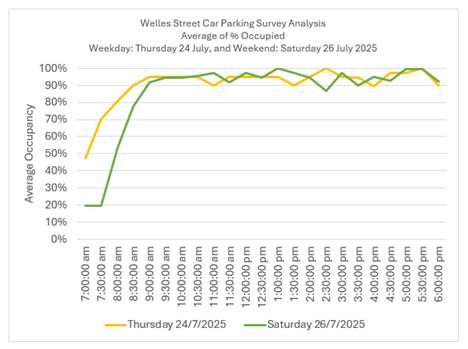
Project background
4.12 Submissions
from residents to the current LTP and 2023/24 Annual Plan sought street
improvements to upgrade the current condition of this road space.
Submissions on the South-East Central Neighbourhood Plan also mentioned the
opportunity to improve Welles Street. While no funding was allocated through
the LTP, the potential for interim improvements was identified by staff in the
Enliven Places Programme.
4.13 This
project was initiated in July 2024 and has been co-developed alongside
residents and businesses on Welles Street. Early engagement in October 2024
helped to shape the features and layout of this temporary street upgrade.
Project
overview
4.14 The concept plan (Attachment A) reflects community
requests and includes:
· Additional bike
parking to service visitors to the businesses on Welles Street.
· Creating
pinch-points in sections of the street to slow traffic and widen the footpath
to create areas for outdoor dining, seating and landscaping (Attachment F).
· Addition of planters
with landscaping.
· Possible wayfinding
signage.
· Removal of a total
of 5 carparks to accommodate the above interventions (refer to Attachment B).
Options Considered Ngā
Kōwhiringa Whaiwhakaaro
4.15 The
following reasonably practicable options were considered and are assessed in
this report:
4.15.1 Option
1 – Approve all temporary improvements as per the concept plans for a
period of five years (Attachment A) – preferred option.
4.15.2 Option
2 – Although the majority of respondents support the proposed concept
plan, there is the option to reduce the number of planters on the north and /
or south side of the street therefore reducing the number of car park spaces to
be removed.
4.15.3 Option
3 - do nothing.
4.16 The
following option was also considered but ruled out:
4.16.1 In
ground tree pits (permanent) is a preferred option for the health of the trees
and to achieve the best tree canopy. However, this option was ruled out due to
cost, the location of underground services and some flooding during significant
rain events that requires more investigation and addressing through a permanent
upgrade. This option could be explored if funding is secured for a full street
upgrade in a future LTP.
Options Descriptions Ngā
Kōwhiringa
4.17 Preferred
Option: Approve all temporary improvements as per the concept plans for a
period of five years (Attachment A).
4.17.1 Option
Advantages
· Responds to community requests and reflects the positive feedback
received during consultation from the majority of businesses, residents and
visitors who support the temporary improvements.
· Creates a more attractive environment to encourage more people to
want to live and visit the area.
· Contributes
to increasing greening in an area with a very low tree canopy cover.
· Acts as traffic calming measures to improve pedestrian and cyclist
safety.
· Budget is available to provide immediate temporary upgrades, through
the Enliven Places Programme, noting Welles Street is not currently identified
for transport improvements in the LTP.
· Doesn’t require permanent and more costly changes to kerb and
channel or require assessment of underground services for permanent tree pits.
· Enables
further delivery on the South-East Central Neighbourhood Plan.
· Provides for
an opportunity to trial and test design outcomes that could be incorporated
into a more comprehensive upgrade if funding is secured in the next LTP.
4.17.2 Option
Disadvantages
· Removes 5 x
parking spaces.
· Doesn’t
respond to the one business who raised concerns about carparking removal.
· Has a project
cost (within an allocated budget).
4.18 Option 2: Approve the temporary
improvements per Option 1 but reduce the number of planters on the north and /
or south side of Welles Street.
4.18.1 Option
Advantages
· Reduces the number of carparks lost by reducing the number of
planters from the project scope. Two planters on the south-side of the street
at the entrance to Atlas Quarter could be removed from the project scope to add
an extra carpark for customers without significant impact on the overall design
and function of the improvements.
· This would respond to concerns raised in a submission by local
business, Balayage, and provide more carparking for visitors.
4.18.2 Option
Disadvantages
· This option is not the
preferred option due to the majority support for the proposed concept plans,
the existence of off-street paid parking nearby for casual visitors and the
number of requests for greening on the street – refer Summary of Submissions
in section 6 below. Of the eleven businesses that made a submission, only one
raised concern about the removal of carparking.
· Has a project
cost (within an allocated budget), albeit slightly less than Option 1.
4.19 Option
3
4.19.1 Option
Description: Do nothing.
4.19.2 Option
Advantages
· The current
carparking layout remains as is, which provides more carparking space for
visitors.
· Budget would
be retained and potentially used for other projects within the Enliven Places
Capital Programme.
4.19.3 Option
Disadvantages
· Would not
respond to the requests for action received during consultation on the LTP and
on the Welles Street project.
· Does not
provide temporary improvements to Welles Street for residents and visitors,
including not addressing the Council tree policy for canopy cover.
· Does not help
to slow traffic in an area with a growing number of pedestrians.
· Does not
provide seating areas for visitors to Welles Street.
· Would not take
advantage of the only current budget available to improve the environment in
this location.
· Does not
enable further implementation of the South-East Central Neighbourhood Plan.
Analysis Criteria Ngā Paearu Wetekina
4.20 The
options considered were determined by the project’s impact on the
surrounding community and the extent to which it addresses community feedback.
The project aims to provide a balance of temporary improvements to the street
while minimising disruption to existing uses.
5. Financial Implications Ngā Hīraunga Rauemi
Capex/Opex Ngā Utu Whakahaere
|
|
Recommended Option
|
Option 2
|
Option 3 – Do Nothing
|
|
Cost to Implement
|
$12,633 (FY25)
$158,467 (FY26)
|
$12,633 (FY25)
$158,467 (FY26)
Minus $800 per planter removed
|
$21,057 (costs to date as at 21 August
2025)
|
|
Maintenance/Ongoing Costs -opex
|
$1,500 p.a.
|
$1,500 p.a.
|
$0
|
|
Funding Source: Enliven Places Programme
capital and operational budgets. CPMS 80201
|
6. Considerations Ngā Whai Whakaaro
Risks and Mitigations Ngā Mōrearea me
ngā Whakamātautau
6.1 Risk:
parking changes
6.1.1 There
is a risk that the removal of five carparks may increase pressure on parking
availability and adversely affect local business operations if customers
can’t access parking.
6.1.2 The parking occupancy audits – results summarised in 4.7 -
4.11 show that carparks are mostly fully occupied throughout the day.
6.2 Mitigation:
6.2.1 There is a good provision of carparks within the surrounding area as
shown in Attachment C. This includes 68 privately run paid public
carparks on the north side of the street available for people who visit, work
or live nearby, including casual visitors.
6.2.2 The addition of cycle hoops as requested by a local business intends
to help balance the loss of carparks.
6.2.3 Community engagement and feedback – these plans have been
developed and informed by the community to ensure positive outcomes with the
majority supportive. Many businesses have been vocal in requesting seating,
landscaping and bike stands and are prepared to lose carparking to achieve
this. The concept plan has been designed to minimise the loss of parking.
Legal Considerations Ngā Hīraunga
ā-Ture
6.3
Statutory and/or delegated authority to undertake proposals in the report:
6.3.1 Although
the project is within the area marked Plan A (Attachment D) in the
Delegations Register and would otherwise be a decision of the Parking
Restrictions committee, the project’s total capital budget exceeds
$100,000 and so a decision is required by Council.
6.3.2 The
installation of any signs and/or markings associated with traffic control
devices must comply with the Land Transport Rule: Traffic Control Devices 2004.
6.3.3 There
is no legal context, issue, or implication relevant to this decision
6.3.4 This
specific report has not been reviewed and approved by Legal Services, however
the report has been written using a general approach previously approved by
Legal Services, and the recommendations are consistent with the policy and
legislative framework outlined in this report.
Strategy
and Policy Considerations Te
Whai Kaupapa here
6.4 The
required decisions:
6.4.1 Align
with the Christchurch City Council’s Strategic Framework with particular emphasis on supporting the community outcome
‘A green, liveable city’.
6.4.2 Support
the delivery of the:
South-East Central Neighbourhood Plan, specifically implements actions:
6a. ‘Implement public realm
greening on suitable streets ahead of permanent upgrades’,
9a. ‘Investigate opportunities
to enhance pedestrian routes’,
9d. ‘Investigate opportunities
to implement appropriate lower speed environments’,
9g. ‘Opportunities to install
secure and convenient cycle parking’ and
12e. ‘Deliver placemaking
projects and initiatives in collaboration with the community to enhance the
identity of the neighbourhood’;
Ōtautahi Christchurch Future
Transport Plan, alignment with goal 6 ‘A
vibrant, healthy and liveable city’, which focuses on the role streets
have in shaping our urban environment – noting a need to continue
prioritising the Central City and to enhance our streets and neighbourhoods as
our city becomes more intensively developed; and
Christchurch Urban Forest Plan – as noted in section 4.4 above.
6.4.3 Are
assessed as low significance based on the Christchurch City Council’s
Significance and Engagement Policy. The level of significance was
determined by the low cost and temporary nature of this project.
6.5 This
report supports the Council's Long Term Plan (2024 - 2034):
6.6 Strategic Planning and Policy
6.6.1 Activity: City Growth and Property
· Level
of Service: 17.0.20.3 Deliver small scale temporary and permanent capital
projects to support city identity, community leadership and placemaking - 100%
of capital projects align with Urban Regeneration Capital objectives.
Community Impacts and Views Ngā Mariu
ā-Hāpori
6.7 The
decision affects the Waipapa Papanui-Innes-Central Community Board. A memo
outlining the project was circulated to the Community Board and Councillors in
July 2025; no feedback was received.
6.8 Early feedback from residents and businesses along the
street was gathered in October 2024. Forty-two responses were received during
the initial engagement phase, which included requests for an improved
pedestrian-friendly design with reduced vehicle traffic, more greenery, and
enhanced public spaces to support the increasing residential and commercial
presence. The feedback helped to shape a concept plan.
6.9 The project team has been in contact with Welles Street
businesses and stakeholders throughout the early feedback stages.
6.10 Formal consultation on the draft plan for Welles Street
started on 9 July and ran until 28 July 2025.
6.11 Consultation
details, including links to the project information shared on the Kōrero
mai | Let’s Talk webpage, were advertised
via:
· An email to previous
submitters and stakeholders.
· A letter
delivered to 110 Atlas Quarter residents.
· The Kōrero
mai | Let’s Talk page shared to the Atlas
Quarter residents Facebook group by the Chair of the Body Corporate on
our behalf.
· Doorknocking of
and emailing local businesses.
6.12 The
Kōrero
mai | Let’s Talk page had 447 views
throughout the consultation period.
Summary
of submissions Ngā Tāpaetanga
6.13 Submissions
were made by 11 recognised businesses/organisations and 32 individuals. All
submissions are available on the Kōrero
mai | Let’s talk webpage. Submissions from
businesses/organisations who were directly on or backing onto Welles Street are
outlined below.
· Atlas Quarter (Body
Corporate 513813) – Somewhat supported the plan as the ‘first
step’ for improving Welles Street, noting they would prefer more
permanent improvements. They raised concerns around future maintenance of
planters. They suggested a number of additions including surveillance cameras,
rubbish/recycling bins, and further improving the area for pedestrians
(laneways, traffic-calming measures and lowering the speed limit).
· Grizzly Baked Goods
– Supported the plan, noting they love the idea to enliven the street and
make it more pedestrian friendly. Suggested extending the outdoor dining
outside Kokomo westward to provide their customers with more seating.
· Dhi Ferrari Cakes –
Supported the plan, particularly the outdoor seating which they think would add
to the vibe of the area. They raised concerns about near misses with
pedestrians and suggested a painted area on the street to alert motorists that people
may cross.
· TSA HD LTD t/a Balayage
– Somewhat supported the plan, particularly the planting and trees.
Balayage strongly opposed the removal of five car parks, noting it was
‘detrimental to business’, particularly with the increase in cost
in the privately owned carparks on the street. They suggested Council
reconsider the reduction in car parks.
· Retailworld Resourcing
– Supported the plan, particularly the outdoor seating and greenery. They
noted the street is tight as a two-way street and needs to be improved for
pedestrians.
· MP Property –
Supported the plan and provided no further feedback.
6.14 Half
(52%) of individual submitters were people who visited Welles Street (16),
one-quarter (26%) worked there (8), and the remaining 23% (7) lived there.
6.15 Overall,
the majority of submitters supported the plan (70%, 30); the remainder somewhat
supported the plan (30%, 13), suggesting further improvements to the street
which are beyond scope of the current budget.

6.16 Submitters
liked:
· The proposed outdoor
seating areas (24)
· The addition of trees and
greenery to the space (20)
· That the plans would
improve the feel of the area (12)
· The inclusion of bicycle
parking (8)
· That the plans provide a
better use for the space than carparking (7)
· That the changes will
increase safety/slow traffic (4)
6.17 Submitters
suggested:
· The inclusion of a safe
pedestrian crossing area (14), whether it be a full pedestrian crossing,
painted area or ‘3d street art’ on the road to indicate to
motorists there may be pedestrians
· Introducing further
measures to slow traffic, including through a speed limit reduction or traffic
calming measures (13)
· Investing into more
permanent measures, particularly in relation to trees (8)
· Increasing the number of
trees and planting (7)
· Making the area safer
through improved lighting or camera surveillance (4)
· Addressing drainage
issues, including levelling footpaths to reduce flooding (4)
· Improving the area for
cycling, through a cycleway or sharrows (4)
6.18 Other
less-frequent suggestions included disability parking, cargo bicycle parking,
and rubbish bins/recycling.
6.19 A number of suggestions (speed limit
reduction, addressing flooding, pedestrian crossing or tree pits) are out of
scope for the current low-cost, temporary project; however, these could be
addressed through a more comprehensive full upgrade if funding was secured in
the next LTP.
6.20 The
detailed design of the outdoor seating areas will be informed by the
submissions received and follow-up discussions with businesses.
Impact
on Mana Whenua Ngā
Whai Take Mana Whenua
6.21 The decision does not involve a significant decision concerning
ancestral land or a body of water or other elements of intrinsic value,
therefore this decision does not specifically impact Mana Whenua, their culture
and traditions.
6.22 The decision does not involve a matter of interest to Mana Whenua
and will not impact on our agreed partnership priorities with Ngā Papatipu
Rūnanga.
Climate
Change Impact Considerations Ngā Whai Whakaaro mā te Āhuarangi
6.23 The decisions in this report are likely to:
6.24 Contribute positively to adaptation to the impacts of climate change
through the planting of more trees in an area lacking in landscaping.
6.25 Contribute positively to emissions reductions by making the street
more desirable to walk and cycle.
7. Next Steps Ngā Mahinga ā-muri
7.1 If
the recommended option is approved, delivery is proposed during November 2025.
7.2 The
project is anticipated to be in place for up to 5 years.
Attachments Ngā Tāpirihanga
|
No.
|
Title
|
Reference
|
Page
|
|
a ⇩
|
Welles Street
- Temporary enhancements - Concept Plan
|
25/1303477
|
81
|
|
b ⇩
|
Welles Street
- carpark changes
|
25/1303480
|
82
|
|
c ⇩
|
Welles Street
- location of carparks in the wider area
|
25/225360
|
83
|
|
d ⇩
|
Plan A -
Delegations Register
|
25/1799097
|
84
|
|
e ⇩
|
Welles Street
Signage and Road Marking Plan
|
25/1637333
|
85
|
|
f ⇩
|
Welles Street
Parklet Concept Design
|
25/1822847
|
86
|
In addition to the attached documents, the following background
information is available:
|
Document
Name – Location / File Link
|
|
Not
applicable
|
Signatories Ngā Kaiwaitohu
|
Authors
|
Corrine Early
- Senior Project Coordinator
Laura Botica -
Senior Planner Urban Regeneration
May Wong -
Engineer - Traffic Investigations
|
|
Approved By
|
Stephen Wright
- Manager Operations (Transport)
Mark Stevenson
- Head of Planning & Consents
John Higgins -
General Manager Strategy, Planning & Regulatory Services
|
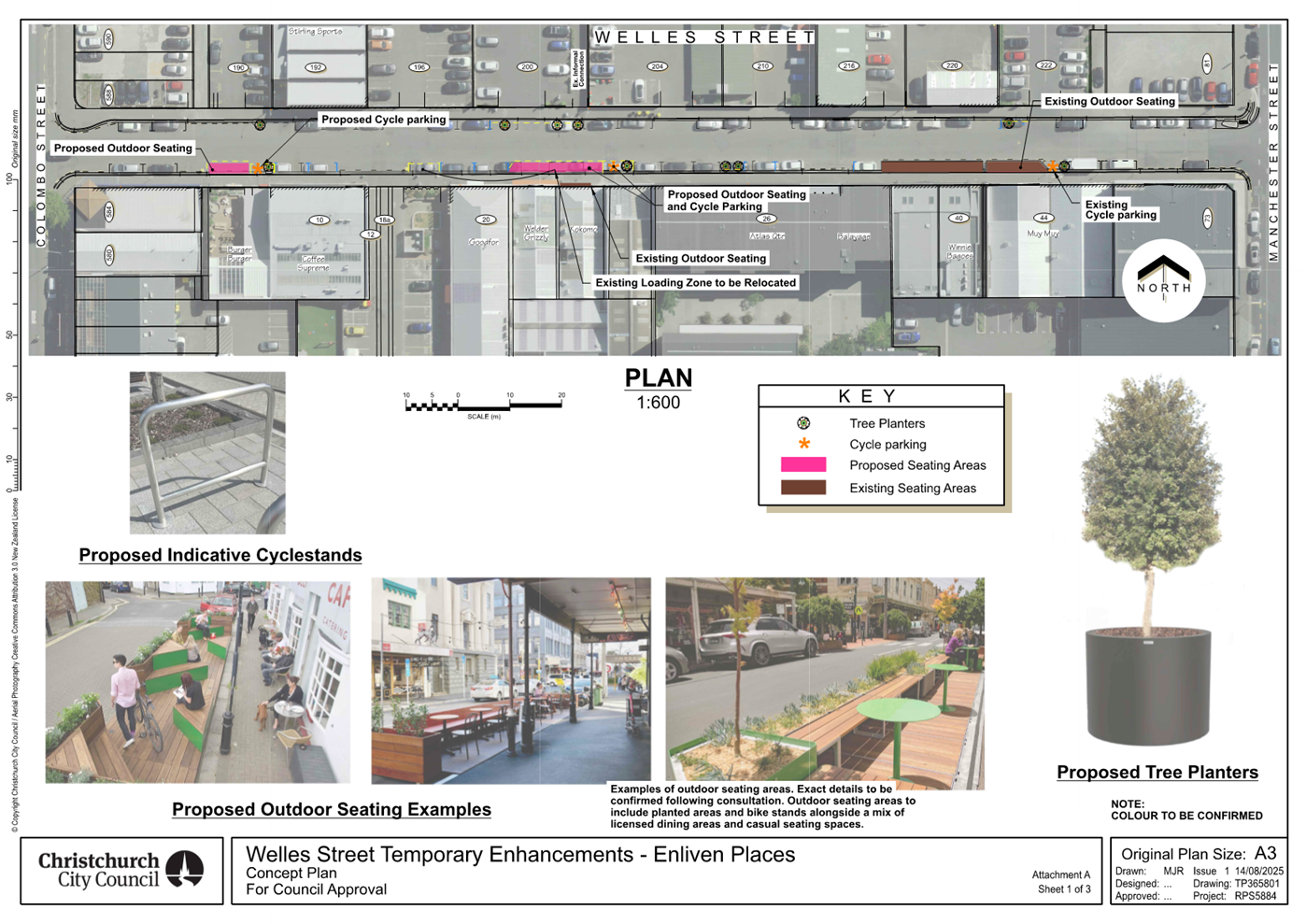
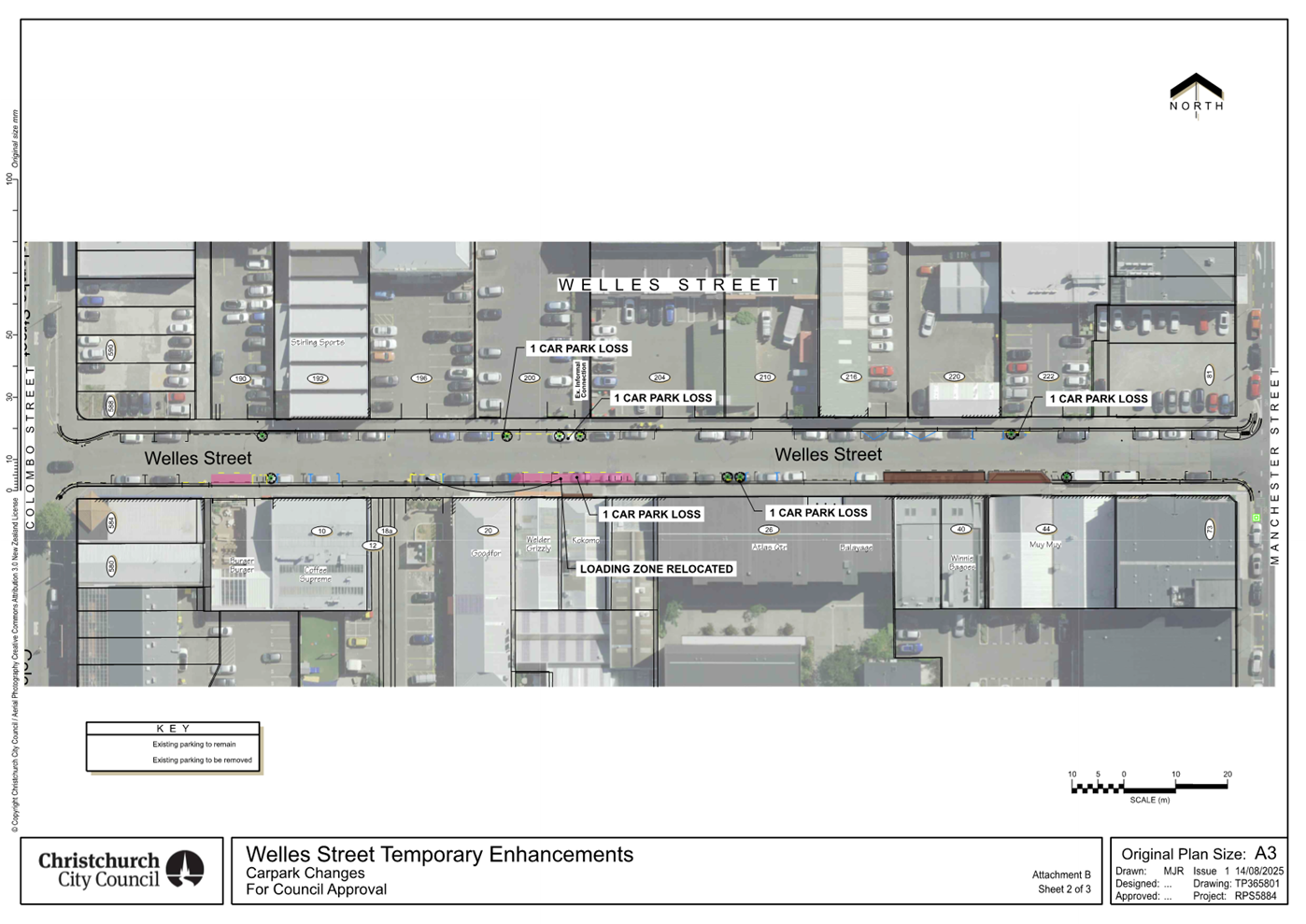


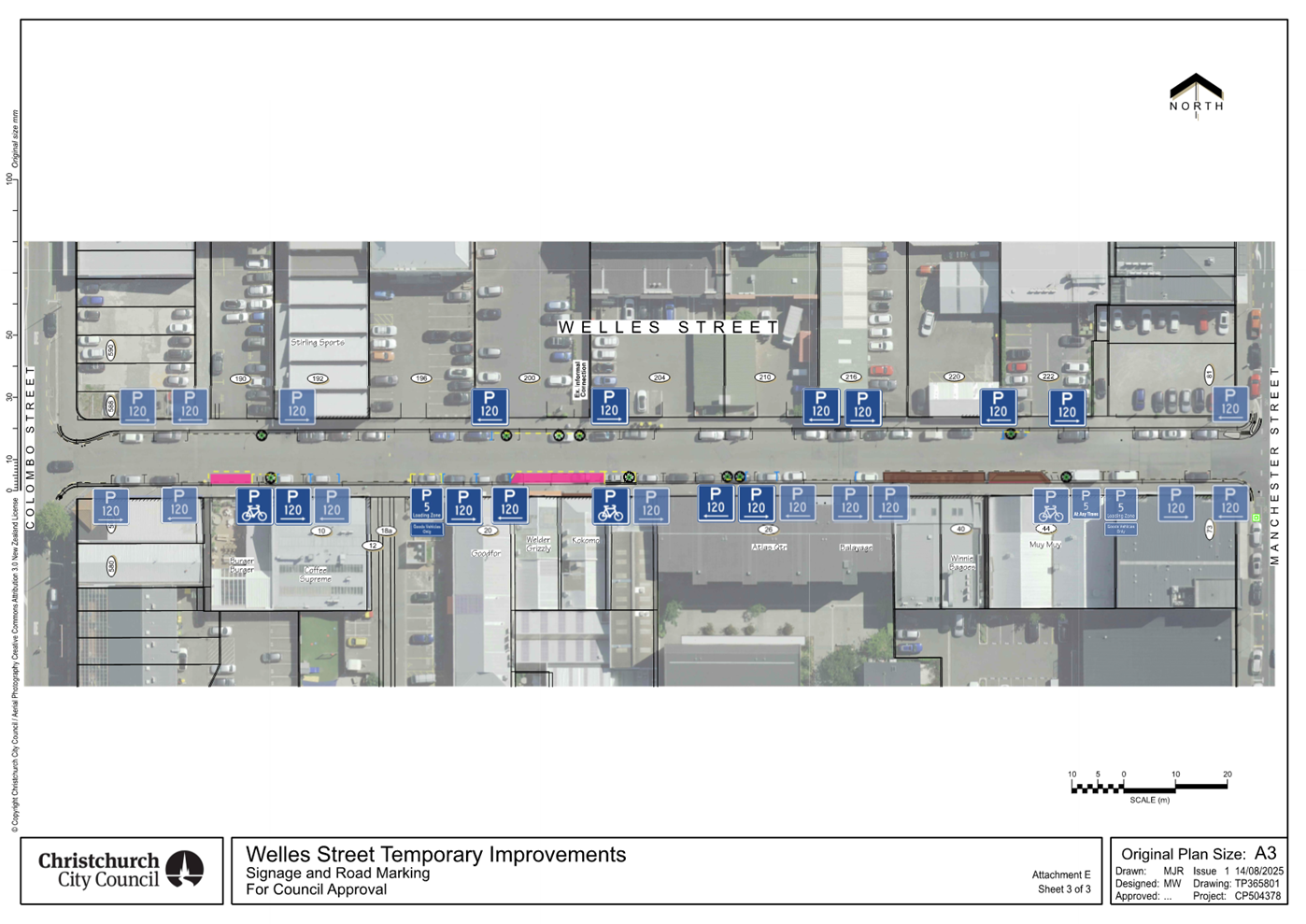
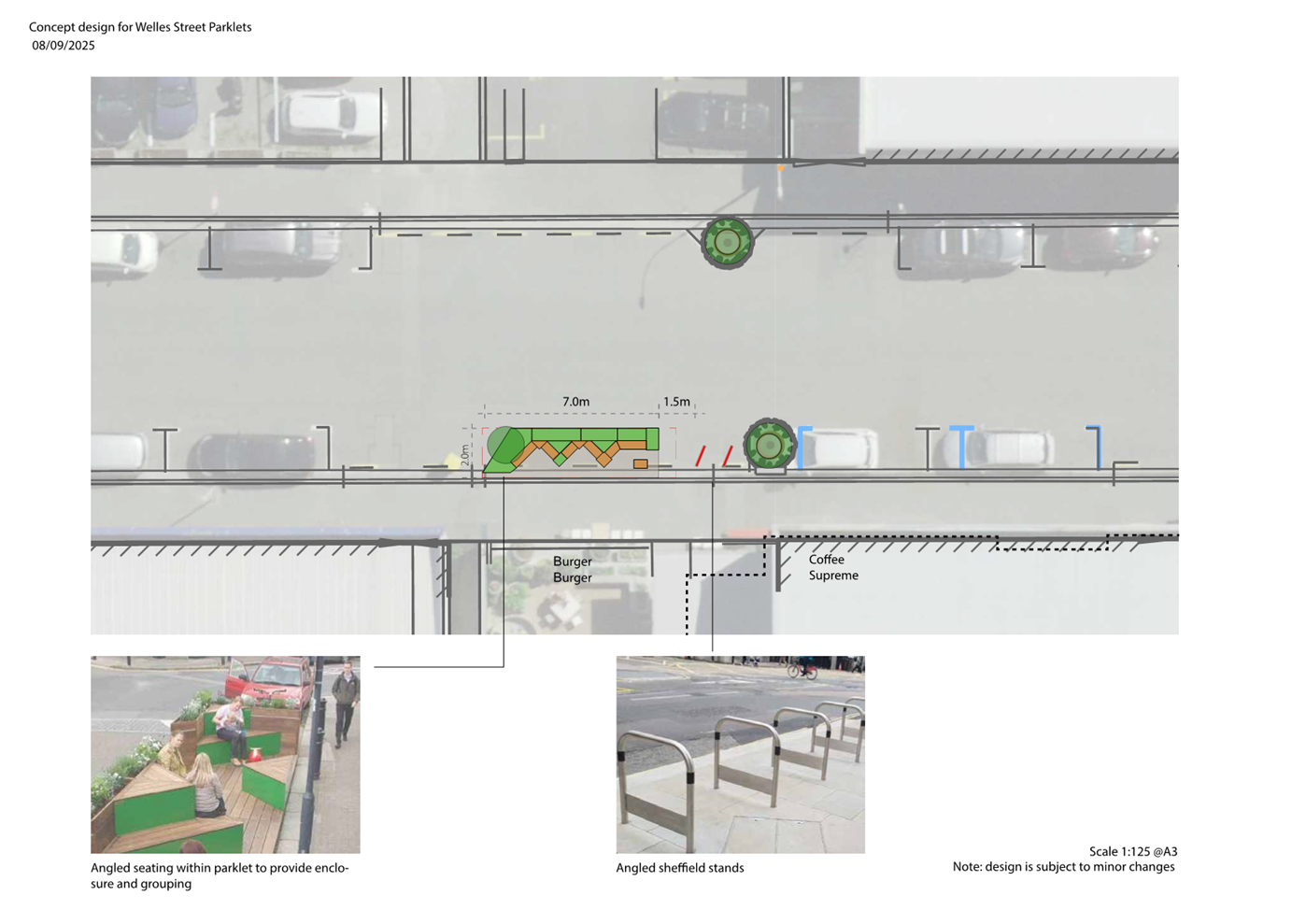
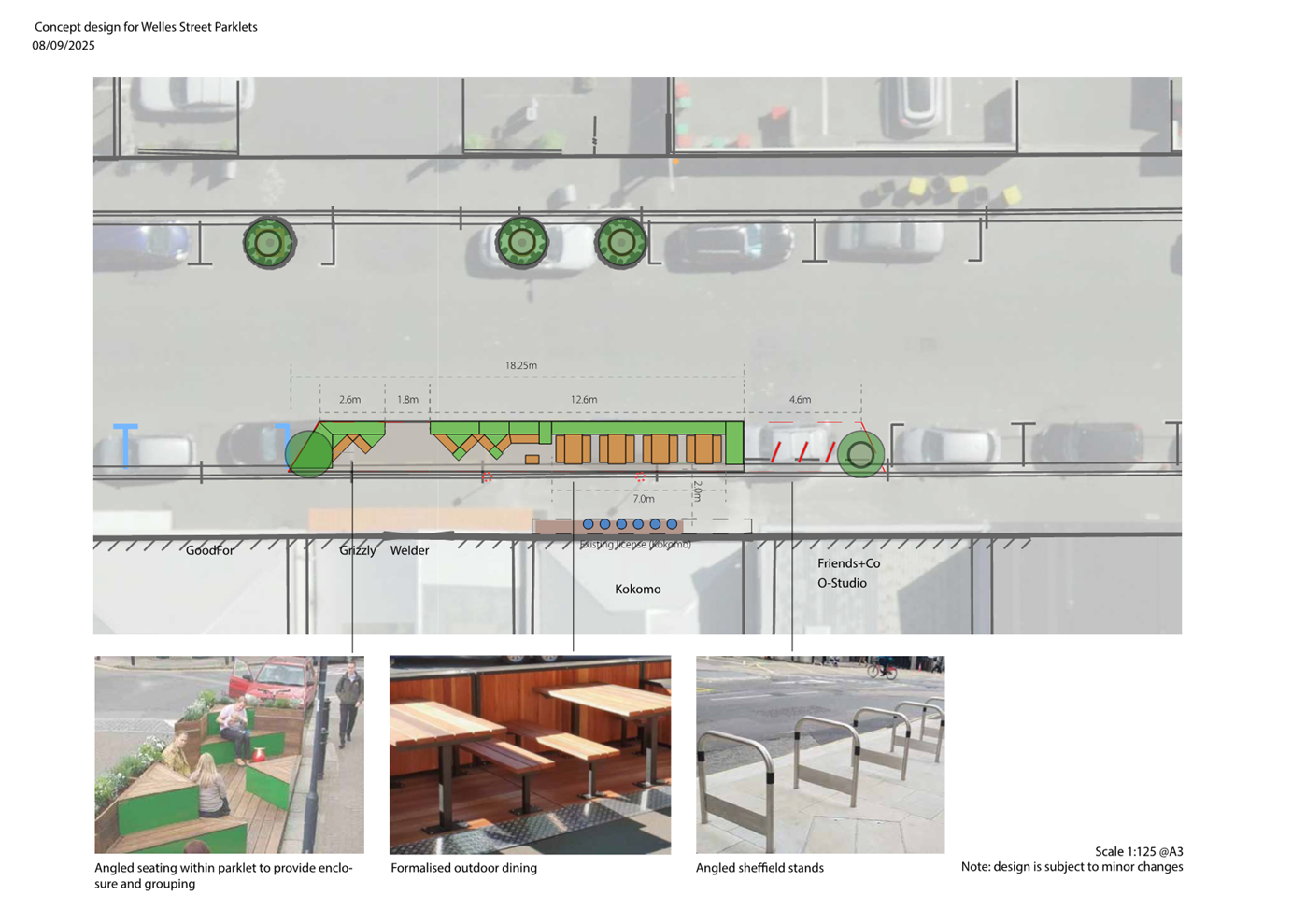
|
9. Decision on Plan Change 13 -
Heritage
|
|
Reference Te Tohutoro:
|
25/1365896
|
|
Responsible Officer(s) Te Pou Matua:
|
Glenda
Dixon, Senior Policy Planner
Suzanne Richmond, Heritage Advisor (Planning)
Darren Bridgett, Team Leader City Planning
|
|
Accountable ELT Member Pouwhakarae:
|
John
Higgins, General Manager Strategy, Planning & Regulatory Services
|
1. Purpose and Origin of the Report Te Pūtake Pūrongo
1.1 The hearings for Plan Change 13 – Heritage took place on 17
and 18 June 2025. The Hearings Panel’s (Commissioners Ken Gimblett, David
Caldwell and Heike Lutz) recommendations, which are provided as Attachment A,
were received on 1 September 2025. The purpose of this report is to present
those recommendations and for the Council to decide whether to adopt or reject
them (with limited further options as described in the report).
2. Officer
Recommendations Ngā Tūtohu
That the Council:
1. Receives the Panel report and
recommendations on Plan Change 13 – Heritage.
2. Notes that the decision in this report is assessed as medium
significance based on the Christchurch City Council’s Significance and
Engagement Policy.
3. Withdraws from Plan Change 13 the notified deletion of the
“scale of activity” exemption in Appendix
9.3.7.4 from the 40m2 limit for permitted non-residential activity
in heritage items under Rule 14A6.1 P8.
EXCEPT FOR THE PROVISION IN RECOMMENDATION 3 ABOVE, EITHER:
4. Adopts the recommendations of the Hearings Panel on Plan Change 13
(Heritage) under clause 10 of Schedule 1 of the Resource Management Act 1991, for
the reasons set out in the Hearings Panel’s report as outlined in
Attachment A of this report.
OR
5. Rejects
the recommendations of the Hearings Panel regarding Antonio Hall and agrees to
remove Antonio Hall and its setting from the heritage schedule under clause 10 of Schedule 1 of the Resource Management Act 1991,
for the reasons expressed in the Council decision on Antonio Hall in Plan
Change 14;
AND
6. Except
for Antonio Hall and its setting, adopts the recommendations of the Hearings
Panel on Plan Change 13 (Heritage) under clause 10 of Schedule 1 of the
Resource Management Act 1991, for the reasons set out in the Hearings
Panel’s report as outlined in Attachment A of this report.
3. Executive Summary Te Whakarāpopoto Matua
3.1 The Hearings Panel recommended that the Plan Change be adopted with
the provisions as put forward in the Council’s Right of Reply, with the
following key changes:
3.1.1 Rugby
Park to be deleted from the Church Property Trustees/North St Albans Residential
Heritage Area.
3.1.2 Scheduling of
the Former Quarry Stables, 79 Bamfords Road, Allandale, Governors Bay.
3.1.3 Reduced
protection for Antonio Hall, 265 Riccarton Road - heritage item limited to the
chapel only as Highly Significant, and removal of the setting.
3.1.4 Removal of
protection for Daresbury heritage item and setting, 9 Daresbury Lane.
3.2 The position of the Council at the hearing was that Antonio Hall and
Daresbury heritage items and settings should not be scheduled in the District
Plan. That position reflected the decisions of Council in PC14. The
Council’s neutral independent experts provided their opinions to the
Panel, which favoured retention of the two items in the heritage schedule.
3.3 The Panel recommendation reflects the Council position for Daresbury
but not for Antonio Hall. For Antonio Hall, the Council position was that none
of the buildings or their setting should be scheduled, however Council’s
expert evidence favoured retaining protection for the accommodation wing, motor
house and chapel. The Panel’s recommendation is to keep only the chapel,
with no setting.
3.4 The Council’s decision on the Panel recommendations is in a
quasi-judicial process that the Resource Management Act requires for plan
changes. The Panel had the benefit of hearing and seeing submissions and
evidence. Council can ask the Panel questions about its recommendations but
should not replace its decision for that of the Panel without having another
hearing of a disputed recommendation.
3.5 Antonio Hall may be an exception to that usual principle. For
Antonio Hall, the Council may prefer to make a decision that has regard to the
Panel’s recommendations but is consistent with its PC14 decision to
recommend that all of Antonio Hall and its setting be removed from the heritage
schedule, despite that not being the opinion of the Council’s experts or
the recommendation of the Panel.
“Scale of activity” exemption error
3.6 On a separate matter, the Council made an error in deleting an
exemption for “scale of activity” limits in Rule Appendix 9.3.7.4
and Rule 14A6.1 P8 as part of the notified plan change. The error was
that the notified plan change described this change as having no substantive
effect. The Panel recommendation to delete the exemption is on the express
basis that the change has no substantive effect. That reason is incorrect
insofar that the change has a substantive effect. Officers recommend that the
Council withdraw that deletion of the exemption from the plan change as it
proceeded on a flawed basis.
4. Background/Context Te Horopaki
4.1 Plan Change 13 as notified:
4.1.1 Introduced 11
new Residential Heritage Areas (RHA) with an associated policy and rules
framework.
4.1.2 Amended the
schedule for heritage items and settings (individual sites protected in
Appendix 9.3.7.2 of the district plan) by:
· adding
protection for new heritage items, heritage settings and interiors of new and
existing heritage items
· updating
protection for existing heritage items and settings to reflect changes on sites
such as implemented subdivision and land use consents, and
4.1.3 Amended
controls for heritage items and settings already protected in the district plan
by making a range of minor changes to the policy and rules framework, including
strengthening of some rules and relaxation or simplification of others.
5. Notification and Submissions Received
5.1 Plan Change 13 (Heritage) was jointly notified with Plan Change 14
(Business and Housing Choice) on 17 March 2023. The changes to heritage
provisions, which applied to heritage sites and RHAs within the urban area were
duplicated in both plan changes, as heritage is a qualifying matter.
5.2 Submissions and further submissions closed on 12 May 2023 and 17
July 2023 respectively. The Council received 76 submissions in relation to RHAs
and 19 further submissions opposing or supporting the decisions requested on
RHAs. In relation to heritage items, 53 submissions were received and 18 further
submissions.
5.3 Plan Change 13 was put on hold pending decisions on Plan Change 14.
5.4 A few (mostly duplicate) submissions which were omitted from the
original notification of submissions on Plan Change 13 were notified on 29 March
2025 for further submissions. This resulted in 7 further submissions.
Decisions already made
5.5 On 18 September 2024 and on 2 December 2024 the Council made decisions
on some heritage sites and RHAs in the context of Plan Change 14.
5.6 On 11 December 2024, the Council made decisions in relation to Plan
Change 13 to withdraw some notified provisions where decisions had been made in
Plan Change 14. Decisions were also made to withdraw some other notified
provisions from PC 13, being the Heaton Street and Piko/Shand RHAs, the Blue
Cottage (32 Armagh Street) from the Inner City West RHA, the area specific
built form standards (all RHAs), interface rules for RHAs (where relevant); and
the Yaldhurst Memorial Hall proposed heritage item and setting.
5.7 Further to direction given by the Council on 11 December 2024 to
review the spatial extent of the notified Lyttelton RHA, decisions were made (on
16 April and 4 June 2025) to withdraw some properties from that RHA, primarily
on its periphery, and to withdraw further notified provisions where decisions
had already been made in Plan Change 14. These related to height and interface
provisions for New Regent Street and the Arts Centre, and mapping corrections
in respect of the Cathedral of the Blessed Sacrament.
5.8 The remaining provisions of Plan Change 13, with submissions on
those provisions, were heard on 17 and 18 June 2025.
Hearing
Panel Recommendation
5.9 The Panel’s recommendation is that the Plan Change be adopted
as recommended in the Council’s section 42A reports and right of reply,
subject to a small number of amendments.
5.10 The Panel endorsed the introduction of the nine RHAs. These are:
Chester St East/Dawson St, Inner City West, Church Property Trustees North St
Albans, Englefield/Avonville, Wayside Avenue, RNZAF Station Wigram Staff
Housing, Shelley St/Forbes St, Macmillan Avenue, and Lyttelton RHAs.
5.11 It also endorsed nearly all of the provisions put forward by the
Council and summarised in 4.1.2 and 4.1.3 above in relation to items and
settings, and minor changes to the heritage policy and rules framework. The
amendments the Panel recommended are as follows:
5.11.1 Rugby Park to be deleted
from the Church Property Trustees North St Albans Residential Heritage Area.
The Panel considered that Rugby Park had a long history in CRFU ownership of
being adjacent rather than integral to the RHA, and unlike
Malvern Park, Rugby Park offered no public, unrestricted access that would link
it to neighbourhood recreational activities, nor is its function predominantly
associated with the residential neighbourhood today.
5.11.2 Scheduling of the Former
Quarry Stables, 79 Bamfords Road, Allandale, Governors Bay. The stables
building meets the significance threshold for scheduling, but was not put
forward by Council officers on the basis that the owner had not confirmed their
support. The Panel does not favour the practice
of not scheduling where the only factor against that outcome is the absence of
owner support.
5.11.3 Reduced protection for
Antonio Hall, 265 Riccarton Road, to limit the heritage item to the chapel
only, and removal of the setting. The Panel was of the opinion that both the
accommodation wing and the motor house no longer possess the physical integrity
required to be retained on the schedule. However they accepted engineering and
heritage technical evidence that the chapel was able to be repaired. They
considered that it warrants Highly Significant status as the most intact surviving element of the complex, which therefore assumes greater prominence
in conveying the strong associative values with the Catholic Church’s period of
ownership.
5.11.4 Removal of protection for
Daresbury heritage item and setting, 9 Daresbury Lane. The Panel accepted that
the homestead was nationally significant and could be repaired and continue to
meet the threshold for scheduling. However, they considered the weighing of
public good versus private cost to be “very
finely balanced” in this case. The Panel accepted the submitter’s
evidence that the realisable value of the repaired homestead, including
associated land value if it were to be on-sold, would be significantly less
than the cost of repair, and that in terms of a more end-use focussed scenario,
it was not financially reasonable or appropriate to continue to schedule the
property.
Options Considered Ngā Kōwhiringa Whaiwhakaaro
5.12 The Local Government Act requirement that Council decision-making
consider options, and their advantages and disadvantages, is subject to the
requirements of the Resource Management Act. The Resource Management Act has a
process for notifying plan changes, submissions, reports, evidence and a
hearing. That is the process in which the options for the content of the
district plan, and the advantages and disadvantages of those options, are
considered. No further consideration of options is appropriate. The Plan Change
13 record and the Panel recommendations on it discuss the relevant options in
the manner required by the Resource Management Act.
5.13 However, for Plan Change 13 there are exceptions to that regarding
Antonio Hall and the error described in paragraph 3.6 above.
5.14 The evidence and submissions regarding Antonio Hall are described in
the Panel recommendation report. Council can either:
(a) rely on the
Panel’s assessment and accept the Panel recommendation to retain the
scheduling of part of the item, or
(b) having
regard to both the Panel recommendation and the Council’s previous
assessment of the issue in PC14, reject the Panel recommendation and delete the
scheduling for Antonio Hall and its setting.
5.15 There are several process options available to the Council to
address the flaw in the reasoning for the notified plan change provision and
the Panel’s recommendations described in paragraph 3.6 above. Those
process options are:
(a) Reject
the Panel recommendation and leave the exemption in the Plan;
(b) Withdraw
that part of the plan change; or
(c) Not
make a decision on that provision yet. This would involve explaining to the
Panel the flaw in the Council’s description of the reason for the
notified plan change, and asking the Panel whether its recommendation changes
in the knowledge that deleting the exemption does have a substantive effect.
5.16 Officers
prefer the option of withdrawing that deletion of the exemption from the plan
change. That is preferred to breaching the 17 September 2025 deadline for
completing decision making on this plan change – which will happen if the
Council did not yet make a decision on that provision - and is preferable to a
rejection decision that could be subject to appeal to the Environment Court.
6. Financial Implications Ngā Hīraunga Rauemi
Capex/Opex Ngā Utu Whakahaere
|
|
Recommended Option
|
|
Cost to Implement
|
Within existing budget for Planning
|
|
Maintenance/Ongoing Costs
|
Nil
|
|
Funding Source
|
Within existing budget for Planning
|
|
Funding Availability
|
Funded in LTP
|
|
Impact on Rates
|
No additional impact beyond LTP
|
6.1 The costs of staff time on Plan Change 13 have been assumed in the
budgets of the Planning and Consents Unit as part of the Annual Plan and
Long-Term Plan.
6.2 The only ongoing costs could be in relation to any appeals received
on this decision. While appeals are possible, they are not considered likely.
7. Considerations Ngā Whai Whakaaro
Risks and Mitigations Ngā
Mōrearea me ngā Whakamātautau
7.1 The Council is statutorily required to have an operative District
Plan at all times. Issues have been identified with the heritage provisions of
the District Plan which will be addressed through this Plan Change. Therefore,
the risk of not acting is considered greater than the risk of acting.
7.2 The decision-making period for Plan Change 13 has been extended by
the Ministry for the Environment. It expires on 17 September 2025. The Council
would likely need to seek a further extension for decision making if it does
not decide on all of the Panel recommendations on that date.
Legal Considerations Ngā
Hīraunga ā-Ture
7.3 Statutory and/or delegated authority to undertake proposals in the
report:
7.3.1 The Resource
Management Act 1991 s73(1A) enables the Council to prepare a change to its
District Plan at any time, and to progress that plan change through the process
set out in Schedule 1 of the Act. In the case of PC 13, the Plan Change has
been carried out through the standard RMA process. PC 13 is sufficiently
advanced that the “Plan Stop” changes to the RMA do not apply to PC
13.
7.3.2 The Council
may adopt the recommendations of a Hearing Panel on a Plan change, as its
decision.
7.3.3 Submitters
will have the right to appeal to the Environment Court.
7.4 Other Legal Implications:
7.4.1 The Hearings
Commissioners’ recommendations report appropriately addresses the impact
of the RHAs and heritage items as qualifying matters that limit implementation
of the medium density residential standards.
7.4.2 This report
has been reviewed and approved by Legal Services.
Strategy and Policy Considerations Te Whai
Kaupapa
7.5 The required decision:
7.5.1 Aligns with the Christchurch City Council’s Strategic Framework in supporting and protecting the heritage and culture of the City.
7.5.2 Is assessed as medium significance based on the Christchurch City
Council’s Significance and Engagement Policy. The level of
significance was determined by the number of affected parties, and the level of
impact on those affected.
7.5.3 Is consistent with the Council’s
“Our Heritage, Our Taonga Heritage Strategy (2019-2029)” which
seeks a strong regulatory framework to ensure effective protection of
significant and highly significant heritage places, and a broadened range of
heritage places and areas.
7.5.4 The
decision is consistent with Schedule 1 of the Resource
Management Act and consistent with the Council’s Plans and Policies to
enable public participation and engagement.
7.6 This report supports the Council's Long Term Plan (2024 - 2034):
7.7 Strategic Planning and Policy
7.7.1 Activity: Strategic Planning and Resource Consents
· Level of Service: 1.4.3.1 Provide heritage
advice to support Resource Management Act statutory processes- 95% of advice
provided within statutory timeframes
· Level of Service: 9.5.1.6 Prepare plan changes
to the District Plan to address issues and to implement national and regional
direction, identified as a high priority by Council - Providing Council an
annual update on progress with plan changes
Community Impacts and Views Ngā Mariu
ā-Hāpori
7.8 Given the time that has elapsed since
notification in 2023, there has now been considerable opportunity for residents
to ask questions about the Plan Change and express their views, both formally
through submissions and further submissions and informally through such
mechanisms as the dedicated plan change email address.
7.9 Heritage rules have immediate legal effect under
s86B of the RMA. Two years of experience with processing resource consents in
Residential Heritage Areas including demolition applications and applying the
amended rules framework for heritage items and settings has informed the
recommendations of Council planning witnesses in their s42A reports.
7.10 The decision
affects all the Community Boards in the City.
Impact on Mana Whenua Ngā Whai Take
Mana Whenua
7.11 The decision does not involve a
significant decision in relation to ancestral land or a body of water or other
elements of intrinsic value, therefore this decision does not specifically
impact on Mana Whenua, their culture and traditions.
7.12 Māori heritage values are
specifically addressed in Chapter 9.5 of the District Plan – Ngāi
Tahu values and the natural environment.
Climate Change Impact Considerations Ngā
Whai Whakaaro mā te Āhuarangi
7.13 The decisions in
this report are likely to:
7.13.1 Contribute positively to
adaptation to the impacts of climate change, and
7.13.2 Contribute positively to
emissions reductions, as a result of 7.14 below.
7.14 Retention and reuse of existing building stock, rather than demolition
and new construction, reduces the city’s carbon footprint and extends the
economic life of heritage buildings.
8. Next Steps Ngā Mahinga ā-muri
8.1 The Council’s decision on the Panel recommendations on Plan
Change 13 will be publicly notified, with information provided on rights of
appeal. The appeal period for plan change decisions is 30 working days, so if
the decision was notified on the 24 September, the appeal period would expire
on 6 November.
8.2 If no appeals are received at the end of this period, staff would
report the Plan Change to the Council for final approval, then notify the date
on which the Plan Change would become operative. Final approval of changes to
the District Plan is one of the functions that cannot be delegated to staff
under the RMA, meaning that this final approval decision will need to be made
by the incoming Council after the local body elections. This delay would not
affect administration of the plan change provisions, as section 86F of the RMA
means that rules are effectively operative once the appeal period has passed
and there are no appeals.
8.3 If appeals are received, final approval of the Plan Change cannot
occur until the appeals are resolved.
Attachments Ngā Tāpirihanga
|
No.
|
Title
|
Reference
|
Page
|
|
a ⇨
|
Plan Change 13
- Hearing Panel's Report and Recommendations (Under Separate Cover)
|
25/1769978
|
|
In addition to the attached documents, the following background
information is available:
|
Document
Name – Location / File Link
|
|
Not
applicable
|
Signatories Ngā Kaiwaitohu
|
Authors
|
Glenda Dixon -
Senior Policy Planner
Suzanne
Richmond - Heritage Advisor
Darren
Bridgett - Team Leader City Planning (E)
Brent Pizzey -
Senior Legal Counsel
|
|
Approved By
|
Mark Stevenson
- Head of Planning & Consents
John Higgins -
General Manager Strategy, Planning & Regulatory Services
|
|
10. Governance Matters
|
|
Reference Te Tohutoro:
|
25/534330
|
|
Responsible Officer(s) Te Pou Matua:
|
Simone
Gordon, Democratic Services Advisor
|
|
Accountable ELT Member Pouwhakarae:
|
Mary
Richardson, Chief Executive
|
1. Purpose and Origin of the Report Te Pūtake Pūrongo
1.1 The
purpose of this report is to seek approval from the Council on key governance matters
before the current term ends. It responds to statutory requirements under the
Local Government Act 2002 and aims to ensure continuity of decision-making and
operational effectiveness during the election period.
1.2 Specifically,
the report recommends retaining certain governance bodies beyond the election
and delegating authority to the Chief Executive to make urgent decisions during
the interim period, between the declaration of election results and the
incoming elected members being sworn into office.
1.3 This
is a standard process applied at the end of each triennial.
2. Officer
Recommendations Ngā Tūtohu
That the Council:
1. Receives the information in the Governance
Matters Report.
2. Notes that the decisions in this report are assessed as low significance
based on the Christchurch City Council’s Significance and Engagement
Policy.
3. Approves, under clause 30(7) of Schedule 7 of the Local Government
Act 2002, that the committees, subcommittees, subordinate decision-making
bodies, and joint committees listed in Attachment A are not discharged
on the coming into office of the members of the Council elected or appointed
at, or following, the October 2025 triennial general elections, and they
continue to exercise the delegations made to them.
4. Authorises the Chief Executive, subject to the limitations set out
in clause 32(1) of Schedule 7 of the Local Government Act 2002, to make
decisions on behalf of the Council and community boards during the period
between the declaration of election results and elected members being sworn
into office, in respect of urgent matters and, where the Mayor-elect is known,
in consultation with the Mayor-elect.
3. Executive Summary Te Whakarāpopoto Matua
3.1 This
report seeks to address governance matters that need to be resolved before the
conclusion of the current council term.
3.2 This
report outlines the statutory requirements and recommended actions regarding
the continuation of Council committees, subcommittees, subordinate
decision-making bodies and joint committees following the election. This
includes retaining certain entities beyond the election period to ensure
continuity, as these would otherwise be automatically discharged under the
Local Government Act 2002 (see Attachment A).
3.3 There
is a need to provide for the possibility that urgent decisions may need to be
made during the interim period between the declaration of election results and
the swearing-in of elected members. It is proposed to authorise the Chief
Executive to make urgent decisions on behalf of Council and community boards
during the interim period, in consultation with the Mayor-elect, if known.
4. Background/Context Te Horopaki
Committees, subcommittees, other subordinate
decision-making bodies
4.1 The power to
appoint committees, subcommittees, other subordinate decision-making bodies,
and joint committees is contained in clause 30 schedule 7 of the Local
Government Act 2002.
4.2 Under clause 30 of Schedule 7 of the Local
Government Act 2002, all committees, subcommittees, subordinate decision-making
bodies, and joint committees are deemed to be discharged following the election,
unless the Council resolves otherwise.
4.3 The standing
committees of the current Council will be deemed to be discharged following the
election. The new committee structure will be confirmed early in the next
term.
4.4 Staff have reviewed existing entities and
identified several that should not be discharged; these are listed in Attachment
A. To ensure continuity of governance and decision-making, the report
recommends that Council formally resolves to retain these specified entities
beyond the election period.
4.5 The Council has previously resolved that the Christchurch
Urban Design Panel (CNCL/2017/00078), Infrastructure Design Standards Steering
Group (CNCL/2016/00483), Greater Christchurch Partnership Committee and the
Whakawhanake Kāinga Committee (CNCL/2022/00026) are not discharged
following triennial general elections. These entities will continue after the
election.
Urgent decisions during election period
4.6 Due to the interim period between the declaration of election
results and elected members being sworn into office, it is proposed that the
Chief Executive be delegated authority to make urgent decisions during this
time, in consultation with the Mayor-elect, if known. This delegation will be
subject to the general limits on delegations in clause 32(1) of Schedule 7.
4.7 Current elected
members will vacate office when the members elected at the upcoming elections
come into office (section 116(1) Local Electoral Act 2001). Candidates who are
elected come into office on the day after the day on which the official result
of the election is declared by public notice (section 115(1) Local Electoral
Act 2001). The Electoral Officer advises that the notice is expected to
be published sometime around 19 October 2025.
4.8 However, the
Local Government Act 2002 (cl.14 Schedule 7) provides that a person may not act
as a member of the Council until they have made an oral declaration and signed
a written declaration. The form of the declaration is set out in clause 14(3).
The declaration must be made at a Council meeting following the elections and
is ordinarily made at the inaugural meeting of the Council following the
elections.
4.9 Subject to when
the election results are declared and published, along with confirmation of the
date for the inaugural Council meeting, there may be a period of up to 2 weeks
in which decisions of the Council are unable to be made.
Options Considered Ngā
Kōwhiringa Whaiwhakaaro
4.10 The following reasonably
practicable options were considered and are assessed in this report:
4.10.1 The Council accepts the outlined governance
recommendations – this is the recommended option.
4.10.2 The Council declines the outlined governance
recommendations.
4.11 Preferred
option: the Council accepts the governance recommendations in this report.
4.11.1 Option description: Resolve
to not discharge the specified committees, subcommittees, other subordinate
decision-making bodies and joint committees, and authorise the Chief Executive
to make urgent decisions on behalf of Council during the interim period between
the declaration of election results and elected members being sworn into office.
4.11.2 Option advantages
· The recommendation to resolve to continue the specified committees
etc. supports effective and timely decision-making and helps maintain strong
working relationships with neighbouring local authorities, particularly in
relation to joint committees.
· Authorising the Chief Executive to make decisions on behalf of the
Council ensures that appropriate provisions are in place for urgent
decision-making, helping to maintain the Council’s effectiveness and
support its ability to respond efficiently to urgent matters, should they
arise.
4.11.3 Option disadvantages
· Public perception of reduced transparency may arise if the Chief
Executive makes urgent decisions on behalf of elected members of the Council.
4.12 Option 2: The Council declines to accept the outlined governance
recommendations – not recommended.
4.12.1 Option description: All
committees, subcommittees, subordinate decision-making bodies and joint
committees are discharged at the end of the current term, and the Chief
Executive is not authorised to make urgent decisions on behalf of Council
during the interim period between the declaration of election results and
elected members being sworn into office.
4.12.2 Option advantages:
· Decisions would be made by elected members, and when made in open
meetings, the public can be assured of transparency in the process.
4.12.3 Option disadvantages:
· A number of joint committees operate in partnership with
neighbouring local authorities and are governed by long-standing, agreed terms
of reference and other arrangements. If the Council were to discharge these
committees, it could trigger the need to revisit and renegotiate those
arrangements—creating unnecessary administrative work and potentially
straining effective working relationships with neighbouring councils.
· Re-establishing routine decision-making bodies, such as the District
Licensing Committee, would place an unnecessary administrative burden on staff
resources.
· Urgent decisions could be delayed and need to wait until the
swearing in of elected members following the election, which would hinder the
Council’s ability to respond efficiently and effectively to urgent
matters.
5. Financial Implications Ngā Hīraunga Rauemi
Capex/Opex / Ngā Utu Whakahaere
5.1 Cost
to Implement – There are no costs to implement the decisions in this
report.
5.2 Maintenance/Ongoing
costs – There are no ongoing costs from making these decisions.
5.3 Funding
Source – not applicable.
6. Considerations Ngā Whai Whakaaro
Risks and Mitigations Ngā
Mōrearea me ngā Whakamātautau
6.1 Staff
have recommended that it is desirable to carry over the committees,
subcommittees, other subordinate decision-making bodies, and joint committees
as set out in Attachment A after the triennial election to mitigate any
risk to the Council’s effectiveness.
6.2 Delegating
the Council’s decision-making powers to the Chief Executive during the
period between the declaration of election results and swearing in of the
incoming Council ensures that any urgent decisions can still be made in
conjunction with the Mayor-elect should this be required.
Legal Considerations Ngā
Hīraunga ā-Ture
6.3 Statutory
and/or delegated authority to undertake proposals in the report:
6.3.1 Clause 30(7) of
Schedule 7 of the Local Government Act 2002 provides that a committee,
subcommittee, or other subordinate decision-making body is, unless the local
authority resolves otherwise, deemed to be discharged on the coming into office
of the members of the local authority elected or appointed at, or following,
the triennial general election of members next after the appointment of the
committee, subcommittee, or other subordinate decision-making body.
6.3.2 Clause 32 of Schedule
7 of the Local Government Act 2002 provides that:
Unless expressly provided otherwise in this Act, or in any other
Act, for the purposes of efficiency and effectiveness in the conduct of a local
authority’s business, a local authority may delegate to a committee or
other subordinate decision-making body, community board, or
member or officer of the local authority any of its responsibilities, duties,
or powers except—
(a) the
power to make a rate; or
(b) the
power to make a bylaw; or
(c) the
power to borrow money, or purchase or dispose of assets, other than in
accordance with the long-term plan; or
(d) the
power to adopt a long-term plan, annual plan, or annual report; or
(e) the
power to appoint a chief executive; or
(f) the
power to adopt policies required to be adopted and consulted on under this Act
in association with the long-term plan or developed for the purpose of the
local governance statement; or
(g) [Repealed]
(h) the power to adopt a
remuneration and employment policy..
6.4 Other
Legal Implications:
6.4.1 The proposed
delegations to the Chief Executive do not infringe the restrictions in the
Local Government Act 2002.
6.4.2 This report has been reviewed by Legal Services.
Strategy and Policy Considerations Te Whai
Kaupapa here
6.5 The
required decisions:
6.5.1 Align with the Christchurch
City Council’s Strategic Framework.
6.5.2 Are assessed as low significance based on the Christchurch City
Council’s Significance and Engagement Policy. The level of
significance was determined by the fact that the decisions relate to
administrative matters.
6.5.3 Are consistent with Council’s Plans and
Policies.
6.6 This
report supports the Council's
Long Term Plan (2024 - 2034):
6.7 Governance
6.7.1 Activity: Governance and Decision-Making
· Level of Service: 4.1.28.3 Governance processes
are maintained and published on the Website that ensure statutory compliance -
1
Community Impacts and Views Ngā Mariu
ā-Hāpori
6.8 Urgent
decisions made by the Chief Executive outside of a public Council meeting may
create a perception of a lack of transparency. However, such decisions will
only be made when the matter is urgent and cannot reasonably wait until the
swearing in of the new Council. This risk is also somewhat mitigated by any
urgent decisions being made in consultation with the Mayor-elect, if known.
Impact on Mana Whenua Ngā Whai Take
Mana Whenua
6.9 The decisions in this report do not involve a significant decision in relation to
ancestral land, a body of water or other elements of intrinsic value, therefore
this decision does not specifically impact Mana Whenua,
their culture, and traditions.
6.10 The decisions do
not involve a matter of interest to Mana Whenua and will
not impact on our agreed partnership priorities with
Ngā Papatipu Rūnanga.
Climate Change Impact Considerations Ngā
Whai Whakaaro mā te Āhuarangi
6.11 The proposals in this report are
unlikely to contribute significantly to adaptation, the impacts of climate
change or emissions reductions.
7. Next Steps Ngā Mahinga ā-muri
7.1 The
specified committees, subcommittees, subordinate decision-making bodies and
joint committees will not be discharged at the end of the current term and remain
active.
7.2 Should
any urgent matters arise during the transition period between the declaration
of results and elected members being sworn into office, the Chief Executive
will be authorised to make decisions in respect to urgent matters on behalf of
the Council, in consultation with the Mayor-elect, if known.
Attachments Ngā Tāpirihanga
|
No.
|
Title
|
Reference
|
Page
|
|
a ⇩
|
List of
committees, subcommittees, other subordinate decision-making bodies and joint
committees to continue after the election 2025
|
25/1705066
|
102
|
In addition to the attached documents, the following background
information is available:
|
Document
Name – Location / File Link
|
|
Not
applicable
|
Signatories Ngā Kaiwaitohu
|
Author
|
Simone Gordon
- Democratic Services Advisor
|
|
Approved By
|
Megan Pearce -
Manager Democratic Services
Helen White -
General Counsel / Director of Legal & Democratic Services
Mary
Richardson - Chief Executive
|

|
11. Amendments to the Register of Delegations
|
|
Reference Te Tohutoro:
|
25/815866
|
|
Responsible Officer(s) Te Pou Matua:
|
Naomi
Soper - Senior Legal Counsel
|
|
Accountable ELT Member Pouwhakarae:
|
Helen
White, General Counsel / Director of Legal & Democratic Services
|
1. Purpose and Origin of the Report Te Pūtake Pūrongo
1.1 The
purpose of this report is to provide for some amendments to delegations from
the Council to the Chief Executive, from the Council to staff and from the
Council to Community Boards and an Officer sub-committee.
1.2 The
report has been written because only the Council can resolve to provide for
these delegations.
2. Officer
Recommendations Ngā Tūtohu
That the Council:
1. Receives the information in the Amendments
to the Register of Delegations Report.
2. Notes that the decision in this report is assessed as low significance
based on the Christchurch City Council’s Significance and Engagement
Policy.
3. Relying on clause 32 of Schedule 7 of the Local Government Act 2002
and for the purposes of efficiency and effectiveness in the conduct of the
Council’s business and any other applicable statutory authority, amends
the delegations register in Parts A, B and D as shown in Attachment A of this
report to:
a. reflect title changes or changes in positions; and
b. delegate responsibilities, duties and powers to staff resulting from
the Resource Management (Consenting and Other System Changes) Amendment Act
2025, alongside other minor amendments; and
c. remove the Diamond Harbour and Districts’ Health Support Group
and the Banks Peninsula Pest Liaison Committee from the Te Pātaka o
Rākaihautā Banks Peninsula Community Board’s powers of
appointment.
4. Notes that these delegations above take effect on the date of this
resolution, and Legal Services will update the Delegations Register
accordingly.
3. Executive Summary Te Whakarāpopoto Matua
3.1 Part
A of the Council’s delegations register contains the Council’s
statutory and other delegations to the Chief Executive. The Chief
Executive is then able to sub-delegate those responsibilities, duties and
functions to staff as she sees fit (subject to any express exclusions).
These sub-delegations are set out in Part C of the Delegations Register.
3.2 Part
B of the Council’s delegations register contains the Council’s
statutory and other delegations to officers because, for the most part, the law
does not allow for sub-delegations of these matters.
3.3 Part
D of the delegations register contains the delegations from the Council to
community boards, committees, and other subordinate decision-making
bodies.
3.4 The
proposed amendments to the delegations are sought to improve the efficiency and
effectiveness of Council processes.
4. Background/Context Te Horopaki
Parts A,
B and D
Change
of job title – Head of Legal and Democratic Services to Director Legal
and Democratic Services
4.1 The Head of
Legal and Democratic Services title has changed to Director Legal and
Democratic Services. The Council has:
4.1.1 delegated matters relating to the
settlement of claims to the Chief Executive on the condition the Head of Legal
and Democratic Services approves the settlement (Part A, Sub-part 4 –
other matters, of the register); and
4.1.2 provided the Head of Legal with
certain powers under the Resource Management Act 1991 (Part B, Sub-part 1
– legislative delegations); and
4.1.3 listed the role in Part B, Sub-part 3
– other matters, of the register; and
4.1.4 delegated the Head of Legal to the
Council’s Procurement Rules Departure Staff Subcommittee (Part D,
Sub-part 5 – Officer Subcommittee, of the register).
4.2 The changes proposed
reflect the change in title. Similar changes will then be sought from the
Chief Executive in relation to Part C of the register.
Part B
Updates to reflect changes in positions –
Local Government (Rating) Act 2002
4.3 Under Part B-
sub-part 1 – legislative delegations, the Council has delegated various
staff with certain powers under the Local Government (Rating) Act 2002, including to the
Rates Revenue Manager and Team Leader Rates. The amendments update the register to
reflect changes to those roles.
4.4 The
position of Rates Manager now replaces Team Leader Rates, and Group Treasurer
has assumed the responsibilities of the previous Rates Revenue Manager
role. Similar changes will then be sought from the Chief Executive
in relation to Part C of the register.
Updates
required by the Resource Management (Consenting and Other System Changes)
Amendment Act 2025 (the amendment Act) and minor amendments to existing
delegations
4.5 The Government
has decided on a three-phase work programme to reform the resource management
system. This will culminate in the repeal of the Resource Management Act 1991
and its replacement with new legislation based on the enjoyment of property
rights and focused on managing material environmental effects. The replacement
resource management system would establish two Acts. One would manage the
environmental effects arising from activities and the other would enable urban
development and infrastructure.
4.6 The amendment Act
forms the legislative component of the second phase (the first
phase involved repealing the Natural and Built Environment Act 2023 and Spatial
Planning Act 2023 in December 2023.) Its objective is to make
targeted changes to the Resource Management Act 1991 that can be progressed
quickly and have an effect in the short to medium term.
4.7 The amendment
Act includes new consenting provisions such as, an ability to return an
application if the applicant does not respond to a request for information,
suspension of processing while the applicant and any submitters review draft
conditions, and a new processing timeframe for specified energy or wood processing
applications.
4.8 It is proposed
that delegations relating to these functions in Part B – sub-part 1
– legislative delegations, sit with senior planning staff, in line with
other existing delegations (Senior Planner, Principal Advisor Resource
Consents, Planning Team Leader, Manager Resource Consents, and Head of Planning
and Consents).
4.9 Other
minor amendments to the existing delegations include:
4.9.1 the role of Principal
Advisor – Resource Consents, also having the authority remit the whole or
part of a charge under section 36AAB (alongside the General Manager Strategy,
Planning & Regulatory Services, Head of Planning and Consents, Manager
Resource Consents, Team Leader Planning); and
4.9.2 providing a Planning Technician with
the same powers as provided to the role of planner or consultant planner.
Part D
Appointments
Removal of appointment for the Diamond Harbour and
Districts’ Health Support Group
4.10 Formed in 1992, the Diamond
Harbour and Districts Health Support Group Inc. (“the Group”)
exists to organise and maintain health support services for residents, both
permanent and temporary, within Diamond Harbour and surrounding districts. The
Group also aims to promote community involvement in local health services and
improve access to available support.
4.11 The Group owns the Diamond
Harbour Health Centre, located on land leased from the Council in central
Diamond Harbour. The Centre is subleased to health professionals operating as
the Diamond Harbour Medical Practice.
4.12 In 2023, the Group updated its
rules, including changes to the composition of the Executive, removing the
requirement for a representative from the Christchurch City Council.
Accordingly, this appointment under Part D – Sub-Part 1 – Community
Boards, can now be removed from the register.
Removal
of appointment for the Banks Peninsula Pest Liaison Committee
4.13 The Banks Peninsula Pest Liaison
Committee is now the Biosecurity Advisory Group. It is a community
advisory group for ECAN to support the delivery of ECAN’s biosecurity
programme.
4.14 The terms of reference for the
Biosecurity Advisory Group now requires a Christchurch City Councillor and a
staff member as part of the Committee. Given this, the community board no
longer needs to appoint a board member or other person to the Committee.
Accordingly, this appointment under Part D – Sub-part 1 – Community
Boards, can now be removed from the register. A report will be provided
to the Council in the new Triennium regarding appointment of a Councillor and
staff member to the Group.
Options Considered Ngā
Kōwhiringa Whaiwhakaaro
4.15 The other
alternative option that was considered, but not selected as the preferred
option, is not making the above changes to the delegations. This is not a
reasonably practicable option. This would not promote efficiency and
effectiveness in the Council’s decision-making.
5. Financial Implications Ngā Hīraunga Rauemi
5.1 Cost
to Implement – The changes to the delegations will be entered in the
Delegations Register by Legal Services.
5.2 Maintenance/Ongoing
costs – There are no outgoing costs from making these changes to
delegations. In relation to certain proposed changes, there are also
anticipated savings in staff time in having delegations sit at the appropriate
level.
5.3 Funding
Source – Staff time in implementing the changes to the Delegations
Register is met out of the Legal and Democratic Services’ budget.
6. Considerations Ngā Whai Whakaaro
Risks and Mitigations Ngā
Mōrearea me ngā Whakamātautau
6.1 Conditions
and limitations are included in the above delegations where appropriate.
Legal Considerations Ngā
Hīraunga ā-Ture
6.2 Statutory
and/or delegated authority to undertake proposals in the report:
6.2.1 Clause 31 of Schedule
7 of the Local Government Act 2002 provides that
Unless
expressly provided otherwise in this Act, or in any other Act, for the purposes
of efficiency and effectiveness in the conduct of a local authority’s
business, a local authority may delegate to a committee or other subordinate
decision-making body, community board, or member or officer of the local
authority any of its responsibilities, duties, or powers except—
(a) the
power to make a rate; or
(b) the
power to make a bylaw; or
(c) the
power to borrow money, or purchase or dispose of assets, other than in
accordance with the long-term plan; or
(d) the
power to adopt a long-term plan, annual plan, or annual report; or
(e) the
power to appoint a chief executive; or
(f) the
power to adopt policies required to be adopted and consulted on under this Act
in association with the long-term plan or developed for the purpose of the
local governance statement; or
(g) [Repealed]
(h) the
power to adopt a remuneration and employment policy.
6.3 The
proposed changes to the delegations also do not infringe the restrictions in
the Local Government Act 2002.
6.4 This report has been written by Legal Services.
Strategy and Policy Considerations Te Whai
Kaupapa here
6.5 The
required decisions:
6.5.1 Align with the Christchurch
City Council’s Strategic Framework.
6.5.2 Are assessed as low significance based on the Christchurch City
Council’s Significance and Engagement Policy. The level of
significance was determined by considering the criteria in the Significance and
Engagement Policy.
6.6 This
report supports the Council's Long Term Plan (2024 -
2034):
Governance
Activity: Governance and Decision-Making
· Level of Service: 4.1.28.3 Governance processes
are maintained and published on the Website that ensure statutory compliance -
1
Community Impacts and Views Ngā Mariu
ā-Hāpori
6.7 The benefits to the community include efficient and effective
decision-making by the Council by having decisions made at the appropriate
level.
Impact on Mana Whenua Ngā Whai Take
Mana Whenua
6.8 The decision is not a significant decision in
relation to ancestral land, a body of water or other elements of intrinsic
value, therefore this decision does specifically impact Mana Whenua, their
culture, and traditions.
6.9 The decision is not a matter of interest to Mana Whenua and will not impact on our agreed partnership priorities
with Ngā Papatipu Rūnanga.
Climate Change Impact Considerations Ngā
Whai Whakaaro mā te Āhuarangi
6.10 The proposals in this report are
unlikely to contribute significantly to adaptation to the impacts of climate
change or emissions reductions.
7. Next Steps Ngā Mahinga ā-muri
7.1 Legal
Services will update the Register of Delegations.
Attachments Ngā Tāpirihanga
|
No.
|
Title
|
Reference
|
Page
|
|
a ⇨
|
Attachment A:
relevant sub-parts of Parts A, B and D of the delegations register showing
the proposed amendments for Council meeting 17 September 2025 (Under
Separate Cover)
|
25/1786345
|
|
In addition to the attached documents, the following background
information is available:
|
Document
Name – Location / File Link
|
|
Not
applicable
|
Signatories Ngā Kaiwaitohu
|
Author
|
Naomi Soper - Senior
Legal Counsel
|
|
Approved By
|
Helen White -
General Counsel / Director of Legal & Democratic Services
Mary
Richardson - Chief Executive
|
|
12. Council submission: Local Government
Commission - Standardised Code of Conduct
|
|
Reference Te Tohutoro:
|
25/1801708
|
|
Responsible Officer(s) Te Pou Matua:
|
Helen
White, General Counsel / Director of Legal & Democratic Services
|
|
Accountable ELT Member Pouwhakarae:
|
Mary
Richardson, Chief Executive
|
1. Purpose and Origin of the Report Te Pūtake Pūrongo
1.1 The
purpose of this report is to seek the Council’s approval to submit
feedback on the Local Government Commission’s draft Standardised Code of
Conduct (the draft Code) and delegate authority to the Chief Executive to finalise
the submission, including making any necessary amendments.
1.2 The
Local Government Commission (the Commission) is inviting feedback on the draft
Code, with the deadline for feedback set for Friday, 26 September 2025.
2. Officer
Recommendations Ngā Tūtohu
That the Council:
1. Receives the information contained the
report titled the Council submission: Local Government Commission -
Standardised Code of Conduct Report.
2. Notes that the decision in this report has been assessed as having low
significance based on the Christchurch City Council’s Significance and
Engagement Policy.
3. Agrees to lodge the Council’s submission on the draft Standardised
Code of Conduct and delegates authority to the Chief Executive to approve any
further amendments to the submission as required (Attachment A of this report).
3. Executive Summary Te Whakarāpopoto Matua
3.1 The
Minister of Local Government (the Minister) has tasked the Commission with
developing a standardised code of conduct for local authorities. The
Commission is due to report back to the Minister by 20 December 2025.
3.2 The
Commission’s Terms of Reference state:
3.2.1 “The
Minister’s priorities in developing a standardised code of conduct
include highlighting freedom of speech for elected members, democratic decision
making, and conflict management principles, while not restricting council
decision-making.
The purpose of developing the model code of conduct is to provide
consistency and certainty to the sector about their roles, responsibilities,
and professional standards”.
3.3 The
Commission is currently inviting feedback on the draft Code with submissions due
by Friday, 26 September 2025. Staff have prepared a draft submission (Attachment
A) for the Council’s consideration.
4. Background/Context Te Horopaki
4.1 The
Local Government (System Improvements) Amendment Bill (the Bill)
introduced on 15 July 2025 included provisions for the development of a
standardised Code of Conduct for all local authorities. The Council submitted feedback
on the Bill on the 27 August 2025, which included the following observations
regarding the proposed standardised Code:
4.1.1 “The
provisions that strengthen transparency and accountability are generally
supported, but the Council notes that, in regard to a new code of conduct and
standing orders, there is a lack of detail about how these are being developed.
It is critical that there is a meaningful opportunity for councils to provide
input into these processes, particularly regarding standing orders.”
4.1.2 “The
Council also has an effective code of conduct in place. It is hard to comment
on the impact of a new standardised and binding code of conduct without knowing
the details of the new code. An effective code of conduct will need to set out
clear and unambiguous expectations that facilitate professional and cooperative
behaviour, and outline how code violations are to be managed.”
4.1.3 “Regarding
both the code of conduct and standing orders, there is little information about
how these are being developed. As each council is uniquely positioned, it
critical that there is a meaningful opportunity for councils to provide input
into any proposed standing orders to ensure good decision-making is not undermined
due to a lack of engagement.”
Summary
4.2 The
Commission has identified that the draft Code aims to:
· Prioritise constructive and proactive dispute resolution before
making complaints.
· Give opportunity for early resolutions and early off-ramps for
complaints.
· Provide for complaints to be largely dealt with independently by an
investigator rather than in-house, including giving investigators
decision-making of sanctions.
· Balance the needs of natural justice (enabling a member to properly
defend themselves against a complaint) versus ensuring the safety of
complainants.
· Satisfy public interest (as recognised in LGOIMA) and accountability
of elected members, while maintaining right to privacy under the Privacy Act.
· Balance between an absolute right to freedom of expression with the
need to use that freedom responsibly.
· Minimise the role of Chief Executives in the process.
· Allow the public to lodge complaints.
4.3 The
Commission has also identified that the following topics are out of scope of
the draft Code and relate to the work the Department of Internal Affairs is
undertaking:
· Penalties and sanctions.
· Control over staff behaviour.
· Disqualification from office as a potential penalty.
· Creation of offences.
Summary of submission
4.4 The
draft Council submission on the Commission’s proposed Standardised Code
of Conduct highlights three key themes:
4.4.1 The need for
expectations to reflect a higher ethical standard
4.4.2 Concerns
regarding the clarity of the expectations as currently drafted
4.4.3 Suggested
revisions to the proposed complaints process.
Expectations and Behaviours
4.5 The
Council’s current Code of Conduct outlines expected behaviours of elected
members, with reference to key ethical values. These values act as a
reference point for the remainder of the Council’s Code. The
draft submission draws a comparison with the Cabinet Manual.
4.6 The
draft submission raised concerns that the language in the draft standardised
code allows for ambiguity. The submission recommends that expectations be
sufficiently clear so that there is no room for doubt about what the
expectations are. One approach suggested is to incorporate a reference
framework based on ethical principles, similar to the Council’s current
code. Additional suggestions are made to improve readability and accessibility.
4.7 Additional
points are included to emphasise the importance of safeguarding information and
to propose an alternative method of determining which Council policies apply to
elected members.
Complaints process
4.8 Under
the proposed Code all complaints would automatically be referred to an external
investigator who would undertake a preliminary assessment of whether a breach
may have occurred or whether the matter should be subject to full
investigation. The draft Code outlines the factors that are relevant to
this assessment and proposes that the investigator’s decision is final.
4.9 The
Council’s draft submission notes that there will be an unknown cost to
the Council if all complaints are automatically referred to an external
investigator.
4.10 Under the
Council’s current code the preliminary assessment is undertaken by the
Chief Executive in consultation with the Mayor and often results in the matter
being resolved informally without the need for a formal investigation.
The draft submission suggests that this preliminary stage be undertaken by the
Chief Executive.
4.11 Under our
current Code of Conduct a full formal investigation is undertaken by an
external investigator. This process is broadly reflected in the draft
Code and is supported in the draft submission.
4.12 However, the
draft Code proposes that the external investigator determine the appropriate
sanction. The draft submission recommends that decisions on sanctions
remain with the Council.
Conflicts of Interest
4.13 The draft Code
includes a proposal to require elected members to withdraw from participation
when advised of a conflict of interest. Failure to comply may
expose the Council to legal and reputational risk. Under the draft Code,
a failure to withdraw in these circumstances would be considered a serious
breach of the code leading to investigation. This provision is supported
in the Council’s draft submission.
Reform
4.14 The draft
submission notes that there is a need for legislative reform in relation to
availability of sanctions and to clarify the legal obligations related to
conflicts of interest.
4.15 The draft
submission is provided as Attachment A.
4.16 The following related information session/workshops will have taken
place for the members of the meeting:
|
Date
|
Subject
|
|
16/09/2025
|
Council Workshop regarding the draft submission
|
Options Considered Ngā
Kōwhiringa Whaiwhakaaro
4.17 The option
considered as the most reasonably practicable is that the Council provides
feedback to the commission on the draft code.
4.18 The Council routinely
makes submissions on proposals which may significantly impact Christchurch
residents or Council business. Submissions are an important opportunity to
influence thinking and decisions through external agencies’ consultation
processes.
4.19 The alternative
option would be to not submit. This course of action is not recommended in this
case, as the Council would forgo an opportunity to provide feedback on the
draft code which applies to the conduct of all elected members.
5. Financial Implications Ngā Hīraunga Rauemi
Capex/Opex Ngā Utu Whakahaere
|
|
Recommended Option
|
Option 2 – Not to submit
|
|
Cost to Implement
|
Met from existing operational budgets.
|
No cost
|
|
Maintenance/Ongoing Costs
|
No cost
|
No cost
|
|
Funding Source
|
Met from existing operational budgets.
|
No cost
|
|
Funding Availability
|
Available
|
No cost
|
|
Impact on Rates
|
No impact on rates.
|
No cost
|
However, it should be noted that should the draft Code of Conduct
become mandatory that there will be financial implications to cover the cost of
the external investigator.
6. Considerations Ngā Whai Whakaaro
Risks and Mitigations Ngā
Mōrearea me ngā Whakamātautau
6.1 The
decision to lodge a council submission is low risk.
Legal Considerations Ngā
Hīraunga ā-Ture
6.2 Statutory
and/or delegated authority to undertake proposals in the report:
6.2.1 Any person or
organisation can submit on the draft code during the process.
6.3 Other Legal Implications:
6.3.1 There is no
legal issue or implication relevant to this decision.
6.3.2 The Director
of Legal and Democratic Services has led development of the draft submission.
Strategy and Policy Considerations Te Whai
Kaupapa here
6.4 The
required decision:
6.4.1 Aligns with
the Christchurch
City Council’s Strategic Framework.
6.4.2 Is assessed as
low significance based on the Christchurch
City Council’s Significance and Engagement Policy. This recognises
that the specific decision (to lodge a submission) is of a lower level of
significance.
6.4.3 Is consistent with the Council’s Plans and
Policies.
6.5 This report does support the Council's
Long Term Plan (2024 - 2034).
Community Impacts and Views Ngā Mariu
ā-Hāpori
6.6 The
decision of the Council to make a submission does not directly impact the
community and community views have not been sought by staff.
6.7 As
the code applies to all elected members, staff sought feedback from community
board members by email on Friday 5 September 2025. No feedback was received.
Impact on Mana Whenua Ngā Whai Take
Mana Whenua
6.8 The decision does not involve a significant decision in relation
to ancestral land, a body of water or other elements of intrinsic value,
therefore this decision does not specifically impact Mana Whenua, their
culture, and traditions.
6.9 The decision to
make a submission involves matters of interest to Mana Whenua and will not impact on our agreed partnership priorities
with Ngā Papatipu Rūnanga.
6.10 Section 8 of the draft Code
contains principles of how Members are expected to operate and make decisions
in manner that recognises and respects the significance of Te Tiriti o
Waitangi.
6.11 Views on these
matters were provided by the Council’s Treaty Partnerships Team and are
reflected in the submission.
Climate Change Impact Considerations Ngā
Whai Whakaaro mā te Āhuarangi
6.15 A
decision to make a Council submission on the draft code is unlikely to
contribute the impacts of climate change or emissions reductions.
7. Next Steps Ngā Mahinga ā-muri
7.1 Subject
to approval, the Chief Executive will make any required changes and lodge the
submission with the Commission on Friday 26 September 2025.
Attachments Ngā Tāpirihanga
|
No.
|
Title
|
Reference
|
Page
|
|
a ⇩
|
Draft Council
Submission - LGC Standardised Code of Conduct
|
25/1849659
|
115
|
|
b ⇩
|
Draft standard
code of conduct
|
25/1802050
|
120
|
In addition to the attached documents, the following background
information is available:
Signatories Ngā Kaiwaitohu
|
Authors
|
Helen White -
General Counsel / Director of Legal & Democratic Services
Samantha Kelly
- Team Leader Democratic Services Support
|
|
Approved By
|
Mary
Richardson - Chief Executive
|
|
13. Council submissions
process during the 2025 local elections
|
|
Reference Te Tohutoro:
|
25/1389072
|
|
Responsible Officer(s) Te Pou Matua:
|
Sharna
O’Neil, Policy Analyst Strategic Policy
|
|
Accountable ELT Member Pouwhakarae:
|
John
Higgins, General Manager Strategy, Planning & Regulatory Services
|
1. Purpose and Origin of the Report Te Pūtake Pūrongo
1.1 The
purpose of this report is to seek the Council’s direction on the
management of submissions to external agencies during local elections. There is
a significant amount of central government consultation expected over this
period.
2. Officer
Recommendations Ngā Tūtohu
That the Council:
1. Receives the information in the Council
submissions process during the 2025 local elections Report.
2. Notes that the decision in this report is assessed as low significance
based on the Christchurch City Council’s Significance and Engagement
Policy.
3. Delegates approval to the Chief Executive for submissions to
external agencies made during the period between the last substantive Council
meeting of the electoral term and the first substantive Council meeting of the
new term.
3. Executive Summary Te Whakarāpopoto Matua
3.1 The
Council expects several significant central government consultations in the
second half of 2025.
3.2 Following
the last substantive Council meeting of the local electoral term and before the
first meeting of the new electoral term, staff will not be able to bring
submissions to external agencies to a Council meeting for approval.
3.3 Staff
are seeking the Council’s agreement to delegate submission approval to
the Chief Executive, during this period.
4. Background/Context Te Horopaki
4.1 The
Council regularly makes submissions to other organisations such as central
government agencies, Parliament’s select committees, and regional
councils.
4.2 Two
types of submissions are prepared. Staff submissions are generally on
consultations that are technical, have operational impacts and where there is
an approved Council position. Council submissions are often on significant
issues or new policy approaches that need the Council to determine a position.
4.3 Consultations
expected to be released in the second half of this year include the:
4.3.1 Natural
Environment Bill
4.3.2 Planning Bill
4.3.3 Local
Government (Infrastructure Funding) Bill
4.3.4 Infrastructure Funding and Financing Amendment Bill
4.3.5 Emergency
Management Bill
4.3.6 National
Adaptation Framework
4.4 While exact consultation dates are unknown, staff need an agreed
approach to submissions following the final Council meeting of the term.
Options Considered Ngā
Kōwhiringa Whaiwhakaaro
4.5 The
following reasonably practicable options were considered and are assessed in
this report:
4.5.1 Preferred
option: Delegate to the Chief Executive to approve submissions to external
agencies during the period between the last substantive Council meeting of the
term and the first substantive Council meeting of the new term.
4.5.2 Alternative
option: The Council does not make submissions to external agencies during this
period.
Options Descriptions Ngā
Kōwhiringa
4.6 Preferred
Option: Delegate to the Chief Executive to approve submissions to external
agencies during the period between the last substantive Council meeting of the
electoral term and the first substantive Council meeting of the new term.
4.6.1 Option
Advantages
· Staff will be able to provide feedback on important legislation that
impacts our sector.
4.6.2 Option
Disadvantages
· Elected members will not be involved in the submission process.
4.7 Alternative
option: The Council does not make submissions to external agencies that
would normally go through the Council during the period between local electoral
terms.
4.7.1 Option
Advantages
· None identified.
4.7.2 Option
Disadvantages
· The Council will miss opportunities to provide feedback and insights
on key legislation that impacts our organisation and sector.
5. Financial Implications Ngā Hīraunga Rauemi
Capex/Opex Ngā Utu Whakahaere
|
|
Recommended Option
|
Alternative Option
|
|
Cost to Implement
|
Existing operational budgets.
|
Existing operational budgets.
|
|
Maintenance/Ongoing Costs
|
Existing operational budgets.
|
Existing operational budgets.
|
|
Funding Source
|
Existing operational budgets.
|
Existing operational budgets.
|
|
Funding Availability
|
Existing operational budgets.
|
Existing operational budgets.
|
|
Impact on Rates
|
Existing operational budgets.
|
Existing operational budgets.
|
6. Considerations Ngā Whai Whakaaro
Risks and Mitigations Ngā
Mōrearea me ngā Whakamātautau
6.1 The
decision to delegate to the Chief Executive to approve submissions to external
agencies during the period between local electoral terms is low risk.
Legal Considerations Ngā
Hīraunga ā-Ture
6.2 Statutory
and/or delegated authority to undertake proposals in the report:
6.2.1 The preferred
option of delegating to the Chief Executive to approve submissions to external
agencies during the period between local electoral terms comes within the broad
delegation powers set out in section 32(1) of the Seventh Schedule of the Local
Government Act 2002.
6.3 Other Legal Implications:
6.3.1 There is no other
legal context, issue, or implication relevant to this decision.
Strategy and Policy Considerations Te Whai
Kaupapa here
6.4 The
required decision:
6.4.1 Aligns with
the Christchurch
City Council’s Strategic Framework.
6.4.2 Is assessed as
low significance based on the Christchurch
City Council’s Significance and Engagement Policy. The level of
significance was determined by the fact that it relates to administrative
matters.
6.4.3 Is consistent with the Council’s Plans and Policies.
6.5 This
report supports the Council's
Long Term Plan (2024 - 2034):
6.6 Strategic Planning and Policy
6.6.1 Activity: Strategic Policy and Resilience
· Level of Service: 17.0.1.2 Advice meets emerging
needs and statutory requirements, and is aligned with governance expectations
in the Strategic Framework - Carry out policy reviews in accordance with Unit
work programme and provide advice to meet emerging needs and statutory
requirements
Community Impacts and Views Ngā Mariu
ā-Hāpori
6.7 Staff
engage with Community Boards on submissions when appropriate. The proposed
approach to submissions over the end of the current term will also impact the
ability of Community Boards to be involved.
Impact on Mana Whenua Ngā Whai Take
Mana Whenua
6.8 The decision does not
involve a significant decision in relation to ancestral land, a body of
water or other elements of intrinsic value, therefore this decision does not specifically impact Mana Whenua, their culture, and
traditions.
6.9 The decision does not involve a matter of interest to Mana Whenua and will not impact on our agreed partnership priorities
with Ngā Papatipu Rūnanga.
6.10 The decision is
an administrative matter to delegate decision making over the local election
period. Staff will continue to work with the Treaty Relationships team in
developing submissions to external agencies.
Climate Change Impact Considerations Ngā
Whai Whakaaro mā te Āhuarangi
6.15 The
proposals in this report are unlikely to contribute significantly to adaptation,
the impacts of climate change, or emissions reductions.
6.16 The decision is an administrative matter to delegate decision making
over the local election period. Staff will continue to engage with the Climate
Resilience and CHAP teams as necessary when developing submissions to external
agencies.
7. Next Steps Ngā Mahinga ā-muri
7.1 Staff
will continue to bring Council submissions to Council meetings until the
Council’s last substantial meeting.
7.2 After
the final substantive Council meeting of the term, submissions will then be
delegated to the Chief Executive approval.
Attachments Ngā Tāpirihanga
There are no
attachments to this report.
In addition to the attached documents, the following background
information is available:
|
Document
Name – Location / File Link
|
|
Not
applicable
|
Signatories Ngā Kaiwaitohu
|
Authors
|
Sharna O'Neil
- Policy Analyst
Luke Adams -
Principal Advisor Policy
Ron Lemm -
Manager Legal Service Delivery
|
|
Approved By
|
Elizabeth
Wilson - Team Leader Policy
David
Griffiths - Head of Strategic Policy & Resilience
Helen White - General
Counsel / Director of Legal & Democratic Services
John Higgins -
General Manager Strategy, Planning & Regulatory Services
Mary
Richardson - Chief Executive
|
|
14. Advice on Support for Emergency and Community
Housing
|
|
Reference Te Tohutoro:
|
25/1591790
|
|
Responsible Officer(s) Te Pou Matua:
|
Bruce
Rendall, Head of Facilities and Property
|
|
Accountable ELT Member Pouwhakarae:
|
Anne
Columbus, General Manager Corporate Services/Chief People Officer
|
1. Purpose and Origin of the Report Te Pūtake Pūrongo
1.1 The
purpose of this report is to present advice for the Council’s
consideration about support for emergency and community housing. The report
provides a basis for the Council to determine the direction for a future work
programme. Additional information will be required before decisions can
be made on funding and/or consultation through a future Annual Plan or
Long-Term Plan process.
1.2 The
report originates from a Council resolution on 19 March 2025 (CNCL/2025/00001)
requesting “advice on the ways in which the Council could support the
provision of emergency and community housing.” A separate report
will be presented about homelessness in response to a noting provision in the
2025/26 Annual Plan requesting “a report on options to address housing
and homelessness matters”.
2. Officer Recommendations Ngā Tūtohu
That the Council:
1. Receives the information in the Advice on
Support for Emergency and Community Housing Report.
2. Requests advice, including a feasibility study and information about
next steps, about redeveloping Council-owned land in Hereford Street into a
supportive transitional housing hub in collaboration with relevant stakeholders
and partners and in time for potential consultation in
the 2026/27 draft Annual Plan.
3. Noting the Local Government (System Improvements) Amendment
Bill has signalled possible changes to the Council’s rating powers, requests Officers undertake further work to prepare advice on the
potential for rates funding to support community housing activities in time for consideration early in the next
triennium.
3. Executive Summary
3.1 Information
on housing stress and deprivation is outlined in the Background section and
accompanying attachment to this report. The Council’s existing policy
frameworks and resource allocations currently provide limited capacity to fully
support its housing objectives, particularly in the areas of transitional and
social housing. This report presents two initiatives for the Council’s
consideration and seeks approval for further staff investigation.
3.2 Initiative
1: Developing a Supportive Transitional Housing Hub
3.2.1 The concept of
a supportive transitional housing hub is proposed as a potential long-term
contribution to Christchurch’s housing system. The initiative would aim
to provide transitional housing places integrated with support services,
addressing a current undersupplied sector within the local housing system.
3.2.2 Although the
initiative may involve significant future costs and is not expected to deliver
immediate housing outcomes, a phased development approach could help minimise
initial financial exposure. This would include feasibility assessments,
engagement with relevant stakeholders, and early-stage planning.
3.2.3 Given the
proposal’s potential scale and strategic relevance, it is recommended
that the Council formally endorse the commencement of preliminary feasibility
work before staff proceed.
3.3 Initiative
2: Leveraging Rates Funding for Housing Initiatives
3.3.1 A rates-based
funding mechanism is a possible medium-term financial approach that could
support the Council’s existing housing stock and, potentially, community
housing initiatives.
3.3.2 This approach
may align with our effectiveness and efficiency criteria by utilising
established revenue collection mechanisms and offering opportunities to
collaborate with community housing providers. However, progressing this
approach would involve a significant policy shift within the Council and may
not fully align with broader government directives. Without identified
offsetting savings within Council operations, it may also generate community
concern.
3.3.3 Given the
potential implications, a formal Council resolution indicating support would be
appropriate before staff undertake further development of this option.
4. Background/Context Te Horopaki
The Problem Summarised
4.1 Recent
data indicates an increase in housing stress and housing deprivation in
Christchurch. Housing stress refers to the financial pressure on households
spending 30% or more of their income on housing costs. Housing deprivation is
when people lack access to adequate shelter, which can range from rough
sleeping to living in severely crowded or uninhabitable dwellings. The rate of
severe housing deprivation in Christchurch has risen from 54.7 per 10,000
people in 2018 to over 150 per 10,000 in 2023.
4.2 Several
factors are contributing to this growing problem:
4.2.1 System-wide
Shortages: There are currently limited supplies of emergency, transitional, and
long-term public and affordable housing in Christchurch. These constraints can
result in extended stays in temporary accommodation due to limited options for
progression into more permanent housing, which may also affect the availability
of spaces entering the system.
4.2.2 Policy
Changes: Recent changes in government policy may be influencing current housing
pressures. These include adjustments to eligibility criteria for emergency
housing, which have resulted in fewer approvals for assistance. In addition,
the slowing or cancellation of public housing developments and changes to
tenancy redirection policies have affected the rate at which new housing stock
is delivered. These developments may also have implications for the long-term
financial sustainability of the Council’s housing portfolio. While recent
policy announcements may offer some relief, they are unlikely to fully address
the scale of current challenges.
4.2.3 Broader
Issues: A range of social and economic factors, including cost of living
pressures, mental health conditions, and substance use, can act as barriers to
securing stable housing.
4.3 More
background is available in Attachment 1.
Council's Response and Actions
4.4 Since
a 2016 change in delivery model, the Council has been actively working to
ensure its community housing portfolio is financially sustainable, warm, dry,
and well-maintained. A further objective is for the Council, working with
OCHT and other community housing providers, to increase the amount of social
housing available by developing new complexes on vacant sites and redeveloping
existing sites to accommodate more units.
4.5 While
initially successful, achieving these objectives has become more difficult due
to increasing costs and changes to the Government's Public Housing Plan and
other housing policies.
4.6 Existing
revenue from rents and subsidies is insufficient to cover essential operational
and maintenance costs, let alone fund new construction. Accessing funding
for new development or redevelopment is also difficult.
4.7 Throughout
the period, the Council has implemented strategies to reduce costs and increase
revenue to try to generate sufficient funds to achieve its aims (See Attachment
1). Under current policy settings, these actions have proved ineffective
in generating significant additional funding for either the long-term financial
sustainability of the portfolio or growth.
4.8 If
it wishes to contribute further to addressing housing stress and housing
deprivation, the Council may need to look to additional solutions. The
rest of this report presents a proposal, which could help contribute to freeing
up temporary housing, and an option for a policy change, that could create
funding for community housing.
Analysis Criteria
4.9 While
the background above is condensed, the approaches mentioned have been assessed
against criteria to ensure alignment with the Council's strategic objectives
and community needs. These criteria are:
4.9.1 Effectiveness:
Staff assess how the option could demonstrably contribute to the Council's
housing vision (all residents have access to secure, safe, affordable, warm,
and dry housing), thereby improving individual outcomes and strengthening
communities.
4.9.2 Efficiency:
Staff determine if the intervention can achieve its intended outcomes at a
reasonable cost and with long-term financial sustainability.
4.9.3 Legislative
Consistency: Staff verify that the option is compliant with the Council's legal
responsibilities.
4.9.4 Policy
Alignment: Staff assess if the options are consistent with existing Council
policies, including the Housing Policy 2016, Community Housing Strategy, and
Strengthening Communities Strategy, while pragmatically addressing any
limitations posed by current funding principles.
4.9.5 Long-Term
Sustainability and Resilience: Staff assess the intervention's long-term
viability and its capacity to contribute to an enduring and adaptable housing
system, avoiding future dependencies.
4.9.6 Collaboration
and Partnerships: Staff examine the extent to which the intervention could
foster collaboration with central government agencies, Iwi, and Community
Housing Providers to leverage diverse resources and expertise.
5. An opportunity to address Transitional Housing Needs
The Opportunity
5.1 The
background information highlights challenges associated with
transitional housing in Christchurch.
5.2 There
may be an opportunity to explore a long-term response. The Council owns a
converted motel on Hereford Street, currently leased to the YWCA and used for
transitional housing for women and children. The facility was not originally
designed for this purpose and is nearing the end of its operational life.
5.3 This
Hereford Street property is located near the Christchurch City Mission.
5.4 The
Council could consider facilitating the exploration of the feasibility of
redeveloping this site into a supportive transitional
housing hub.
5.5 This
initiative proposes to investigate the redevelopment of this site into a
long-term transitional housing hub that integrates essential support services.
This concept draws from successful models implemented elsewhere, such as
HomeGround in Auckland and Whakamaru in Wellington. To be successful the
Council would need to collaborate with key partners, including the City Mission
and YWCA, to define the scope and operational model, and explore funding
mechanisms.
5.6 An
initial feasibility study would help assess stakeholder interest and identify
potential funding partners. If the study indicates support, the Council could
consider preparing a preliminary business case for inclusion in the 2026/27
Annual Plan. It is noted that seed funding would be required to develop a full
business case, and no current budget is allocated for this purpose.
5.7 Should
the initiative progress to a full business case, it could be prepared in time
for consideration as part of the 2027–2037 Long Term Plan.
Considerations and Limitations
5.8 This
phased approach to exploring a supportive transitional housing hub offers
several advantages:
5.8.1 Potential
Long-Term Solution: Exploring a supportive transitional housing hub may offer a
strategic opportunity to increase the availability of transitional housing and
improve access to integrated support services for individuals experiencing
housing instability.
5.8.2 Complementary
Service Delivery: A dedicated facility with integrated support services could
complement existing community services and infrastructure.
5.8.3 No Immediate
Expenditure: The initial phase focuses on a feasibility study, allowing for
further assessment before any significant capital investment is considered.
5.9 The
proposed initiative also carries certain disadvantages:
5.9.1 No Immediate Impact: As the initial phase centres on
feasibility, there may be limited immediate action to address current housing
needs. This could lead to perceptions of delay or insufficient responsiveness
among stakeholders.
5.9.2 Potential Future High-Cost : While early-stage costs are
minimal, full redevelopment and ongoing operations may require substantial
financial investment.
5.9.3 Not Core Council Business: Some stakeholders may view the
development of a transitional housing hub as outside the Council’s core
responsibilities, which could prompt discussion around prioritisation and
resource allocation.
5.10 Several critical
issues require careful consideration throughout the feasibility process:
5.10.1 Funding Availability:
Identifying and securing substantial funding, both for capital development and
ongoing operational sustainability, will be a significant challenge. The
Council will need to ascertain the willingness of external funders to invest in
such a project.
5.10.2 Operating Sustainability:
Ensuring the long-term operational sustainability of a supportive housing hub,
which includes funding for comprehensive support services, requires a detailed
and viable financial model. Potenital operators already face financial
pressures, particularly around operating expenditure.
5.10.3 Shared City Vision: The
success of a project of this scale and nature hinges on a shared city vision
and broad community support. The feasibility study should assess whether such a
unified vision exists and can be developed to support the project.
5.11 Analysis
comments based on the criteria in 0 are:
5.11.1 Effectiveness: This
option may contribute to the Council's housing vision in the long term by
increasing transitional housing beds and integrating crucial support services.
However, it does not offer an immediate impact.
5.11.2 Efficiency: The initial
phase involves no immediate capital expenditure, focusing solely on a
feasibility study. If successful, the full project will require substantial
investment, necessitating a robust financial model for long-term operational
sustainability. Its ultimate efficiency hinges on securing significant external
funding and operating partners.
5.11.3 Legislative Consistency:
Exploring redevelopment for a supportive housing hub aligns with the Council's
role in promoting community wellbeing under the Local Government Act 2002. It
supports local decision-making to address a significant community need.
5.11.4 Policy Alignment: This
option is consistent with the Council's housing policies by aiming to provide
secure and safe housing options. It represents a strategic investment which may
address a gap in the housing continuum, which is consistent with the intent of
the Housing Policy and Community Housing Strategy.
5.11.5 Long-Term Sustainability
and Resilience: This option may offer potential for long-term sustainability
and resilience by creating a purpose-built, integrated housing solution. Its
success depends on securing long-term operational funding and establishing effective
partnerships for ongoing support services, which are critical for its enduring
impact.
5.11.6 Collaboration and
Partnerships: This option prioritises collaboration from its inception,
proposing partnerships with key agencies like the City Mission and YWCA. This
collaborative approach is essential for defining the scope, operational model,
and securing funding partners, leveraging diverse expertise.
6. Rates Funding
An Option
6.1 The
background information indicates that current funding levels may limit the
Council’s ability to fully achieve its community housing objectives. One
option for addressing this constraint could involve the use of rates funding,
although this would represent a notable policy shift.
6.2 This
option would involve allocating rates funding to support community housing.
Funding could be sourced through an increase in rates, either via the general
rate or a targeted levy or through the reprioritisation of existing resources.
6.2.1 Rates
funding could be directed toward improving existing Council-owned housing
stock, particularly properties that are in poor condition or no longer fit for
purpose (e.g., bed-sits), with the aim of increasing the number of usable
units. It could also be used to service loans for the development of new,
unsubsidised rental housing.
6.2.2 Another
potential use of rates funding could be the establishment of a grants programme
for community housing providers. This programme could support both operational
costs (such as support services and private market rental subsidies) and
capital investment. Funding priorities could be developed in collaboration with
relevant agencies.
6.3 The
current Revenue and Financing Policy does not provide for the use of rates
funding to support Community Housing. As such, gauging the Council’s
willingness to consider rates funding as an option is a necessary preliminary
step. If there is support, staff could prepare further information and develop
a more detailed concept for consideration by Council and potential
inclusion in a future Annual or Long-Term Plan consultation process.
6.4 The
policy environment surrounding local government housing provision continues to
evolve. Anticipated changes, such as amendments to the purpose of local
government and the potential introduction of rates capping, may influence the
viability of rates funding for social housing. While these changes are not yet
finalised and their impacts remain uncertain, they underscore the importance of
a phased and considered approach to exploring this option.
Considerations and Preliminary Analysis
6.5 Rates
funding presents several advantages:
6.5.1 Strategic
Alignment: The proposal aligns with existing strategic documents, such as the
Greater Christchurch Partnership's Joint Housing Action Plan, which includes a
Phase 2 action to explore a Targeted Rate at circa $20/ household per
annum. The Council's Community Housing Strategy 2021 - 2031
includes an action to "Identify and evaluate funding and financing options
to support the increased supply of community housing to meet current and
expected demand". In its Housing Policy 2016, the Council commits to
"Develop consenting, rating and development contributions assistance
policies to support social and affordable housing."
6.5.2 Efficiency: Utilising established Council processes for rates
collection and potential grant distribution may support efficient
implementation without requiring new administrative systems.
6.5.3 Community Focus: Directing funding toward community housing
may help address identified needs. Involving established community agencies in
the design and delivery of any programme could support targeted and practical
investment.
6.5.4 Effectiveness: Reinvesting rates funding into Council-owned
housing stock may result in short- to medium-term improvements by increasing
the number of lettable units. A grants programme could also provide targeted
support to community housing providers based on identified priorities.
6.6 Potential
disadvantages associated with this initiative include:
6.6.1 Policy
Inconsistency: Implementing a new rates funding stream or significant
reprioritisation will present inconsistencies with the Council's current
Revenue and Financing Policy, which requires housing activities to be funded
through user charges (i.e. rents). A policy departure or amendment, with clear
justifications for deviation, would be necessary.
6.6.2 Public
Opposition: Any proposal involving rates increase is likely to encounter public
opposition. Similarly, significant reprioritisation of funds will inevitably
create concern among services or projects that experience reduced funding.
6.6.3 Non-Core Spend
Perception: Some stakeholders may perceive direct rates funding for housing
services as a departure from the Council's core responsibilities, arguing that
housing provision is not a primary function typically funded by general rates.
6.7 Several
key issues require careful consideration to ensure the successful
implementation of this initiative:
6.7.1 Achievability
of Funding Reprioritisation: A critical question would be whether the Council
could realistically identify and reprioritise the necessary funding from
existing budgets without unduly impacting other essential or important
discretionary services. This would require a thorough and transparent review of
current expenditures.
6.7.2 Stakeholder
Support: While there is some evidence of support for addressing housing
affordability, securing broad public and political support for rates increases
may be challenging. Reprioritisation, while avoiding a direct rate increase,
would necessitate managing potential opposition from affected parties.
6.7.3 Changing
Legislation: The Government has introduced the Local Government (System
Improvements) Amendment Bill. Under the Bill, a local authority's ability
to deliver or fund community housing is likely to be constrained compared to
previous legislative frameworks. The Bill removes all references to the
four aspects of community well-being (social, economic, environmental, and
cultural) from the Local Government Act 2002. This change refocuses councils on
the cost-effective provision of core infrastructure and public services.
It is not clear if housing is considered local infrastructure or public
service, however, it is not included in the list of core services.
6.8 This
option has been assessed using the evaluation criteria in 0:
6.8.1 Effectiveness:
This option may contribute to the Council's housing vision. It may address
housing stress through creating funds to increase available housing units and
providing financial support to frontline agencies.
6.8.2 Efficiency:
This option may demonstrate efficiency by leveraging existing Council processes
for rates collection and grant distribution. Reinvesting rates into Council
housing stock may offer a clear mechanism for capital deployment, improving
existing assets. Long-term financial sustainability may depend on public
acceptance of rates funding for the housing activity.
6.8.3 Legislative
Consistency: While consistent with promoting community outcomes under the Local
Government Act 2002, a new rates funding stream or significant reprioritisation
will require amendment of the Council's current Revenue and Financing Policy,
which primarily relies on user charges for housing.
6.8.4 Policy
Alignment: This option aligns with the Housing Policy 2016 and Community
Housing Strategy, by assisting housing and support services.
6.8.5 Long-Term
Sustainability and Resilience: This option may offer long-term sustainability
by establishing a funding stream for housing initiatives. It may enhance the
resilience of the housing system by enabling direct Council investment and
supporting community agencies by reducing reliance on central government
subsidies and rents.
6.8.6 Collaboration
and Partnerships: This option may foster collaboration by involving established
community agencies in the design and grant distribution. It may offer direct
financial support, strengthening partnerships with providers of community
housing services.
Attachments Ngā Tāpirihanga
|
No.
|
Title
|
Reference
|
Page
|
|
a ⇩
|
Attachment 1 -
Background Information
|
25/1823961
|
146
|
In addition to the attached documents, the following background
information is available:
|
Document
Name – Location / File Link
|
|
Not
applicable
|
Signatories Ngā Kaiwaitohu
|
Author
|
Bruce Rendall
- Head of Facilities & Property
|
|
Approved By
|
Mary
Richardson - Chief Executive
|
|
15. Resolution to Exclude the Public
|
Section
48, Local Government Official Information and Meetings Act 1987.
Note: The
grounds for exclusion are summarised in the following table. The full wording from
the Act can be found in section
6 or section
7, depending on the context.
I move that the public be excluded from the
following parts of the proceedings of this meeting, namely the items
listed overleaf.
Reason for passing this resolution: a good
reason to withhold exists under section 7.
Specific grounds under section 48(1) for
the passing of this resolution: Section 48(1)(a)
Note
Section 48(4) of the Local Government
Official Information and Meetings Act 1987 provides as follows:
“(4) Every resolution to exclude the
public shall be put at a time when the meeting is open to the public, and the
text of that resolution (or copies thereof):
(a) Shall
be available to any member of the public who is present; and
(b) Shall
form part of the minutes of the local authority.”
This resolution is made in reliance on
Section 48(1)(a) of the Local Government Official Information and Meetings Act
1987 and the particular interest or interests protected by Section 6 or Section
7 of that Act which would be prejudiced by the holding of the whole or relevant
part of the proceedings of the meeting in public are as follows:
|
ITEM NO.
|
GENERAL SUBJECT OF EACH MATTER TO BE CONSIDERED
|
SECTION
|
SUBCLAUSE AND REASON UNDER THE ACT
|
PUBLIC INTEREST CONSIDERATION
|
Potential Release Review Date and
Conditions
|
|
16.
|
Public Excluded Council Minutes - 3 September 2025
|
|
|
Refer to the previous public excluded reason in the agendas for
these meetings.
|
|
|
17.
|
Riskpool Governance
|
s7(2)(b)(ii)
|
Prejudice Commercial Position
|
The information in this report must remain confidential to protect
Riskpool's position when dealing with reinsurers. Should this information be
released it may result in additional cost to ratepayers, which outweighs the
public interest in this matter.
|
30 January 2027
This report may be released once Riskpool completes the closure of
the fund years in question.
|
Karakia Whakamutunga
Kia whakairia te tapu
Kia wātea ai te ara
Kia turuki whakataha ai
Kia turuki whakataha ai
Haumi e. Hui e. Tāiki e








